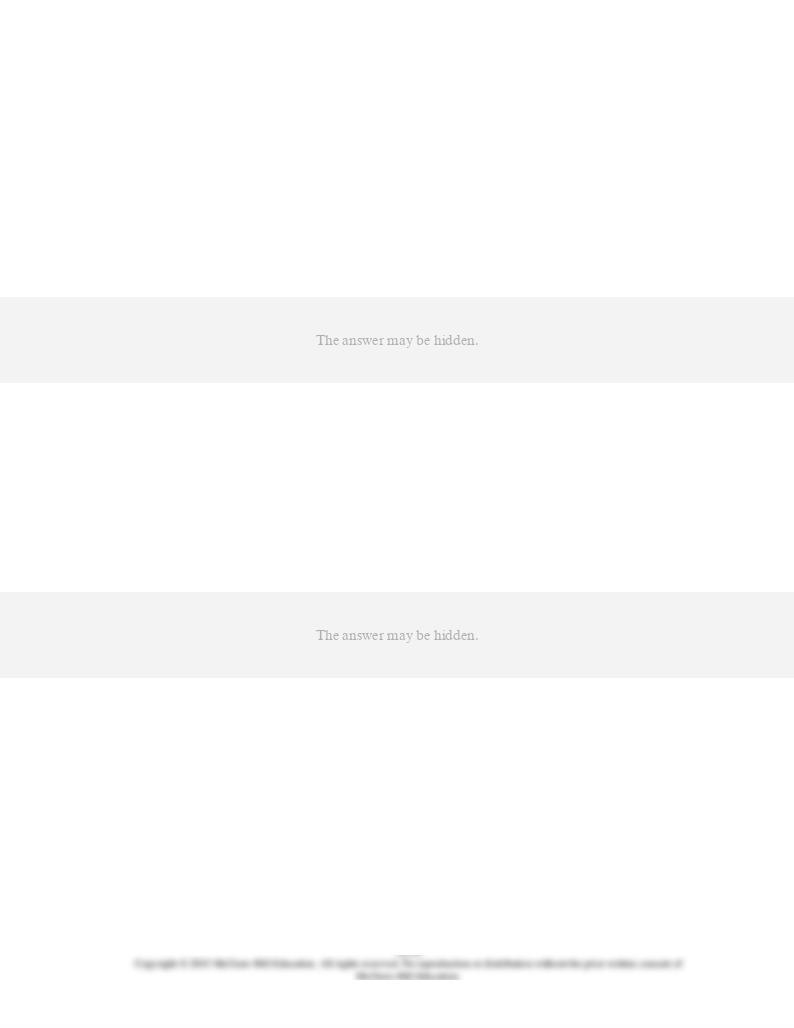
Chapter 34 Interest Rates and Monetary Policy Answer Key
Multiple Choice Questions
1.
The transactions demand for money is most closely related to money functioning as a:
AACSB: Reflective Thinking
Accessibility: Keyboard Navigation
Blooms: Understand
Difficulty: 2 Medium
Learning Objective: 34-01 Discuss how the equilibrium interest rate is determined in the market for money.
Topic: Interest rates
2.
The asset demand for money is most closely related to money functioning as a:
AACSB: Reflective Thinking
Accessibility: Keyboard Navigation
Blooms: Understand
Difficulty: 2 Medium
Learning Objective: 34-01 Discuss how the equilibrium interest rate is determined in the market for money.
Topic: Interest rates

3.
The desire to hold money for transactions purposes arises because:
AACSB: Reflective Thinking
Accessibility: Keyboard Navigation
Blooms: Understand
Difficulty: 2 Medium
Learning Objective: 34-01 Discuss how the equilibrium interest rate is determined in the market for money.
Topic: Interest rates
4.
The asset demand for money:
AACSB: Reflective Thinking
Accessibility: Keyboard Navigation
Blooms: Understand
Difficulty: 2 Medium
Learning Objective: 34-01 Discuss how the equilibrium interest rate is determined in the market for money.
Topic: Interest rates
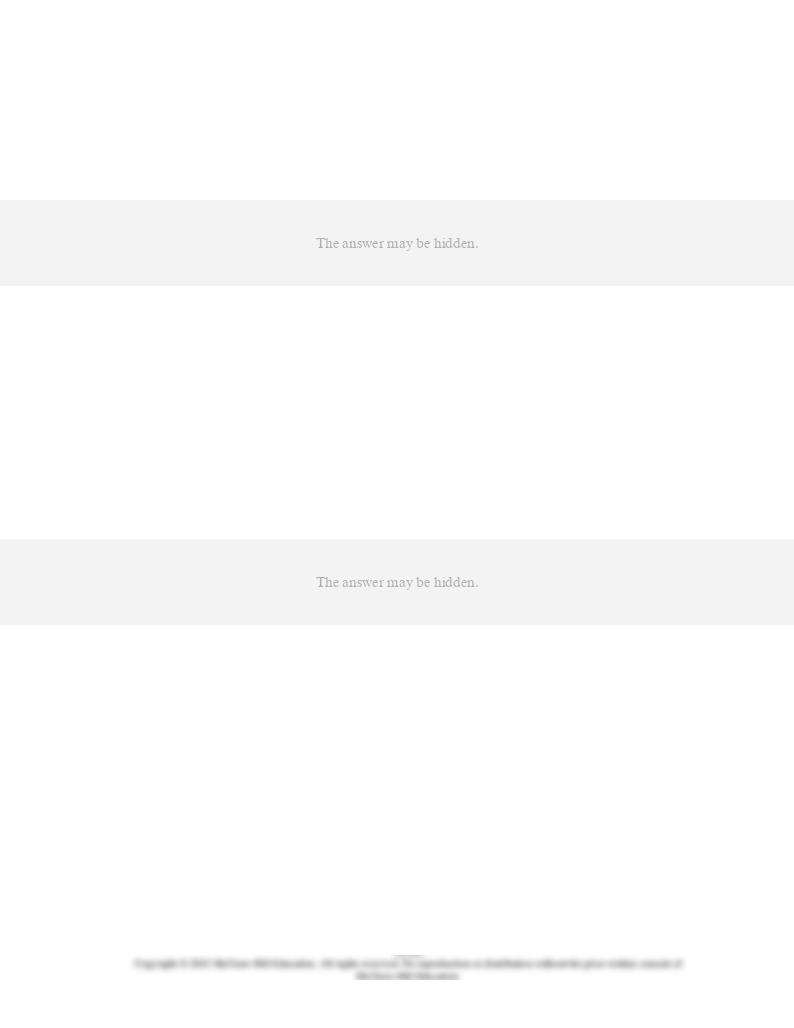
5.
On a diagram where the interest rate and the quantity of money demanded are shown on
the vertical and horizontal axes respectively, the transactions demand for money can be
represented by:
AACSB: Reflective Thinking
Accessibility: Keyboard Navigation
Blooms: Remember
Difficulty: 1 Easy
Learning Objective: 34-01 Discuss how the equilibrium interest rate is determined in the market for money.
Topic: Interest rates
6.
On a diagram where the interest rate and the quantity of money demanded are shown on
the vertical and horizontal axes respectively, the asset demand for money can be
represented by:
AACSB: Reflective Thinking
Accessibility: Keyboard Navigation
Blooms: Remember
Difficulty: 1 Easy
Learning Objective: 34-01 Discuss how the equilibrium interest rate is determined in the market for money.
Topic: Interest rates
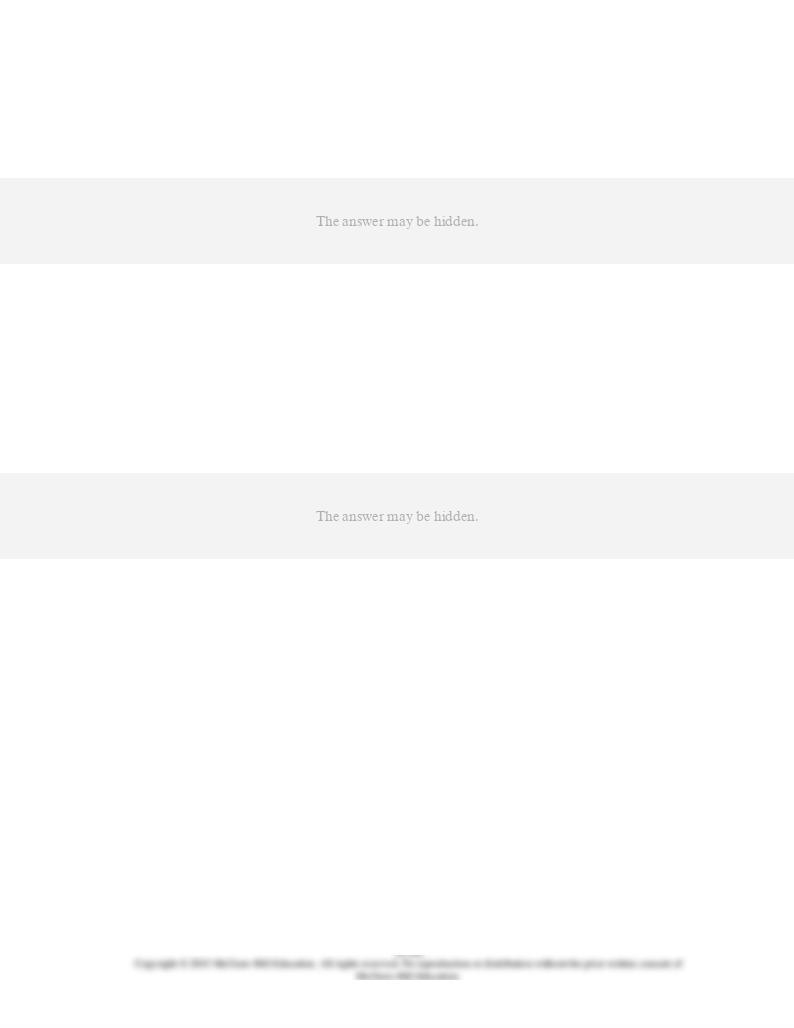
7.
On a diagram where the interest rate and the quantity of money demanded are shown on
the vertical and horizontal axes respectively, the total demand for money can be found by:
AACSB: Analytic
Accessibility: Keyboard Navigation
Blooms: Remember
Difficulty: 1 Easy
Learning Objective: 34-01 Discuss how the equilibrium interest rate is determined in the market for money.
Topic: Interest rates
8.
The total demand for money curve will shift to the right as a result of:
AACSB: Reflective Thinking
Accessibility: Keyboard Navigation
Blooms: Understand
Difficulty: 2 Medium
Learning Objective: 34-01 Discuss how the equilibrium interest rate is determined in the market for money.
Topic: Interest rates
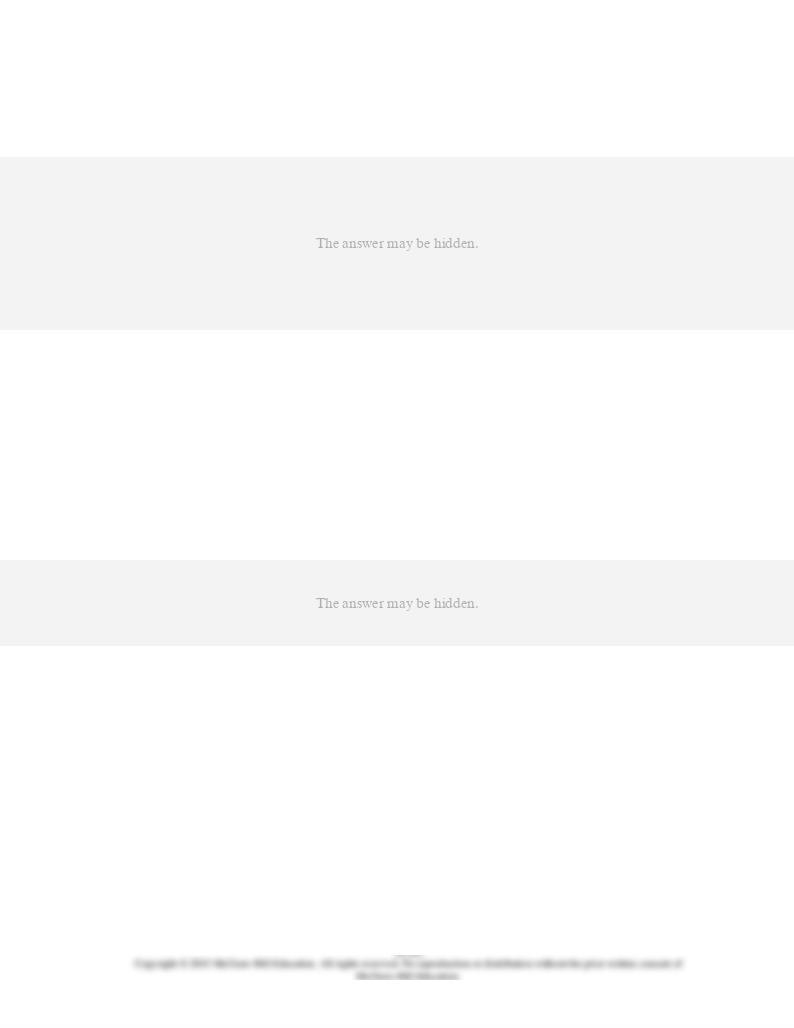
9.
Which of the following statements is correct? Other things equal:
AACSB: Reflective Thinking
Accessibility: Keyboard Navigation
Blooms: Analyze
Difficulty: 3 Hard
Learning Objective: 34-01 Discuss how the equilibrium interest rate is determined in the market for money.
Topic: Interest rates
10.
If nominal GDP is $600 billion and, on the average, each dollar is spent three times per
year, then the amount of money demanded for transactions purposes will be:
AACSB: Analytic
Accessibility: Keyboard Navigation
Blooms: Apply
Difficulty: 2 Medium
Learning Objective: 34-01 Discuss how the equilibrium interest rate is determined in the market for money.
Topic: Interest rates

11.
In which of the following situations is it certain that the quantity of money demanded by
the public will decrease?
AACSB: Reflective Thinking
Accessibility: Keyboard Navigation
Blooms: Analyze
Difficulty: 3 Hard
Learning Objective: 34-01 Discuss how the equilibrium interest rate is determined in the market for money.
Topic: Interest rates
12.
It is costly to hold money because:
AACSB: Reflective Thinking
Accessibility: Keyboard Navigation
Blooms: Understand
Difficulty: 2 Medium
Learning Objective: 34-01 Discuss how the equilibrium interest rate is determined in the market for money.
Topic: Interest rates
13.
An increase in nominal GDP increases the demand for money because:
AACSB: Reflective Thinking
Accessibility: Keyboard Navigation
Blooms: Understand
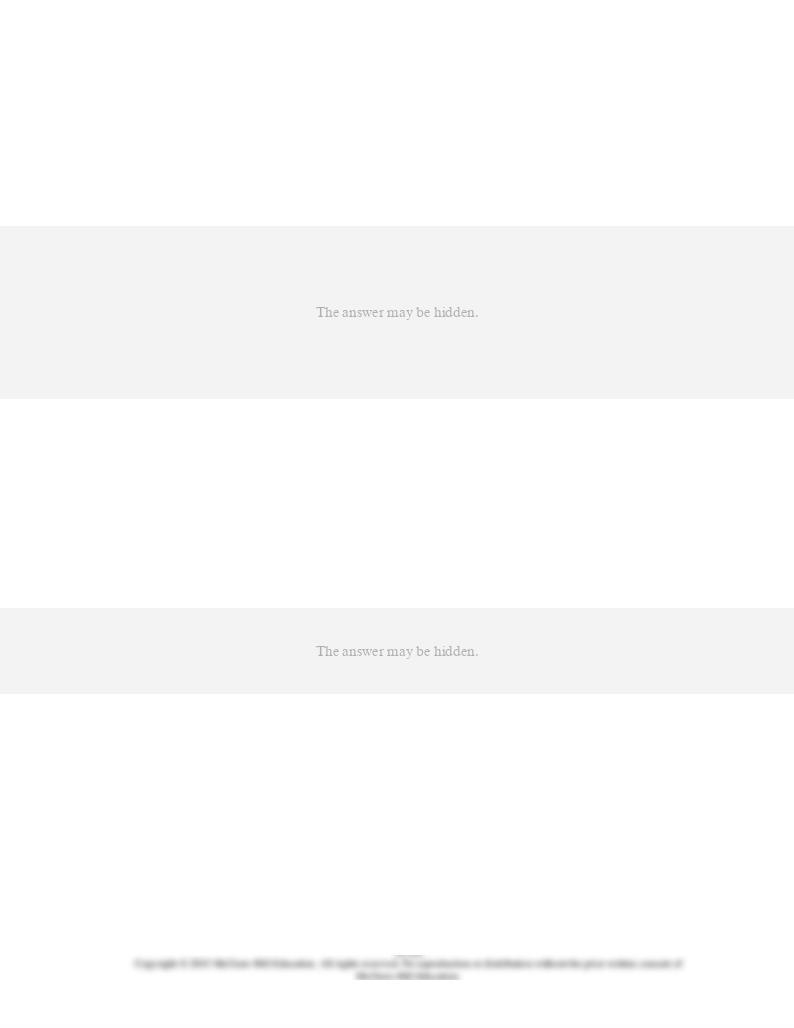
Difficulty: 2 Medium
Learning Objective: 34-01 Discuss how the equilibrium interest rate is determined in the market for money.
Topic: Interest rates
14.
Which of the following is
correct
?
AACSB: Reflective Thinking
Accessibility: Keyboard Navigation
Blooms: Understand
Difficulty: 2 Medium
Learning Objective: 34-01 Discuss how the equilibrium interest rate is determined in the market for money.
Topic: Interest rates
15.
The opportunity cost of holding money:
AACSB: Reflective Thinking
Accessibility: Keyboard Navigation
Blooms: Understand
Difficulty: 2 Medium
Learning Objective: 34-01 Discuss how the equilibrium interest rate is determined in the market for money.
Topic: Interest rates
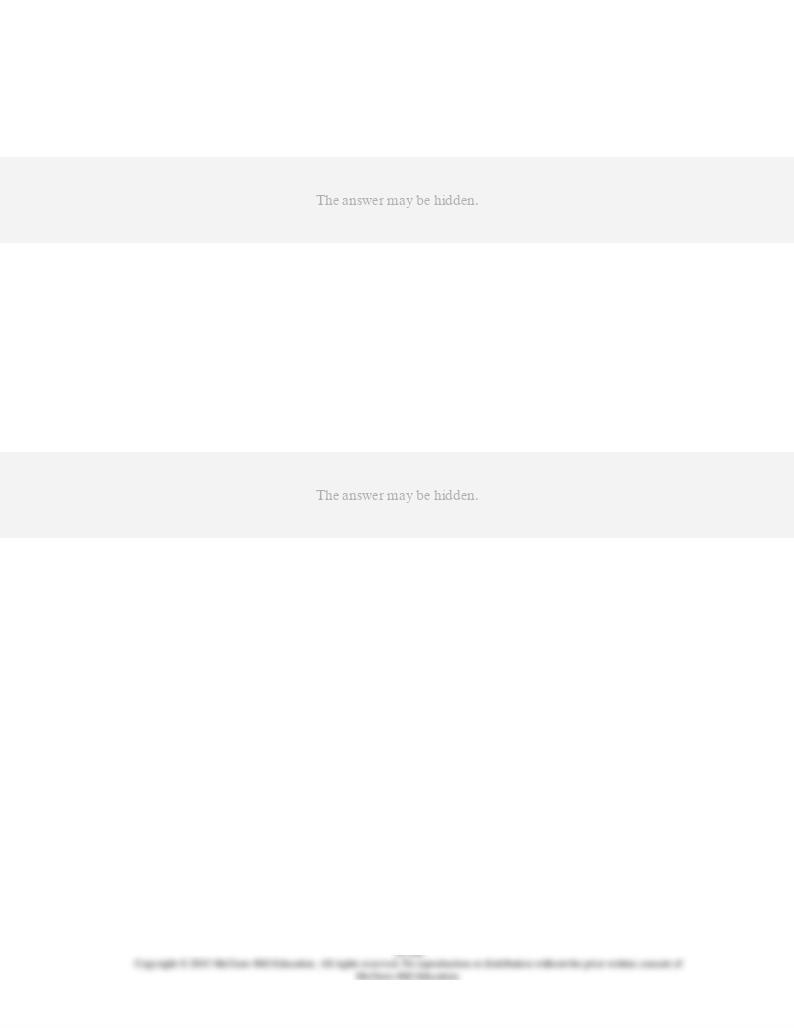
16.
The total demand for money will shift to the left as a result of:
AACSB: Reflective Thinking
Accessibility: Keyboard Navigation
Blooms: Analyze
Difficulty: 3 Hard
Learning Objective: 34-01 Discuss how the equilibrium interest rate is determined in the market for money.
Topic: Interest rates
17.
The asset demand for money is downsloping because:
AACSB: Reflective Thinking
Accessibility: Keyboard Navigation
Blooms: Understand
Difficulty: 2 Medium
Learning Objective: 34-01 Discuss how the equilibrium interest rate is determined in the market for money.
Topic: Interest rates
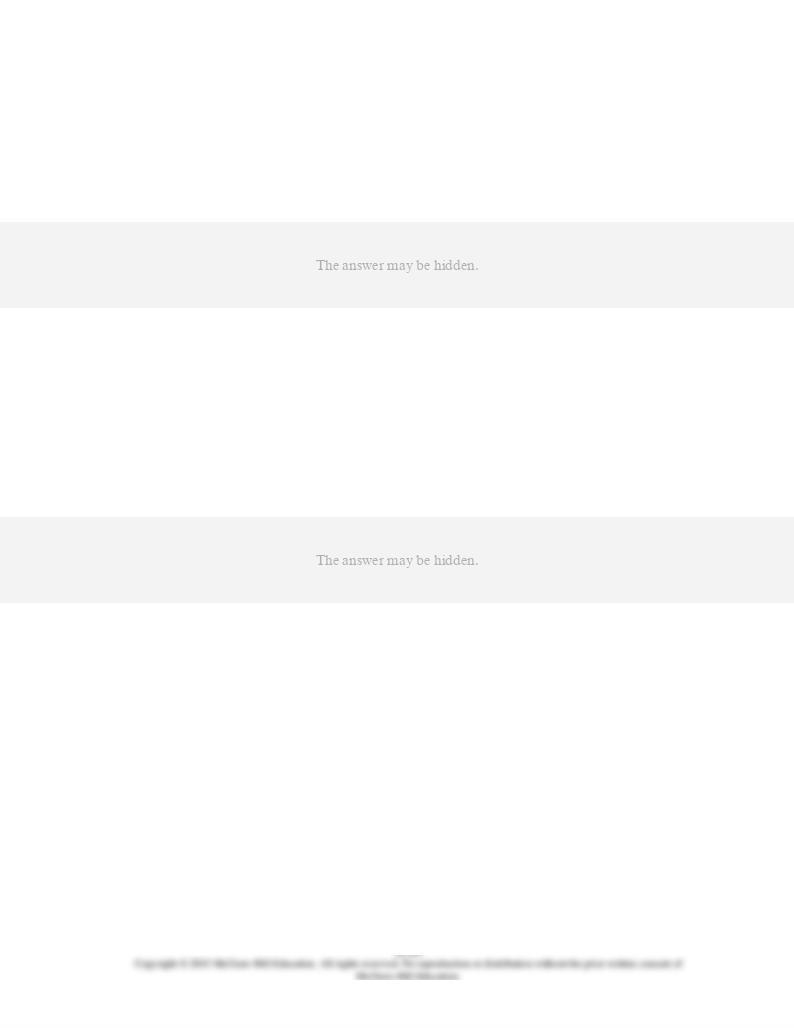
18.
(Advanced analysis) Assume the equation for the total demand for money is
L
= 0.4
Y
+ 80
- 4
i
, where
L
is the amount of money demanded,
Y
is gross domestic product, and
i
is the
interest rate. If gross domestic product is $200 and the interest rate is 10 (percent), what
amount of money will society want to hold?
AACSB: Analytic
Accessibility: Keyboard Navigation
Blooms: Apply
Difficulty: 2 Medium
Learning Objective: 34-01 Discuss how the equilibrium interest rate is determined in the market for money.
Topic: Interest rates
19.
If the quantity of money demanded exceeds the quantity supplied:
AACSB: Reflective Thinking
Accessibility: Keyboard Navigation
Blooms: Understand
Difficulty: 2 Medium
Learning Objective: 34-01 Discuss how the equilibrium interest rate is determined in the market for money.
Topic: Interest rates
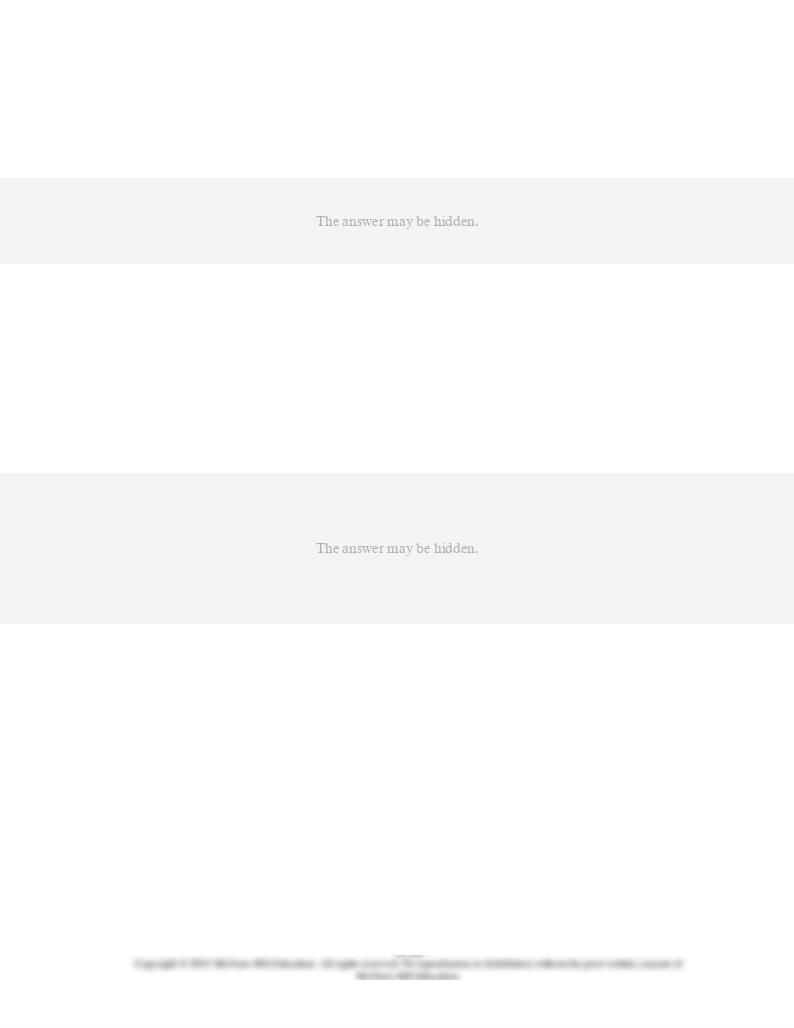
20.
The equilibrium rate of interest in the market for money is determined by the intersection
of the:
AACSB: Analytic
Accessibility: Keyboard Navigation
Blooms: Remember
Difficulty: 1 Easy
Learning Objective: 34-01 Discuss how the equilibrium interest rate is determined in the market for money.
Topic: Interest rates
21.
If the demand for money and the supply of money both decrease, the equilibrium:
AACSB: Reflective Thinking
Accessibility: Keyboard Navigation
Blooms: Analyze
Difficulty: 3 Hard
Learning Objective: 34-01 Discuss how the equilibrium interest rate is determined in the market for money.
Topic: Interest rates
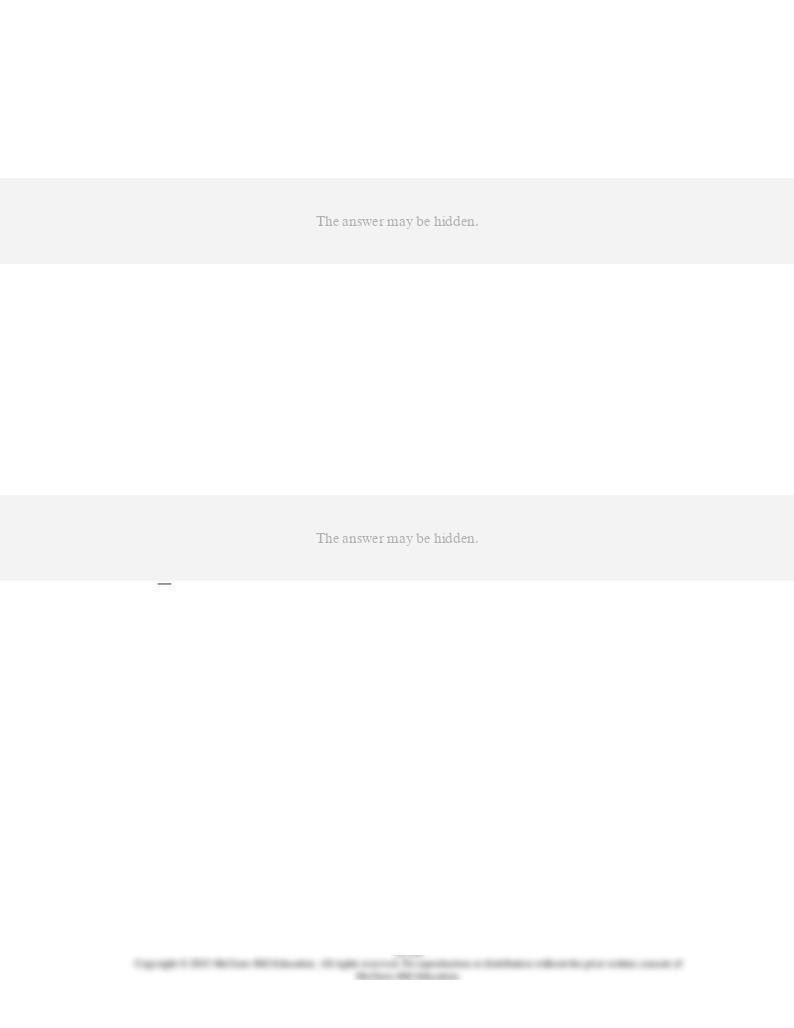
22.
If, in the market for money, the quantity of money demanded exceeds the money supply,
the interest rate will:
AACSB: Reflective Thinking
Accessibility: Keyboard Navigation
Blooms: Analyze
Difficulty: 3 Hard
Learning Objective: 34-01 Discuss how the equilibrium interest rate is determined in the market for money.
Topic: Interest rates
23.
If, in the market for money, the amount of money supplied exceeds the amount of money
households and businesses want to hold, the interest rate will:
AACSB: Reflective Thinking
Accessibility: Keyboard Navigation
Blooms: Analyze
Difficulty: 3 Hard
Learning Objective: 34-01 Discuss how the equilibrium interest rate is determined in the market for money.
Topic: Interest rates
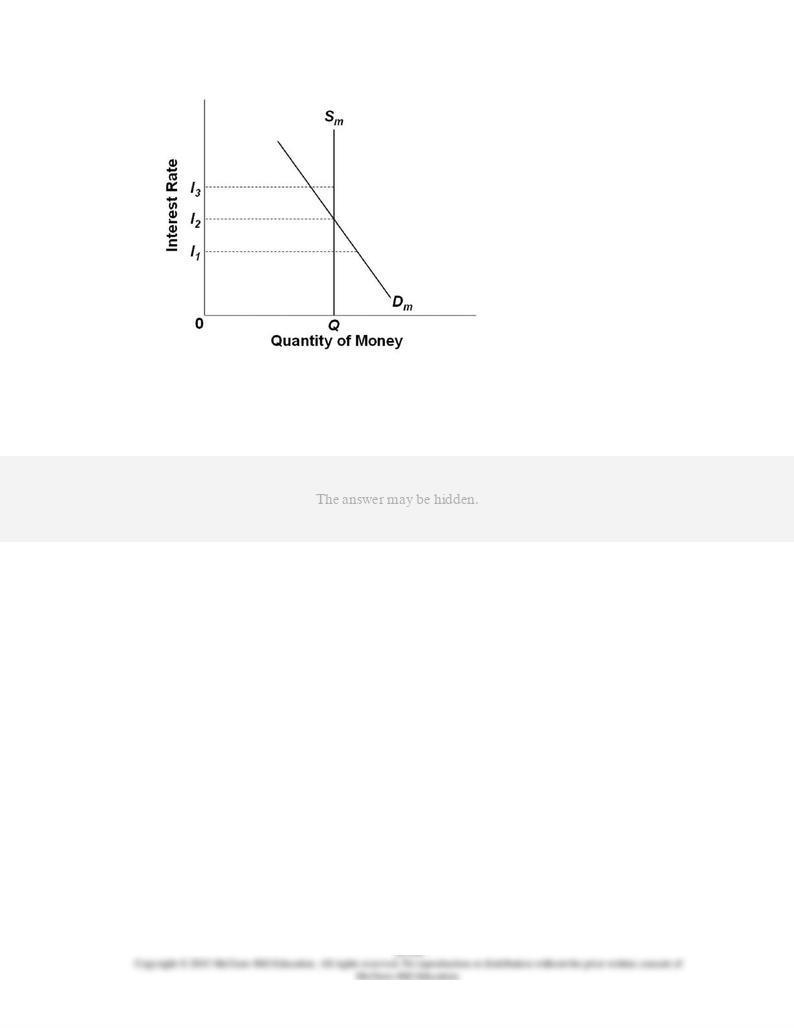
24.
Refer to the diagram of the market for money. The downward slope of the money demand
curve
Dm
is best explained in terms of the:
AACSB: Reflective Thinking
Blooms: Understand
Difficulty: 2 Medium
Learning Objective: 34-01 Discuss how the equilibrium interest rate is determined in the market for money.
Topic: Interest rates
Type: Graph
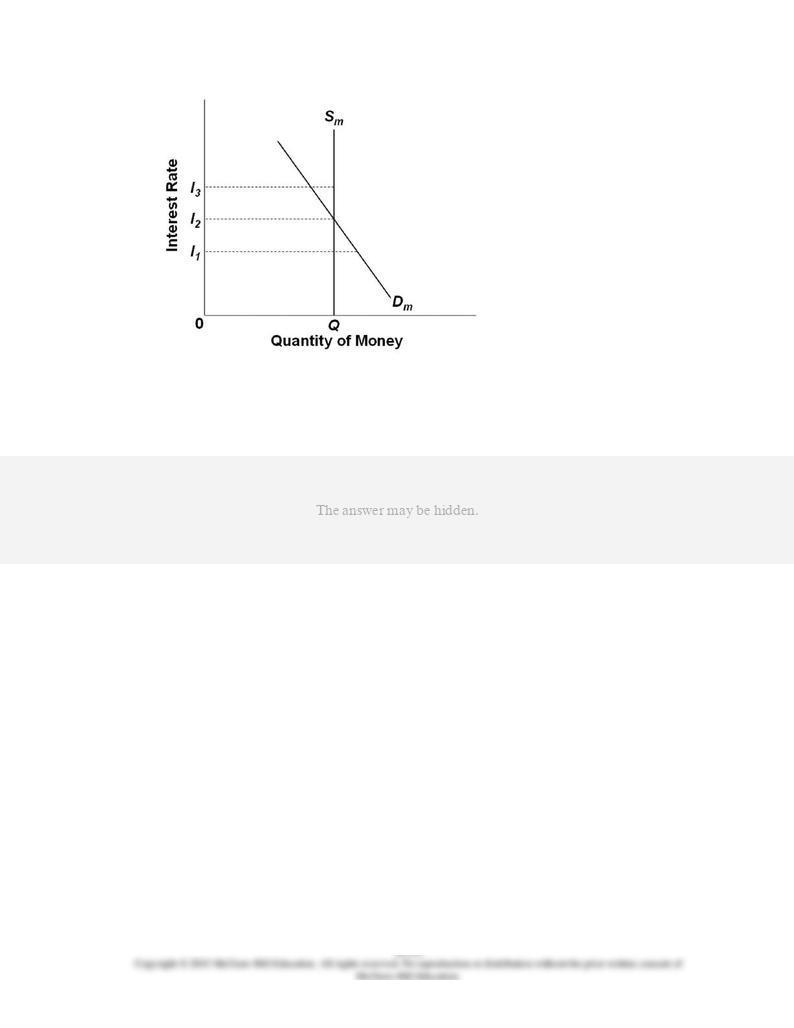
25.
Refer to the diagram of the market for money. The vertical money supply curve
Sm
reflects
the fact that:
AACSB: Reflective Thinking
Blooms: Understand
Difficulty: 2 Medium
Learning Objective: 34-01 Discuss how the equilibrium interest rate is determined in the market for money.
Topic: Interest rates
Type: Graph
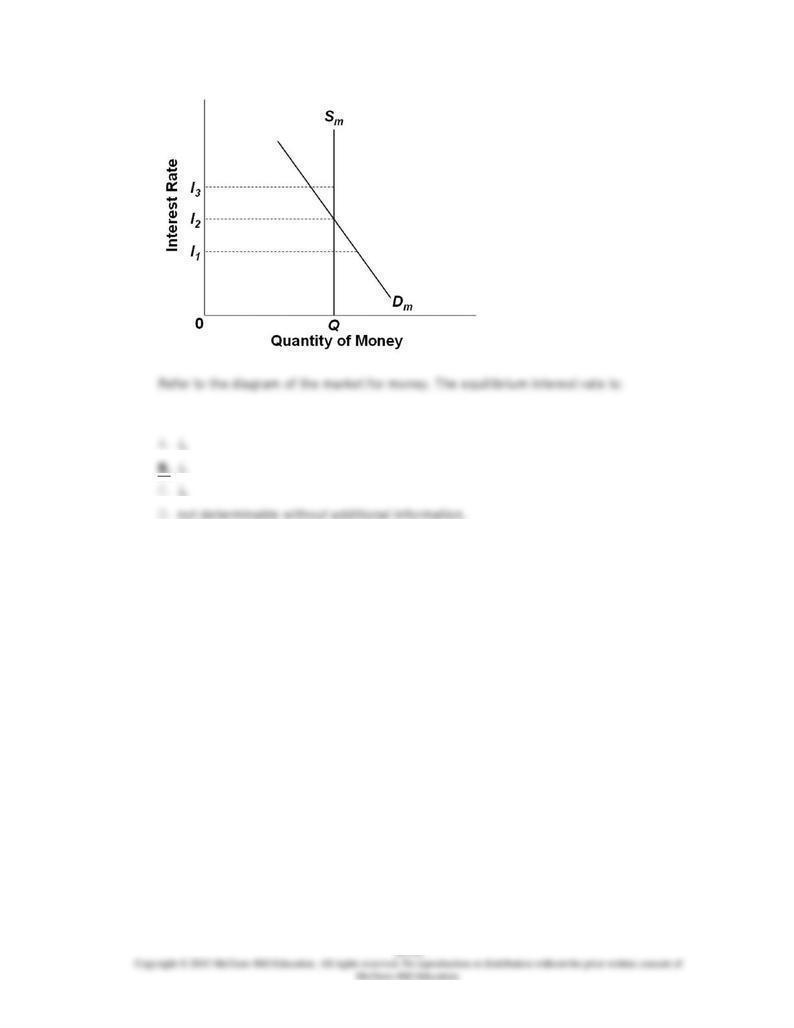
26.
1.
2.
3.
AACSB: Reflective Thinking
Blooms: Analyze
Difficulty: 3 Hard
Learning Objective: 34-01 Discuss how the equilibrium interest rate is determined in the market for money.
Topic: Interest rates
Type: Graph
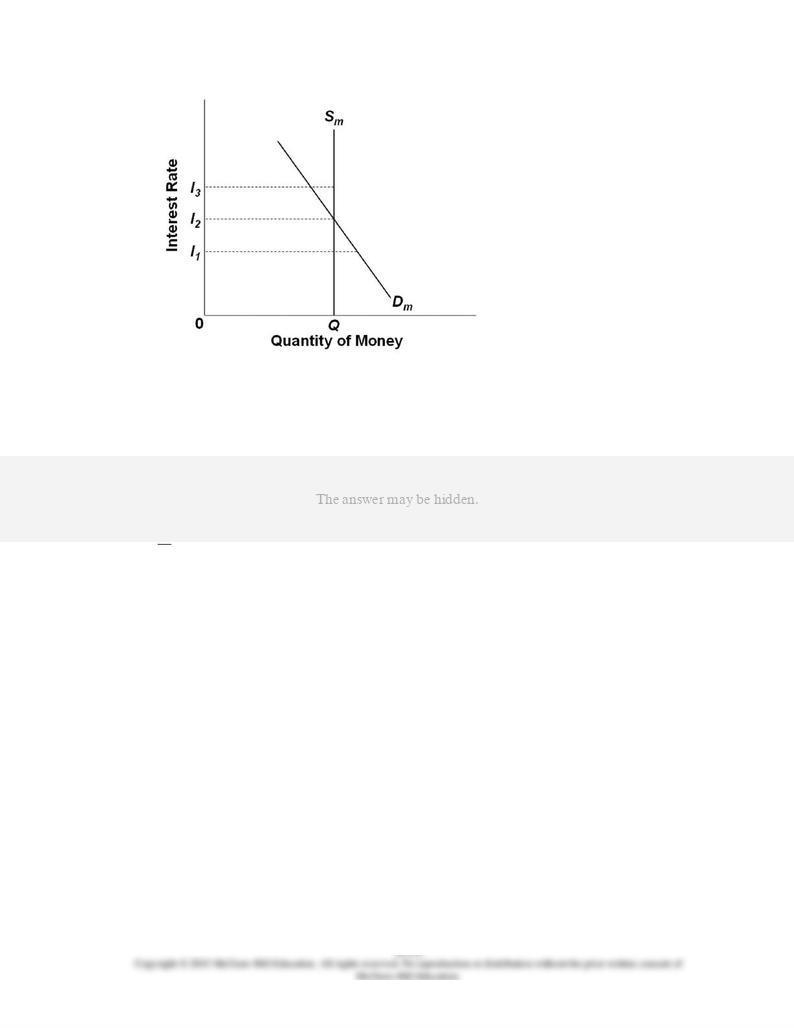
27.
Refer to the diagram of the market for money. Given
Dm
and
Sm
, an interest rate of
i3
is not
sustainable because the:
AACSB: Reflective Thinking
Blooms: Analyze
Difficulty: 3 Hard
Learning Objective: 34-01 Discuss how the equilibrium interest rate is determined in the market for money.
Topic: Interest rates
Type: Graph
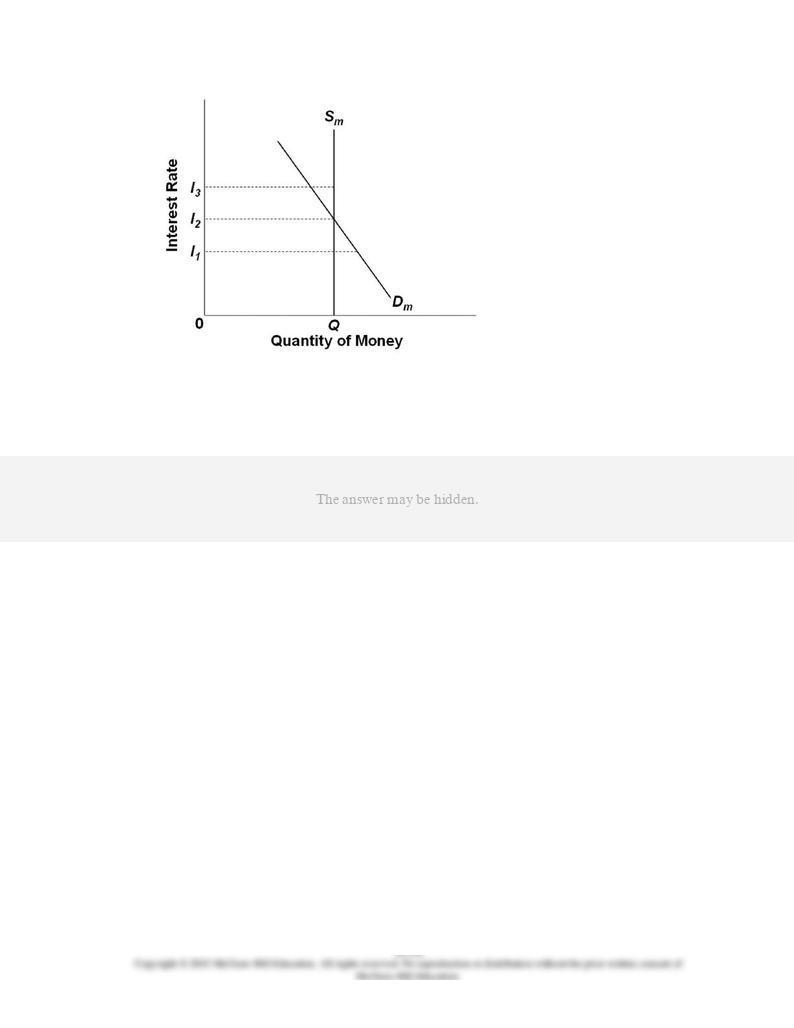
28.
Refer to the diagram of the market for money. Other things equal, the money demand
curve in the diagram would shift leftward if:
AACSB: Reflective Thinking
Blooms: Apply
Difficulty: 2 Medium
Learning Objective: 34-01 Discuss how the equilibrium interest rate is determined in the market for money.
Topic: Interest rates
Type: Graph
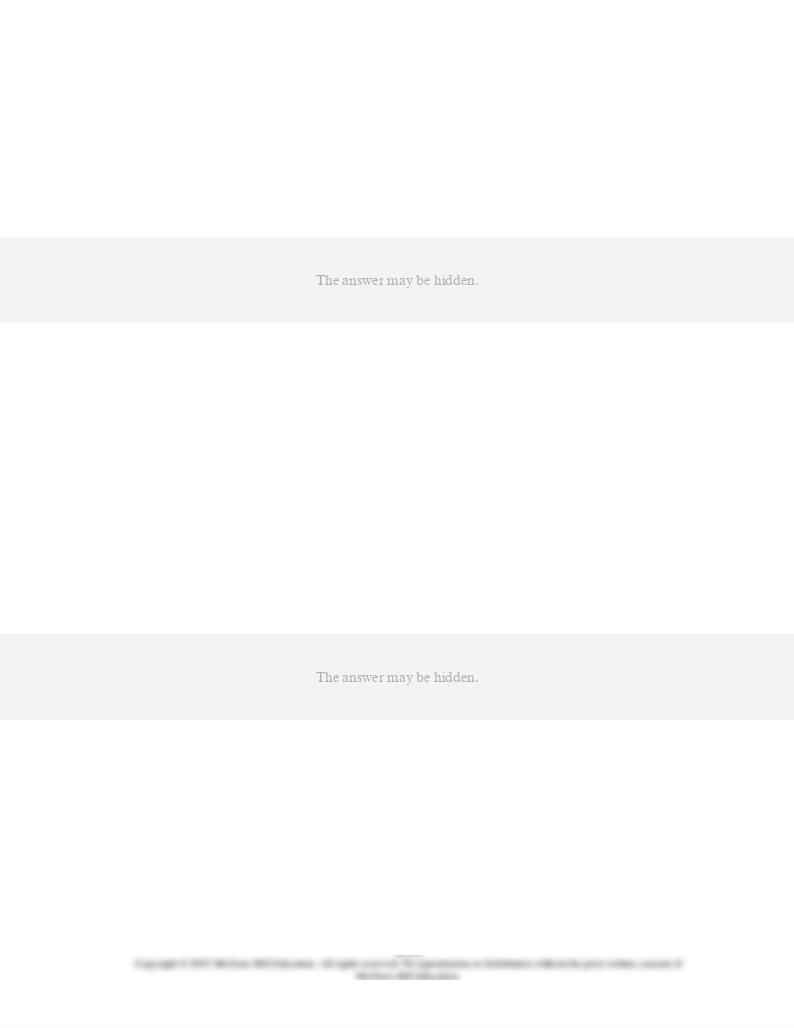
29.
Answer the question on the basis of the following information for a bond having no
expiration date: bond price = $1,000; bond fixed annual interest payment = $100; bond
annual interest rate = 10 percent.
Refer to the given information. If the price of this bond falls by $200, the interest rate will:
AACSB: Analytic
Accessibility: Keyboard Navigation
Blooms: Apply
Difficulty: 2 Medium
Learning Objective: 34-01 Discuss how the equilibrium interest rate is determined in the market for money.
Topic: Interest rates
30.
Answer the question on the basis of the following information for a bond having no
expiration date: bond price = $1,000; bond fixed annual interest payment = $100; bond
annual interest rate = 10 percent.
Refer to the given information. If the price of this bond increases to $1,250, the interest
rate will:
AACSB: Analytic
Accessibility: Keyboard Navigation
Blooms: Apply
Difficulty: 2 Medium
Learning Objective: 34-01 Discuss how the equilibrium interest rate is determined in the market for money.
Topic: Interest rates
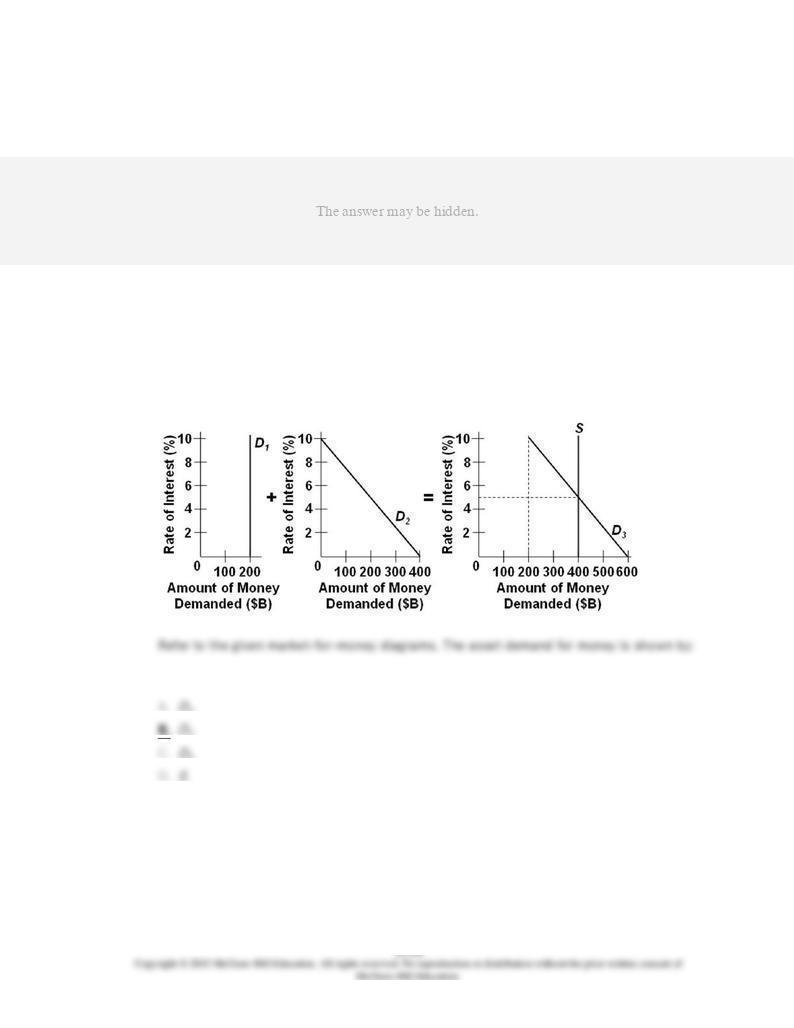
31.
Which of the following statements is
correct
?
AACSB: Reflective Thinking
Accessibility: Keyboard Navigation
Blooms: Understand
Difficulty: 2 Medium
Learning Objective: 34-01 Discuss how the equilibrium interest rate is determined in the market for money.
Topic: Interest rates
32.
1.
2.
3.
AACSB: Reflective Thinking
Blooms: Apply
Difficulty: 2 Medium
Learning Objective: 34-01 Discuss how the equilibrium interest rate is determined in the market for money.
Topic: Interest rates
Type: Graph

33.
Refer to the given market-for-money diagrams. Curve
D
1 represents the:
AACSB: Reflective Thinking
Blooms: Apply
Difficulty: 2 Medium
Learning Objective: 34-01 Discuss how the equilibrium interest rate is determined in the market for money.
Topic: Interest rates
Type: Graph

34.
1.
2.
3.
AACSB: Reflective Thinking
Blooms: Apply
Difficulty: 2 Medium
Learning Objective: 34-01 Discuss how the equilibrium interest rate is determined in the market for money.
Topic: Interest rates
Type: Graph
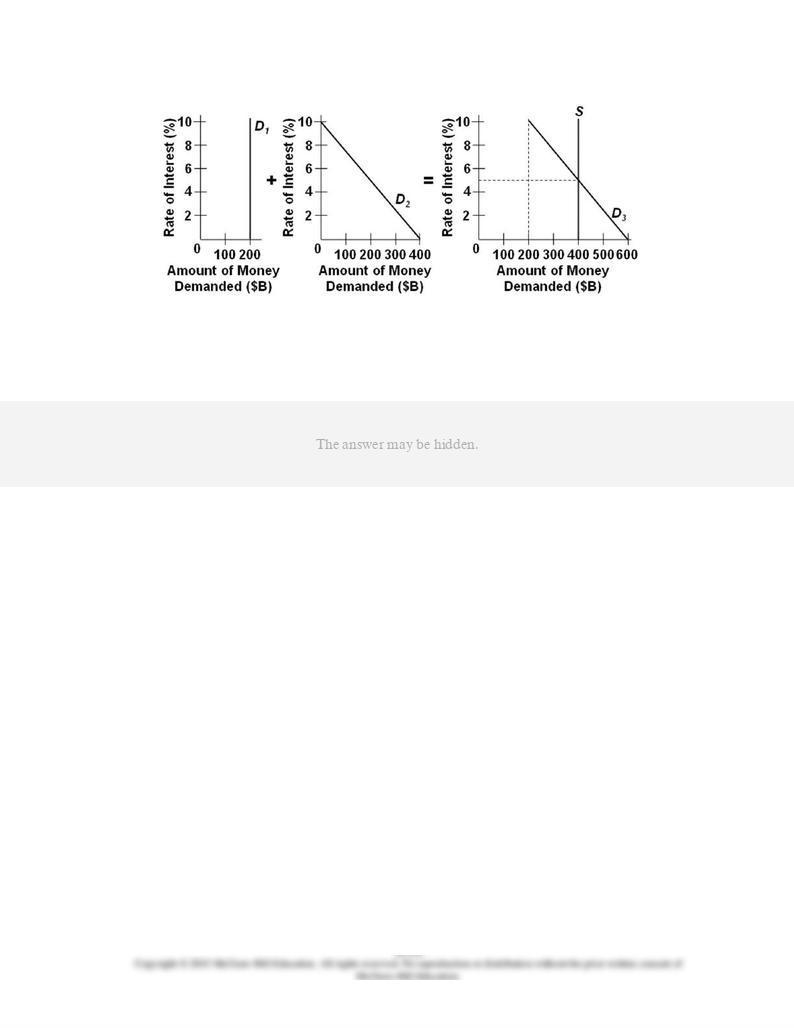
35.
Refer to the given market-for-money diagrams. If each dollar held for transactions is spent
four times per year on the average, we can infer that the:
AACSB: Analytic
Blooms: Apply
Difficulty: 2 Medium
Learning Objective: 34-01 Discuss how the equilibrium interest rate is determined in the market for money.
Topic: Interest rates
Type: Graph
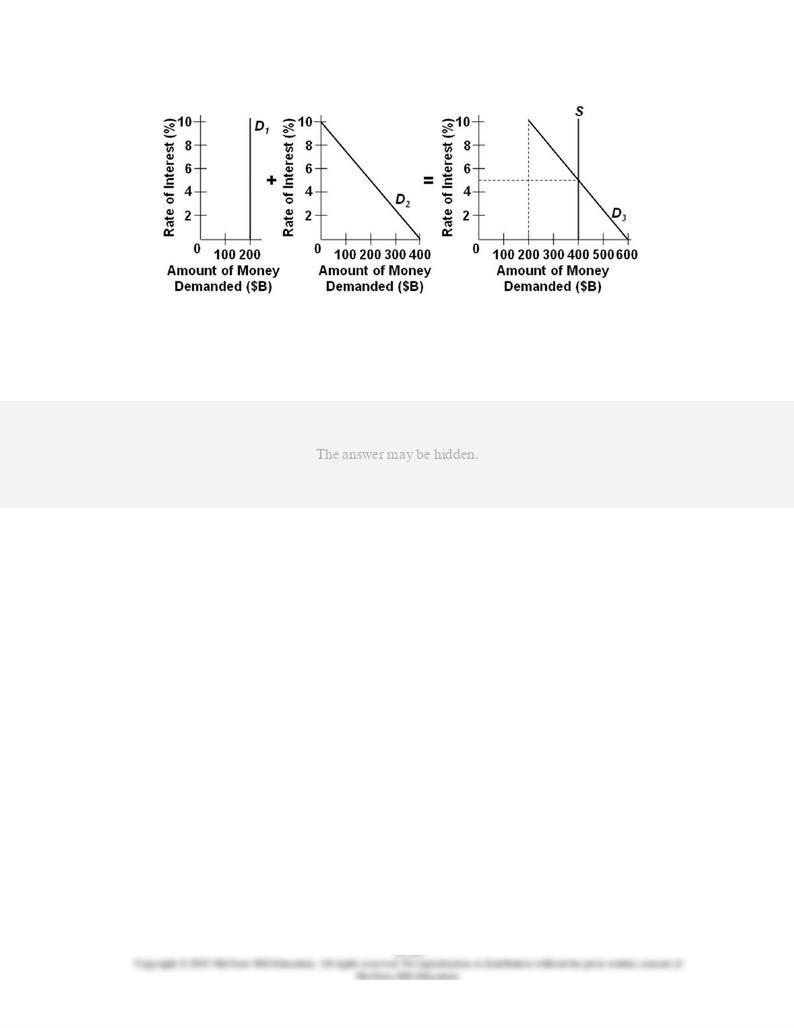
36.
Refer to the given market-for-money diagrams. If the interest rate was at 3 percent,
people would:
AACSB: Reflective Thinking
Blooms: Analyze
Difficulty: 3 Hard
Learning Objective: 34-01 Discuss how the equilibrium interest rate is determined in the market for money.
Topic: Interest rates
Type: Graph

37.
Refer to the given market-for-money diagrams. If the interest rate was at 8 percent,
people would:
AACSB: Reflective Thinking
Blooms: Analyze
Difficulty: 3 Hard
Learning Objective: 34-01 Discuss how the equilibrium interest rate is determined in the market for money.
Topic: Interest rates
Type: Graph

38.
Refer to the given market-for-money diagrams. If the Federal Reserve increased the stock
of money, the:
AACSB: Reflective Thinking
Blooms: Analyze
Difficulty: 3 Hard
Learning Objective: 34-01 Discuss how the equilibrium interest rate is determined in the market for money.
Topic: Interest rates
Type: Graph
39.
Suppose the demand for money and the supply of money increase simultaneously. We
can:
AACSB: Reflective Thinking
Accessibility: Keyboard Navigation
Blooms: Analyze
Difficulty: 3 Hard
Learning Objective: 34-01 Discuss how the equilibrium interest rate is determined in the market for money.
Topic: Interest rates
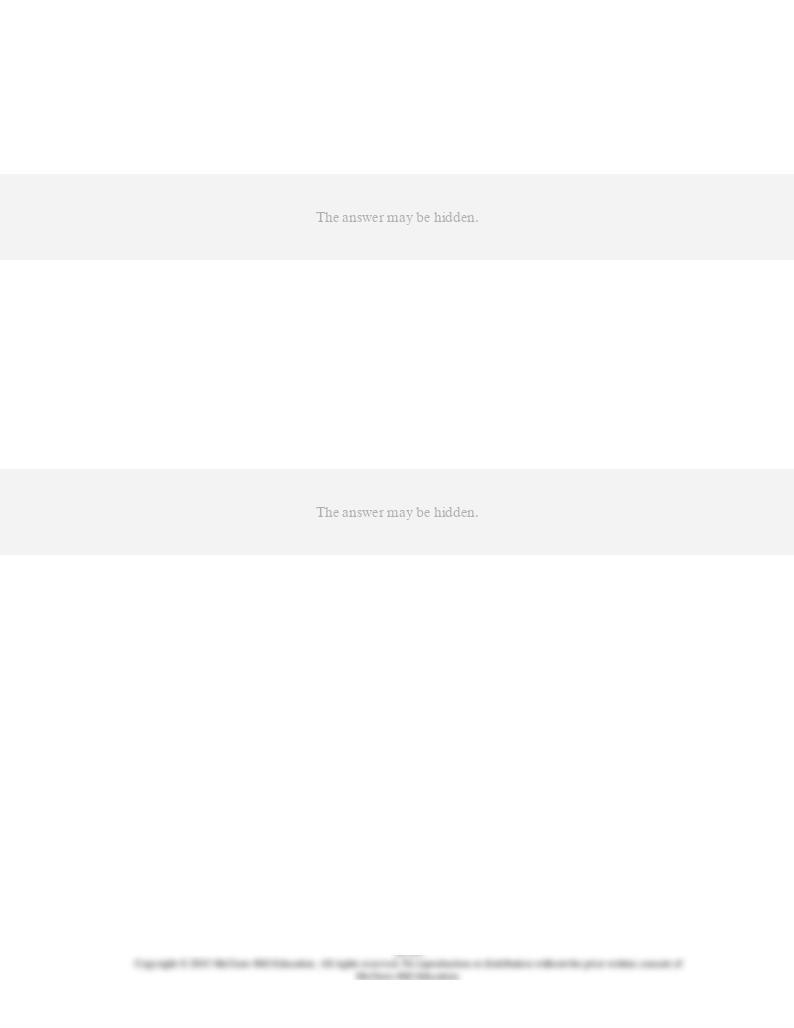
40.
Other things equal, if there is an increase in nominal GDP:
AACSB: Reflective Thinking
Accessibility: Keyboard Navigation
Blooms: Analyze
Difficulty: 3 Hard
Learning Objective: 34-01 Discuss how the equilibrium interest rate is determined in the market for money.
Topic: Interest rates
41.
Other things equal, if the supply of money is reduced:
AACSB: Reflective Thinking
Accessibility: Keyboard Navigation
Blooms: Analyze
Difficulty: 3 Hard
Learning Objective: 34-01 Discuss how the equilibrium interest rate is determined in the market for money.
Topic: Interest rates

42.
Answer the question on the basis of the following table in which columns (1) and (2)
indicate the transactions demand (
Dt
) for money and columns (1) and (3) show the asset
demand (
Da
) for money:
The given data suggest that the amount of money demanded for transactions:
AACSB: Analytic
Blooms: Apply
Difficulty: 2 Medium
Learning Objective: 34-01 Discuss how the equilibrium interest rate is determined in the market for money.
Topic: Interest rates
Type: Table
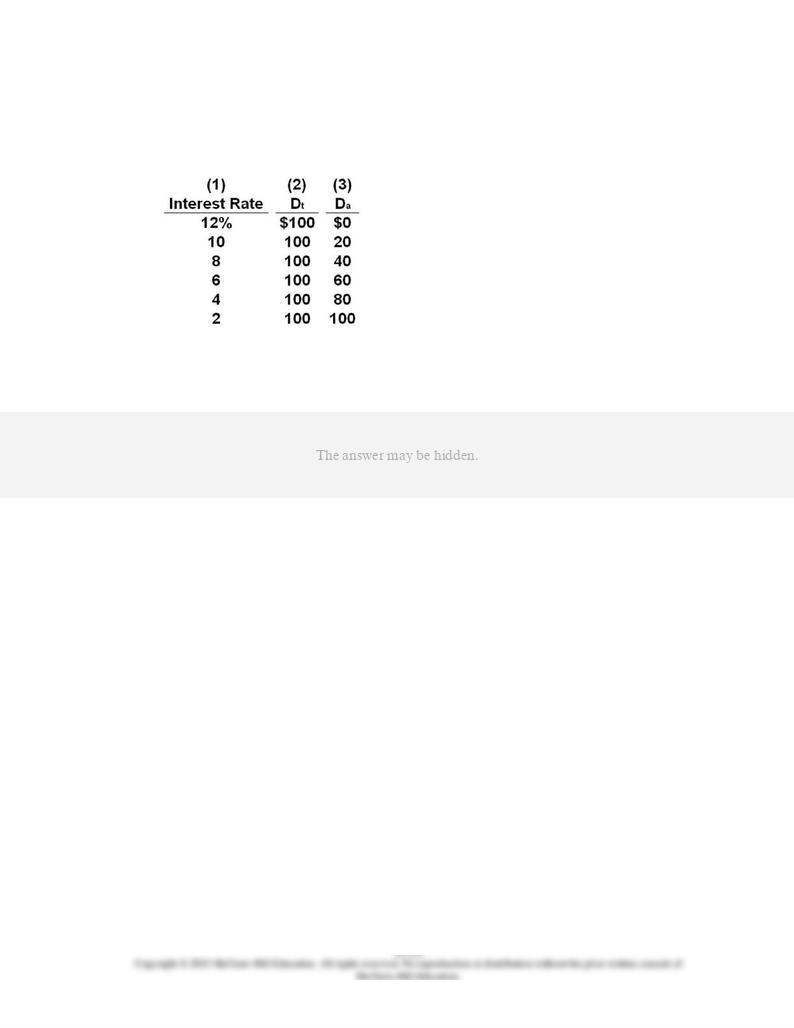
43.
Answer the question on the basis of the following table in which columns (1) and (2)
indicate the transactions demand (
Dt
) for money and columns (1) and (3) show the asset
demand (
Da
) for money:
The given data suggest that the amount of money that society wishes to hold as an asset:
AACSB: Analytic
Blooms: Apply
Difficulty: 2 Medium
Learning Objective: 34-01 Discuss how the equilibrium interest rate is determined in the market for money.
Topic: Interest rates
Type: Table

44.
Answer the question on the basis of the following table in which columns (1) and (2)
indicate the transactions demand (
Dt
) for money and columns (1) and (3) show the asset
demand (
Da
) for money:
Refer to the given data. If the money supply is $160, the equilibrium interest rate will be:
AACSB: Analytic
Blooms: Analyze
Difficulty: 3 Hard
Learning Objective: 34-01 Discuss how the equilibrium interest rate is determined in the market for money.
Topic: Interest rates
Type: Table
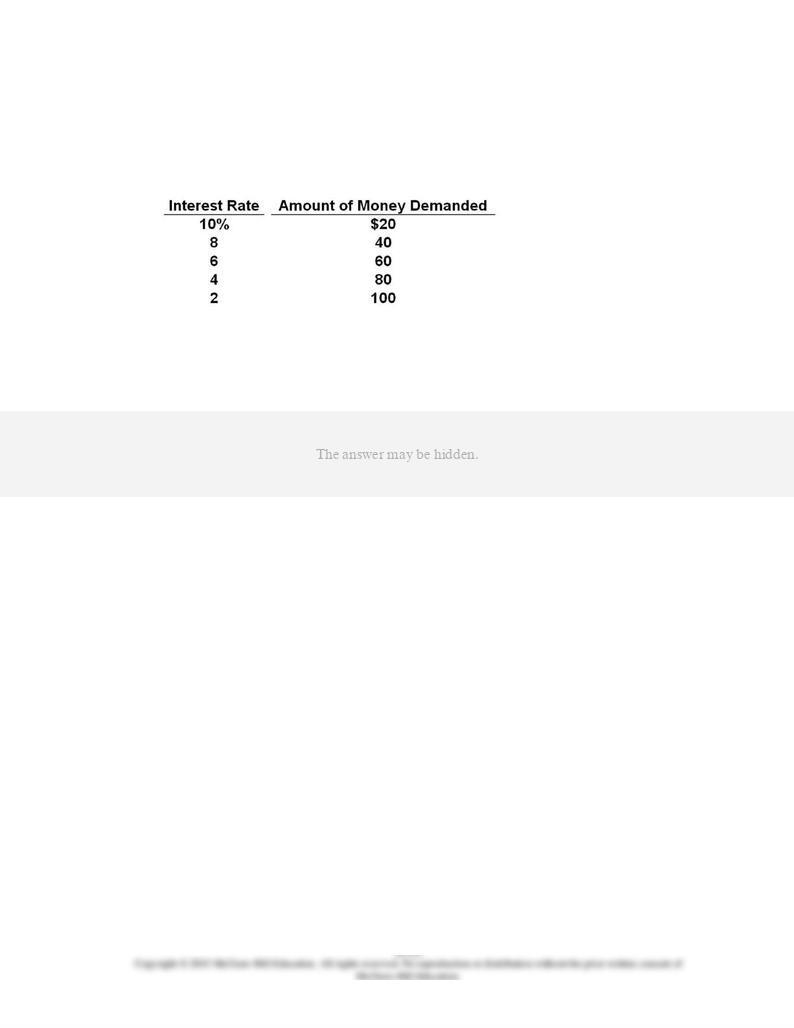
45.
Answer the question on the basis of the following information. For transactions,
households and businesses want to hold an amount of money equal to one-half of nominal
GDP. The table shows the amounts of money they want to hold as an asset at various
interest rates.
Refer to the given information. If nominal GDP is $200 and the interest rate is 6 percent,
the total amount of money that households and businesses will want to hold is:
AACSB: Analytic
Blooms: Apply
Difficulty: 2 Medium
Learning Objective: 34-01 Discuss how the equilibrium interest rate is determined in the market for money.
Topic: Interest rates
Type: Table
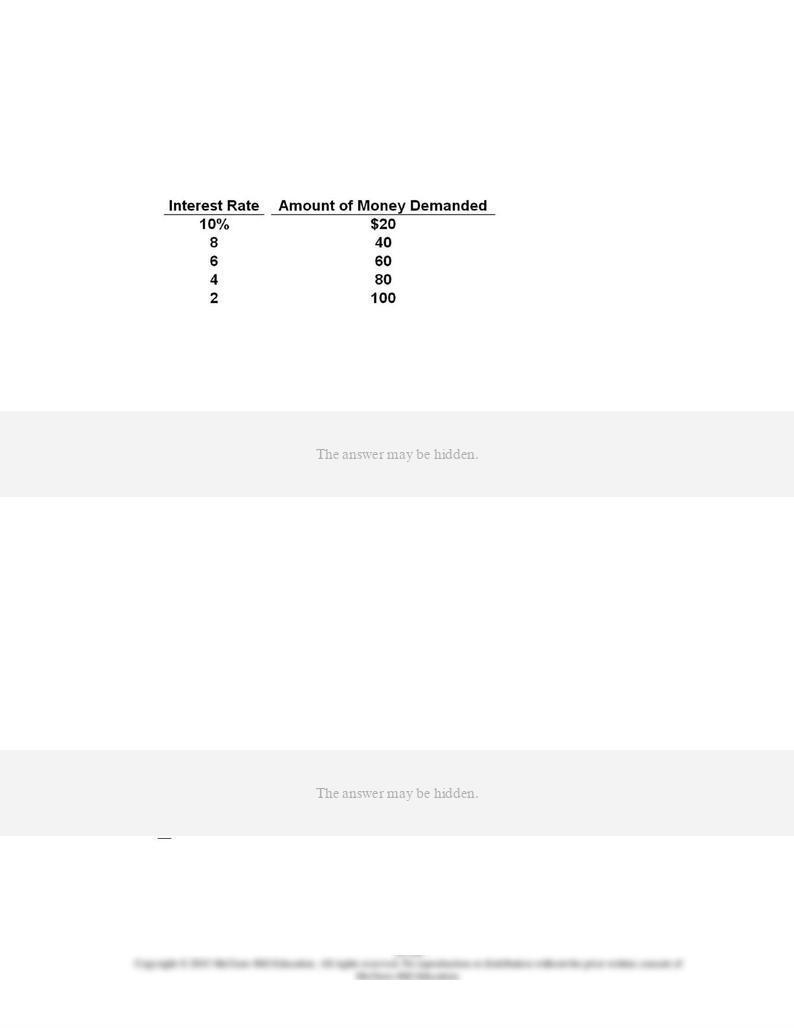
46.
Answer the question on the basis of the following information. For transactions,
households and businesses want to hold an amount of money equal to one-half of nominal
GDP. The table shows the amounts of money they want to hold as an asset at various
interest rates.
Refer to the given information. If nominal GDP is $300 and the supply of money is $230,
the equilibrium interest rate will be:
AACSB: Analytic
Blooms: Analyze
Difficulty: 3 Hard
Learning Objective: 34-01 Discuss how the equilibrium interest rate is determined in the market for money.
Topic: Interest rates
Type: Table
47.
The price of a bond having no expiration date is originally $8,000 and has a fixed annual
interest payment of $800. A fall in the price of the bond by $3,000 will provide a new buyer
of the bond an interest rate of:
AACSB: Analytic
Accessibility: Keyboard Navigation
Blooms: Apply
Difficulty: 2 Medium
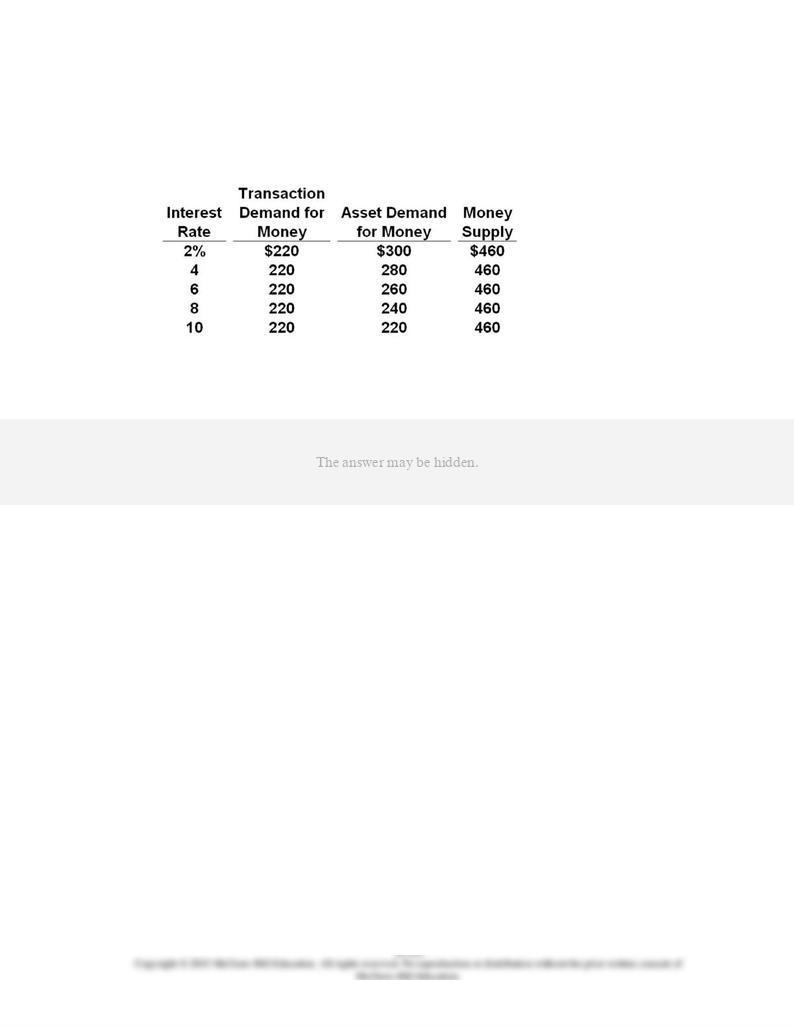
Learning Objective: 34-01 Discuss how the equilibrium interest rate is determined in the market for money.
Topic: Interest rates
48.
Answer the question on the basis of the following table:
At equilibrium in the given market for money, the total amount of money demanded is:
AACSB: Analytic
Blooms: Analyze
Difficulty: 3 Hard
Learning Objective: 34-01 Discuss how the equilibrium interest rate is determined in the market for money.
Topic: Interest rates
Type: Table
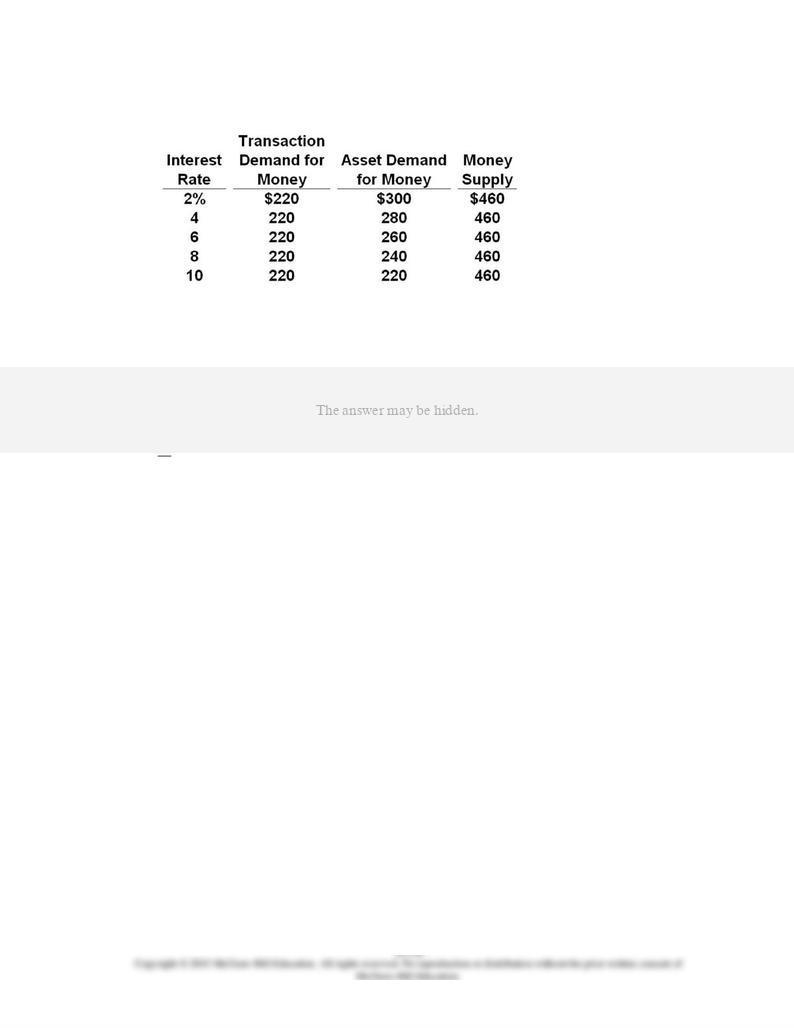
49.
Answer the question on the basis of the following table:
Refer to the given table. The equilibrium interest rate is:
AACSB: Analytic
Blooms: Analyze
Difficulty: 3 Hard
Learning Objective: 34-01 Discuss how the equilibrium interest rate is determined in the market for money.
Topic: Interest rates
Type: Table
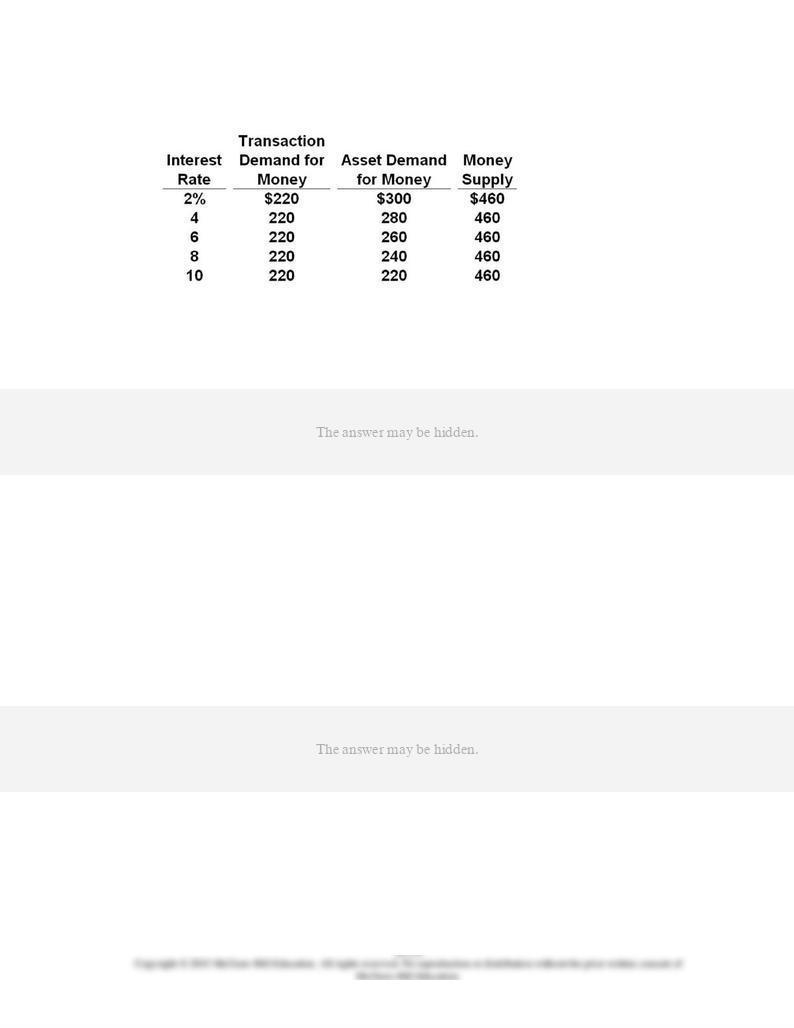
50.
Answer the question on the basis of the following table:
Refer to the given table. An increase in the money supply of $20 billion will cause the
equilibrium interest rate to:
AACSB: Analytic
Blooms: Analyze
Difficulty: 3 Hard
Learning Objective: 34-01 Discuss how the equilibrium interest rate is determined in the market for money.
Topic: Interest rates
Type: Table
51.
Which of the following is an asset on the consolidated balance sheet of the Federal
Reserve Banks?
AACSB: Analytic
Accessibility: Keyboard Navigation
Blooms: Remember
Difficulty: 1 Easy
Learning Objective: 34-02 Describe the balance sheet of the Federal Reserve and the meaning of its major items.
Topic: Consolidated balance sheet of the Federal Reserve Banks

52.
Reserves must be deposited in the Federal Reserve Banks by:
AACSB: Reflective Thinking
Accessibility: Keyboard Navigation
Blooms: Remember
Difficulty: 1 Easy
Learning Objective: 34-02 Describe the balance sheet of the Federal Reserve and the meaning of its major items.
Topic: Consolidated balance sheet of the Federal Reserve Banks
53.
The securities held as assets by the Federal Reserve Banks consist mainly of:
AACSB: Analytic
Accessibility: Keyboard Navigation
Blooms: Remember
Difficulty: 1 Easy
Learning Objective: 34-02 Describe the balance sheet of the Federal Reserve and the meaning of its major items.
Topic: Consolidated balance sheet of the Federal Reserve Banks
54.
Federal Reserve Notes in circulation are:
D.
part of
M
1 but not of
M
2.
AACSB: Analytic
Accessibility: Keyboard Navigation
Blooms: Remember
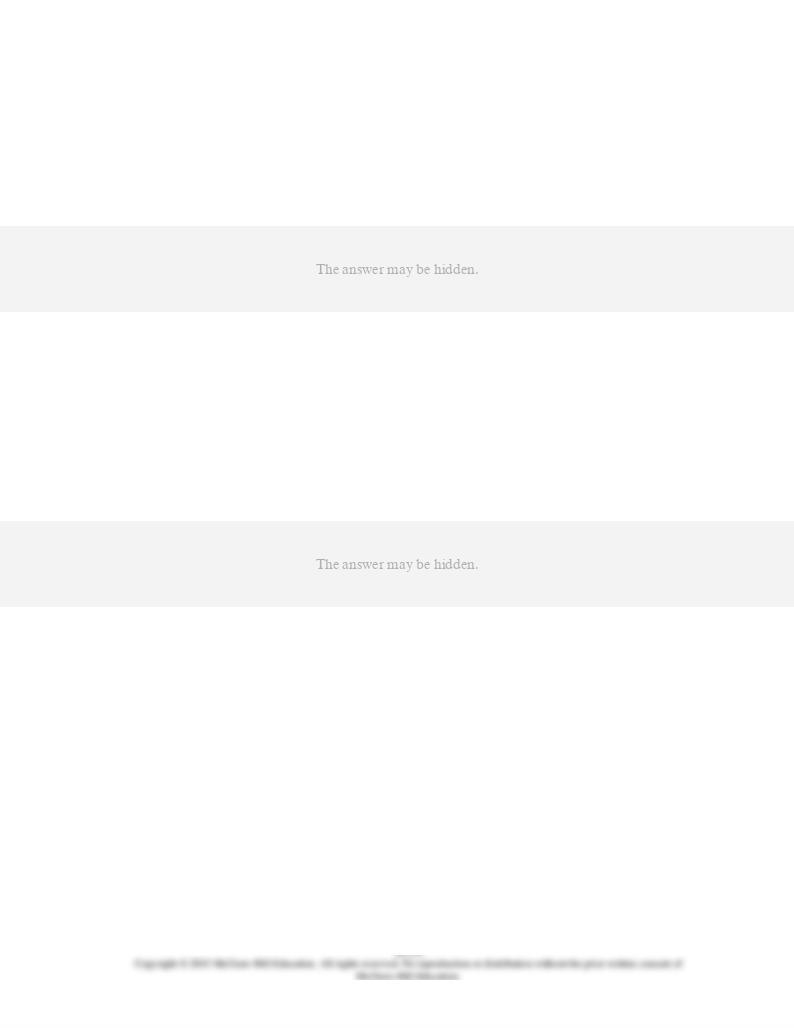
Difficulty: 1 Easy
Learning Objective: 34-02 Describe the balance sheet of the Federal Reserve and the meaning of its major items.
Topic: Consolidated balance sheet of the Federal Reserve Banks
55.
Which of the following will
increase
commercial bank reserves?
AACSB: Reflective Thinking
Accessibility: Keyboard Navigation
Blooms: Understand
Difficulty: 2 Medium
Learning Objective: 34-02 Describe the balance sheet of the Federal Reserve and the meaning of its major items.
Topic: Consolidated balance sheet of the Federal Reserve Banks
56.
When a commercial bank borrows from a Federal Reserve Bank:
AACSB: Reflective Thinking
Accessibility: Keyboard Navigation
Blooms: Understand
Difficulty: 2 Medium
Learning Objective: 34-02 Describe the balance sheet of the Federal Reserve and the meaning of its major items.
Topic: Consolidated balance sheet of the Federal Reserve Banks

57.
The Federal Reserve Banks sell government securities to the public. As a result, the
checkable deposits:
AACSB: Reflective Thinking
Accessibility: Keyboard Navigation
Blooms: Apply
Difficulty: 2 Medium
Learning Objective: 34-02 Describe the balance sheet of the Federal Reserve and the meaning of its major items.
Topic: Consolidated balance sheet of the Federal Reserve Banks
58.
The Federal Reserve Banks buy government securities from commercial banks. As a
result, the checkable deposits:
AACSB: Reflective Thinking
Accessibility: Keyboard Navigation
Blooms: Apply
Difficulty: 2 Medium
Learning Objective: 34-02 Describe the balance sheet of the Federal Reserve and the meaning of its major items.
Topic: Consolidated balance sheet of the Federal Reserve Banks
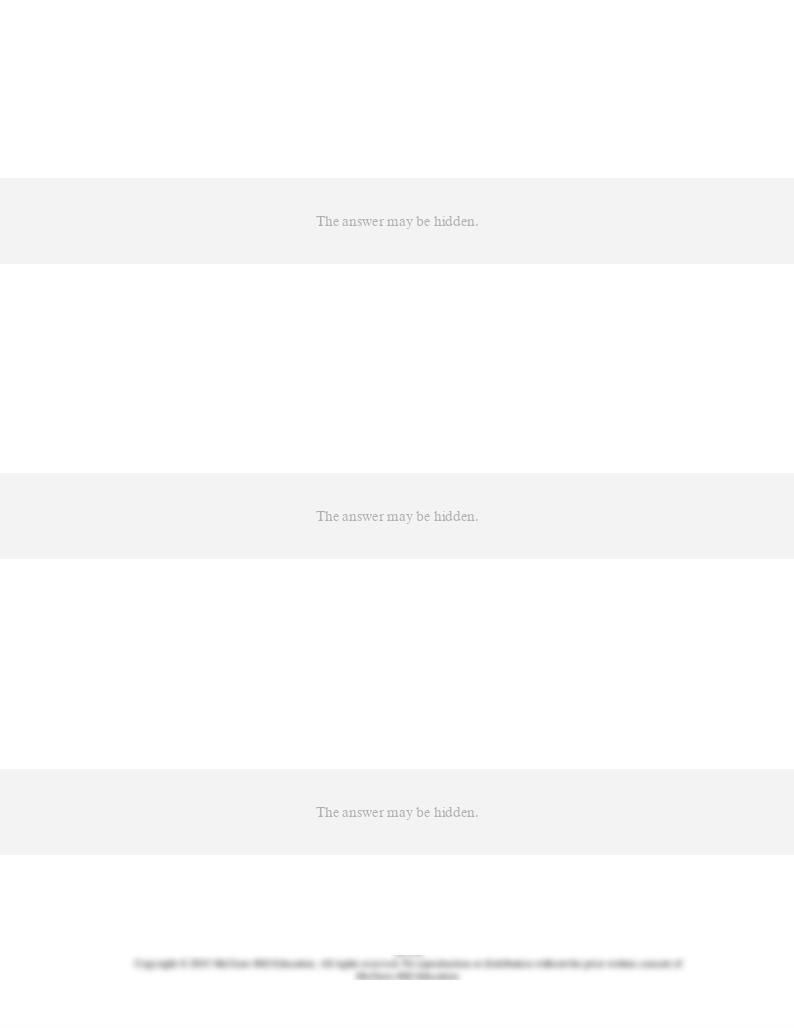
59.
The commercial banking system borrows from the Federal Reserve Banks. As a result, the
checkable deposits:
AACSB: Reflective Thinking
Accessibility: Keyboard Navigation
Blooms: Apply
Difficulty: 2 Medium
Learning Objective: 34-02 Describe the balance sheet of the Federal Reserve and the meaning of its major items.
Topic: Consolidated balance sheet of the Federal Reserve Banks
60.
Which of the following is a tool of monetary policy?
AACSB: Analytic
Accessibility: Keyboard Navigation
Blooms: Remember
Difficulty: 1 Easy
Learning Objective: 34-03 List and explain the goals and tools of monetary policy.
Topic: Tools of monetary policy
61.
In the United States, monetary policy is the responsibility of the:
AACSB: Reflective Thinking
Accessibility: Keyboard Navigation
Blooms: Remember
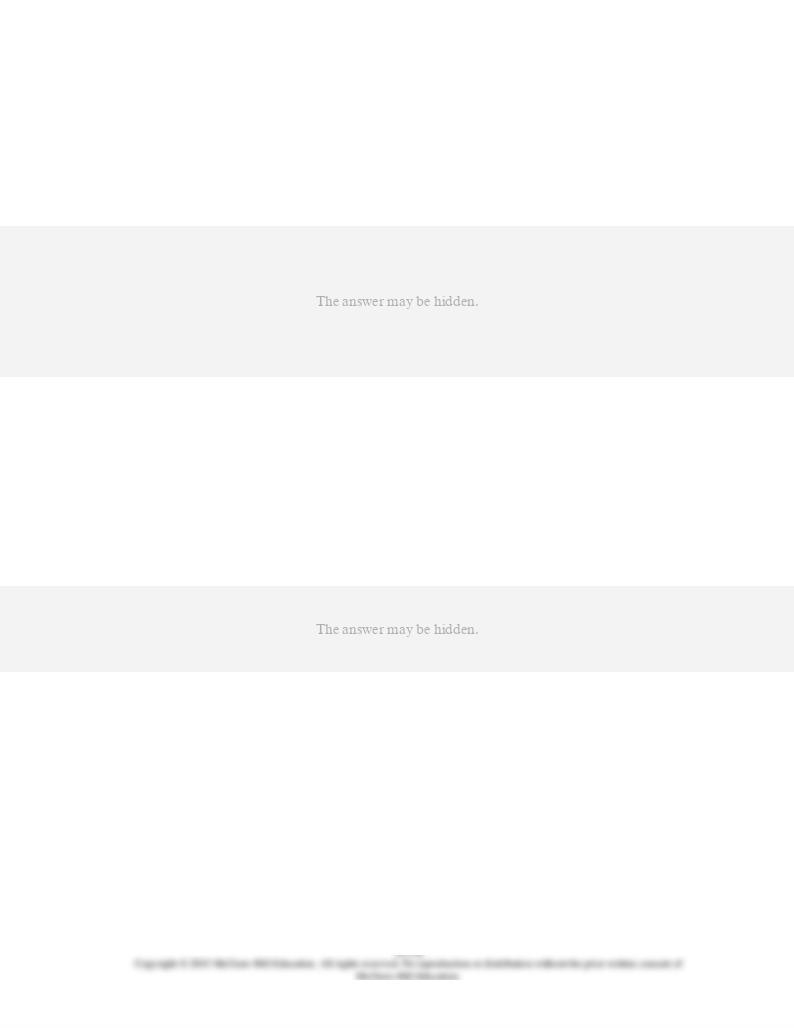
Difficulty: 1 Easy
Learning Objective: 34-03 List and explain the goals and tools of monetary policy.
Topic: Tools of monetary policy
62.
The four main tools of monetary policy are:
AACSB: Analytic
Accessibility: Keyboard Navigation
Blooms: Remember
Difficulty: 1 Easy
Learning Objective: 34-03 List and explain the goals and tools of monetary policy.
Topic: Tools of monetary policy
63.
Which of the following is
not
a tool of monetary policy?
AACSB: Analytic
Accessibility: Keyboard Navigation
Blooms: Remember
Difficulty: 1 Easy
Learning Objective: 34-03 List and explain the goals and tools of monetary policy.
Topic: Tools of monetary policy
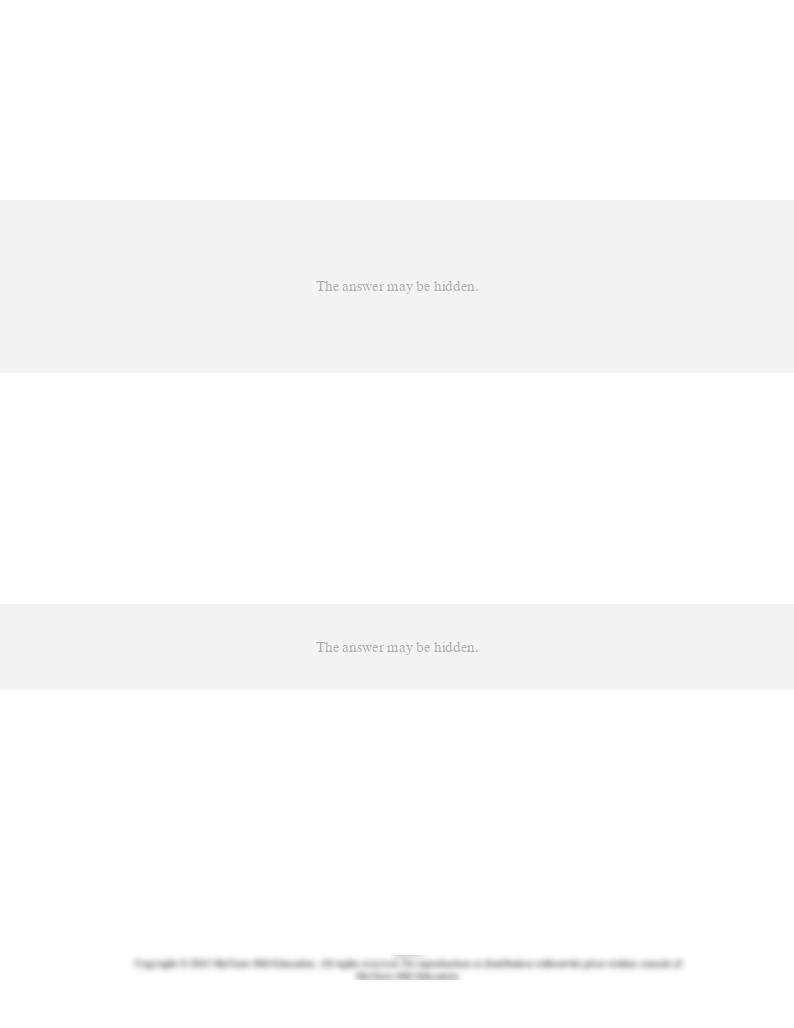
64.
Assume the reserve ratio is 25 percent and Federal Reserve Banks buy $4 million of U.S.
securities from the public, which deposits this amount into checking accounts. As a result
of these transactions, the supply of money is:
AACSB: Analytic
Accessibility: Keyboard Navigation
Blooms: Apply
Difficulty: 2 Medium
Learning Objective: 34-03 List and explain the goals and tools of monetary policy.
Topic: Tools of monetary policy
65.
Assume the legal reserve ratio is 25 percent and the Fourth National Bank borrows
$10,000 from the Federal Reserve Bank in its district. As a result:
AACSB: Analytic
Accessibility: Keyboard Navigation
Blooms: Apply
Difficulty: 2 Medium
Learning Objective: 34-03 List and explain the goals and tools of monetary policy.
Topic: Tools of monetary policy

66.
Open-market operations refer to:
AACSB: Analytic
Accessibility: Keyboard Navigation
Blooms: Remember
Difficulty: 1 Easy
Learning Objective: 34-03 List and explain the goals and tools of monetary policy.
Topic: Tools of monetary policy
67.
If the Federal Reserve System buys government securities from commercial banks and the
public:
AACSB: Reflective Thinking
Accessibility: Keyboard Navigation
Blooms: Understand
Difficulty: 2 Medium
Learning Objective: 34-03 List and explain the goals and tools of monetary policy.
Topic: Tools of monetary policy
68.
The purchase of government securities from the public by the Fed will cause:
AACSB: Reflective Thinking
Accessibility: Keyboard Navigation
Blooms: Understand
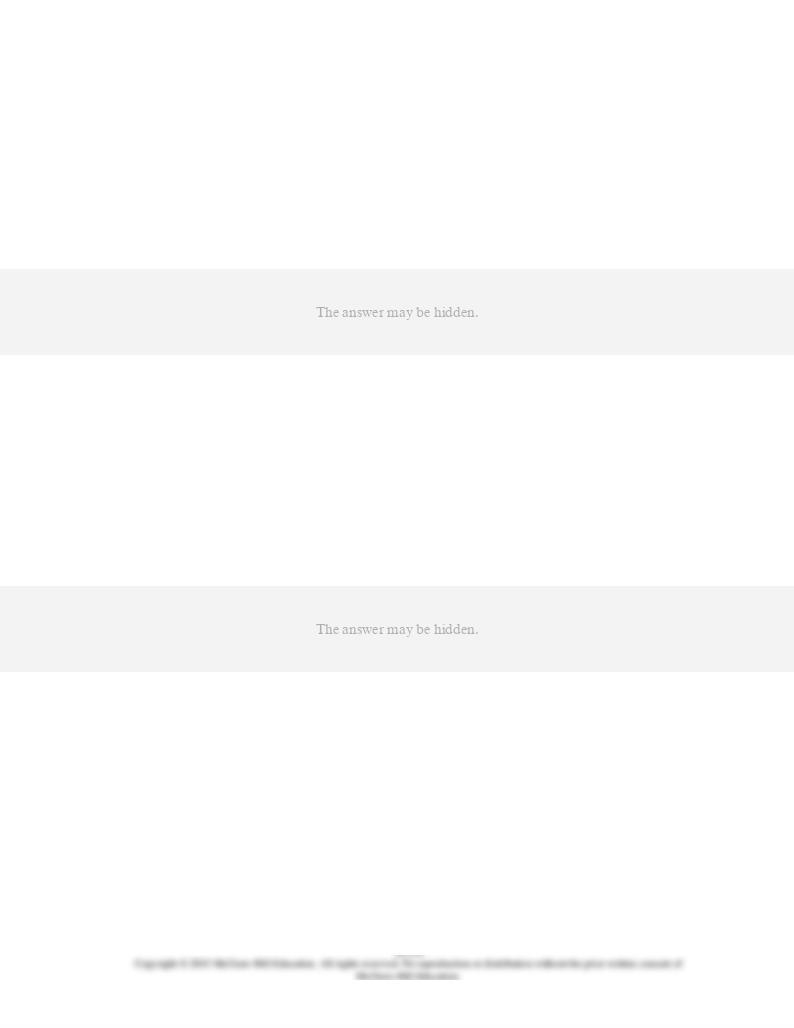
Difficulty: 2 Medium
Learning Objective: 34-03 List and explain the goals and tools of monetary policy.
Topic: Tools of monetary policy
69.
Assume that a single commercial bank has no excess reserves and that the reserve ratio is
20 percent. If this bank sells a bond for $1,000 to a Federal Reserve Bank, it can expand
its loans by a maximum of:
AACSB: Analytic
Accessibility: Keyboard Navigation
Blooms: Apply
Difficulty: 2 Medium
Learning Objective: 34-03 List and explain the goals and tools of monetary policy.
Topic: Tools of monetary policy
70.
Suppose the Federal Reserve Banks sell $2 billion of government bonds to the public,
which pays for them by drawing checks. As a result, commercial bank reserves will:
AACSB: Analytic
Accessibility: Keyboard Navigation
Blooms: Apply
Difficulty: 2 Medium
Learning Objective: 34-03 List and explain the goals and tools of monetary policy.
Topic: Tools of monetary policy
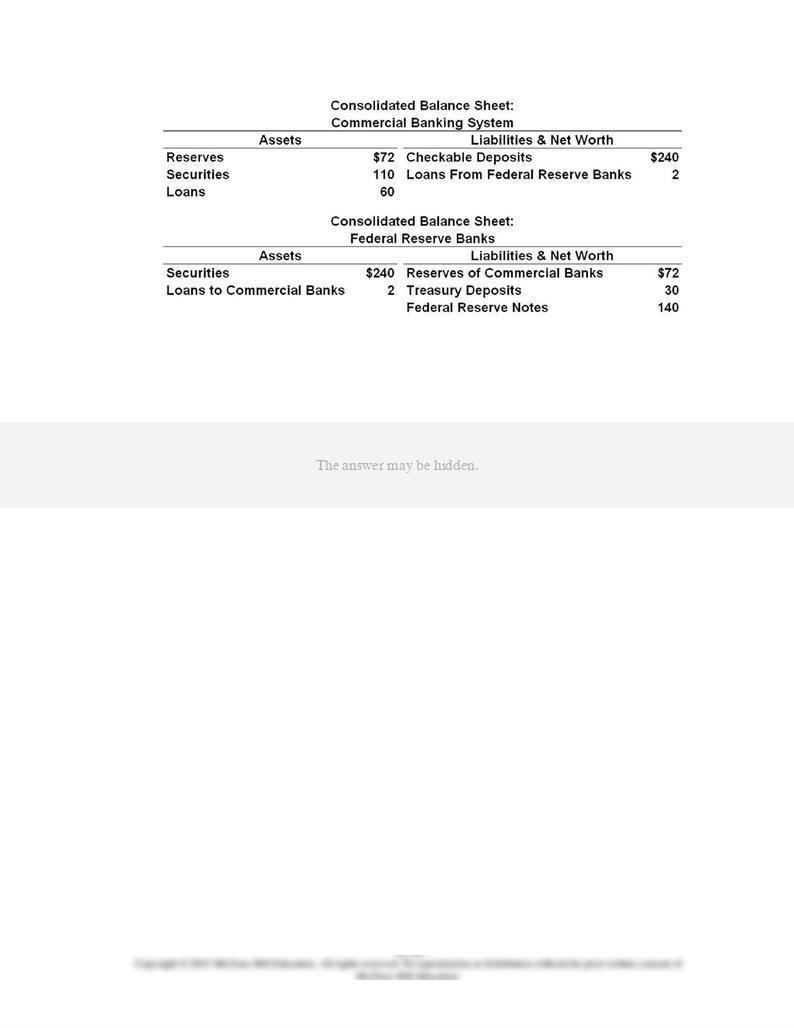
71.
Refer to the given balance sheets. If the reserve ratio is 25 percent, commercial banks
have excess reserves of:
AACSB: Analytic
Blooms: Apply
Difficulty: 2 Medium
Learning Objective: 34-03 List and explain the goals and tools of monetary policy.
Topic: Tools of monetary policy
Type: Table
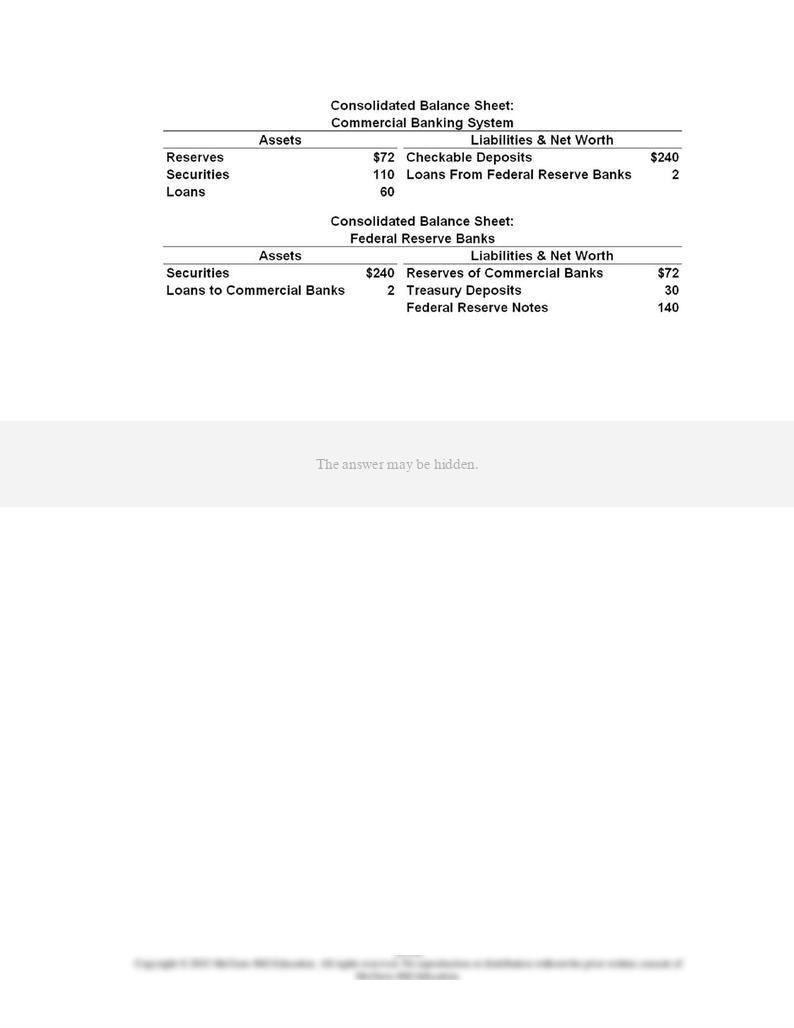
72.
Refer to the given balance sheets. If the reserve ratio is 25 percent, the maximum money-
creating potential of the commercial banking system is:
AACSB: Analytic
Blooms: Apply
Difficulty: 2 Medium
Learning Objective: 34-03 List and explain the goals and tools of monetary policy.
Topic: Tools of monetary policy
Type: Table

73.
Refer to the given balance sheets and assume the reserve ratio is 25 percent. Suppose the
Federal Reserve Banks buy $2 in securities from the public, which deposits this amount
into checking accounts. As a result of these transactions, the supply of money will:
AACSB: Analytic
Blooms: Apply
Difficulty: 2 Medium
Learning Objective: 34-03 List and explain the goals and tools of monetary policy.
Topic: Tools of monetary policy
Type: Table

74.
Refer to the given balance sheets and assume the reserve ratio is 25 percent. Suppose the
Federal Reserve Banks sell $2 in securities directly to the commercial banks. As a result of
this transaction, the supply of money:
AACSB: Analytic
Blooms: Apply
Difficulty: 2 Medium
Learning Objective: 34-03 List and explain the goals and tools of monetary policy.
Topic: Tools of monetary policy
Type: Table
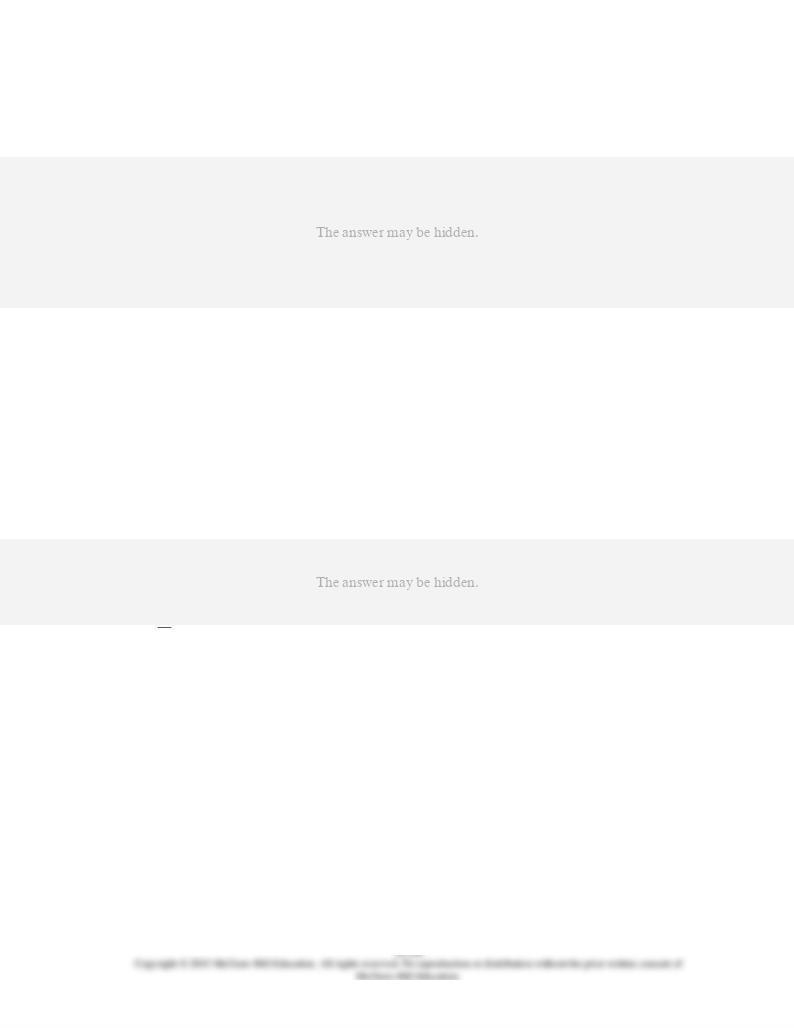
75.
The Federal Reserve System regulates the money supply primarily by:
AACSB: Reflective Thinking
Accessibility: Keyboard Navigation
Blooms: Understand
Difficulty: 2 Medium
Learning Objective: 34-03 List and explain the goals and tools of monetary policy.
Topic: Tools of monetary policy
76.
Which of the following is
correct
? When the Federal Reserve buys government securities
from the public, the money supply:
AACSB: Reflective Thinking
Accessibility: Keyboard Navigation
Blooms: Understand
Difficulty: 2 Medium
Learning Objective: 34-03 List and explain the goals and tools of monetary policy.
Topic: Tools of monetary policy
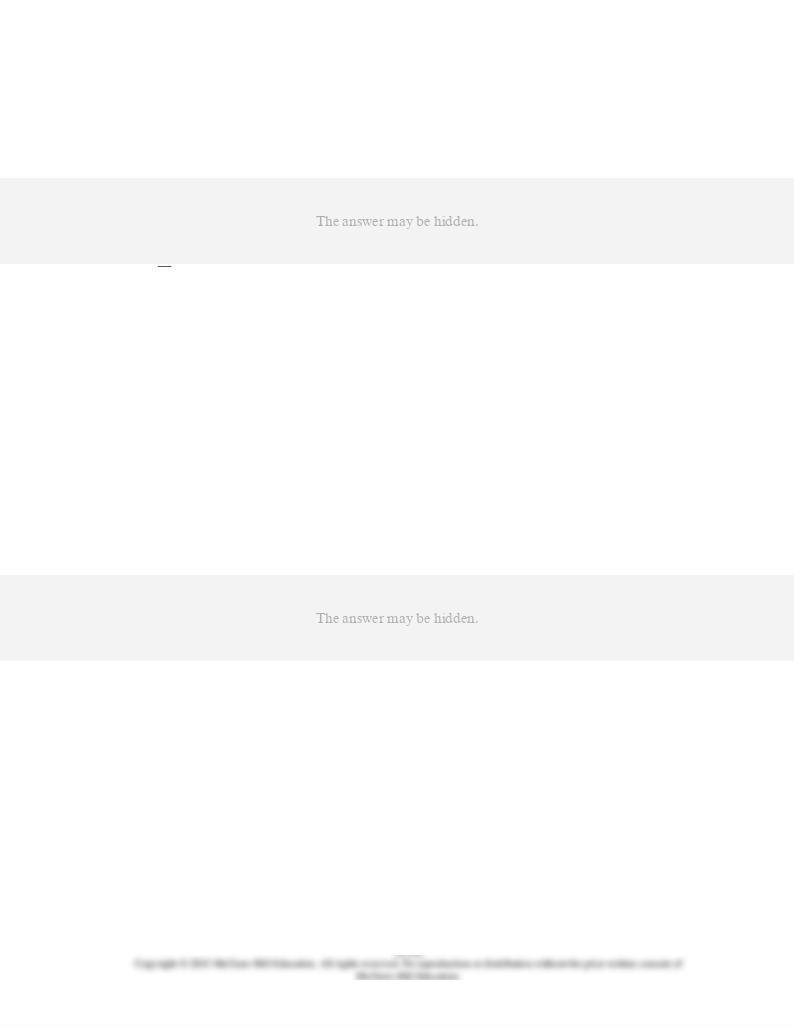
77.
Which of the following will happen when the Federal Reserve buys bonds from the public
in the open market and the amount of cash held by the public does not change?
AACSB: Reflective Thinking
Accessibility: Keyboard Navigation
Blooms: Understand
Difficulty: 2 Medium
Learning Objective: 34-03 List and explain the goals and tools of monetary policy.
Topic: Tools of monetary policy
78.
Answer the question on the assumption that the legal reserve ratio is 20 percent. Suppose
that the Fed sells $500 of government securities to commercial banks (paid for out of
commercial bank reserves) and buys $500 of securities from individuals, who deposit the
cash in checking accounts.
As a result of the given transactions, reserves in the banking system will:
AACSB: Analytic
Accessibility: Keyboard Navigation
Blooms: Apply
Difficulty: 2 Medium
Learning Objective: 34-03 List and explain the goals and tools of monetary policy.
Topic: Tools of monetary policy
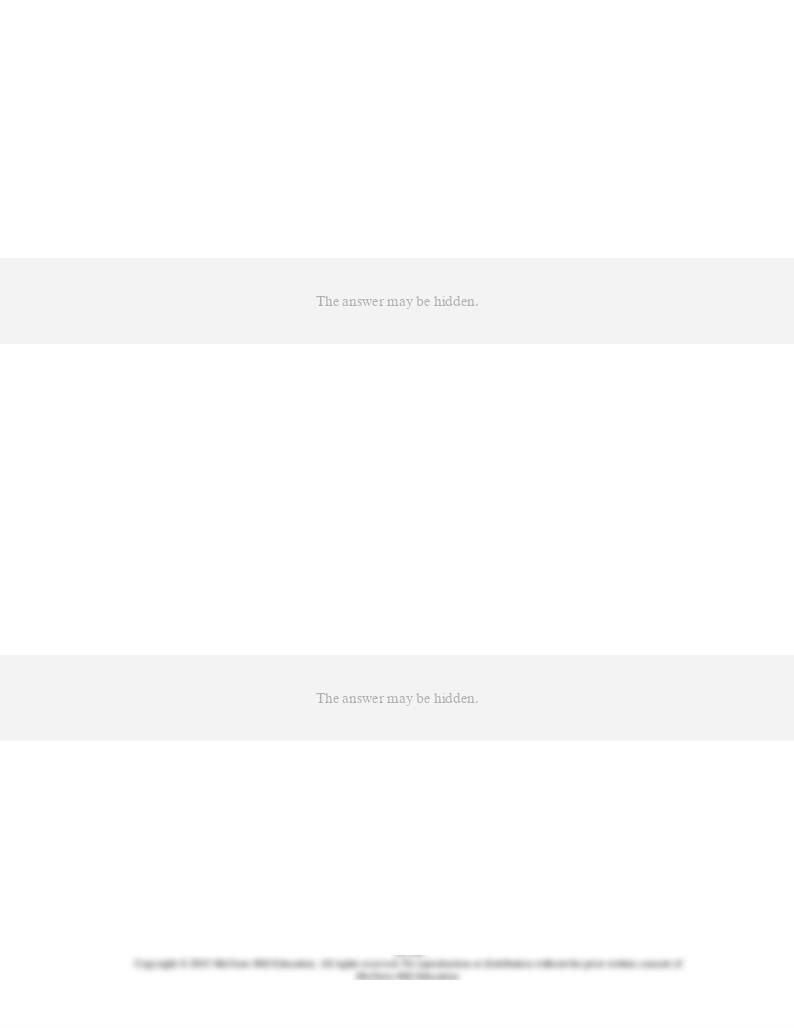
79.
Answer the question on the assumption that the legal reserve ratio is 20 percent. Suppose
that the Fed sells $500 of government securities to commercial banks (paid for out of
commercial bank reserves) and buys $500 of securities from individuals, who deposit the
cash in checking accounts.
As a result of the given transactions, excess reserves in the banking system will:
AACSB: Analytic
Accessibility: Keyboard Navigation
Blooms: Apply
Difficulty: 2 Medium
Learning Objective: 34-03 List and explain the goals and tools of monetary policy.
Topic: Tools of monetary policy
80.
Answer the question on the assumption that the legal reserve ratio is 20 percent. Suppose
that the Fed sells $500 of government securities to commercial banks (paid for out of
commercial bank reserves) and buys $500 of securities from individuals, who deposit the
cash in checking accounts.
As a result of the given transactions, the supply of money in the economy will:
AACSB: Analytic
Accessibility: Keyboard Navigation
Blooms: Apply
Difficulty: 2 Medium
Learning Objective: 34-03 List and explain the goals and tools of monetary policy.
Topic: Tools of monetary policy

81.
Open-market operations change:
AACSB: Reflective Thinking
Accessibility: Keyboard Navigation
Blooms: Understand
Difficulty: 2 Medium
Learning Objective: 34-03 List and explain the goals and tools of monetary policy.
Topic: Tools of monetary policy
82.
Answer the question on the basis of the following consolidated balance sheet of the
commercial banking system. Assume that the reserve requirement is 10 percent. All
figures are in billions and each question should be answered independently of changes
specified in any preceding ones.
Refer to the given data. The commercial banking system has excess reserves of:
AACSB: Analytic
Blooms: Apply
Difficulty: 2 Medium
Learning Objective: 34-03 List and explain the goals and tools of monetary policy.
Topic: Tools of monetary policy
Type: Table
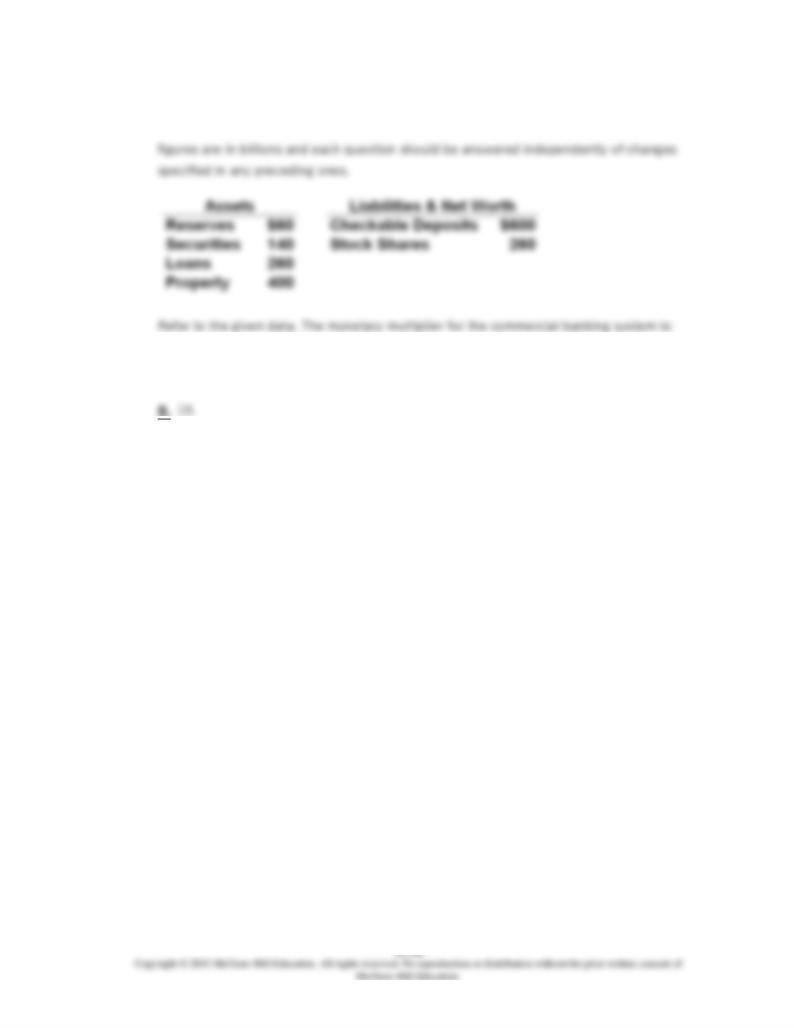
83.
Answer the question on the basis of the following consolidated balance sheet of the
commercial banking system. Assume that the reserve requirement is 10 percent. All
A.
5.
C.
12.5.
D.
20.
AACSB: Analytic
Blooms: Apply
Difficulty: 2 Medium
Learning Objective: 34-03 List and explain the goals and tools of monetary policy.
Topic: Tools of monetary policy
Type: Table
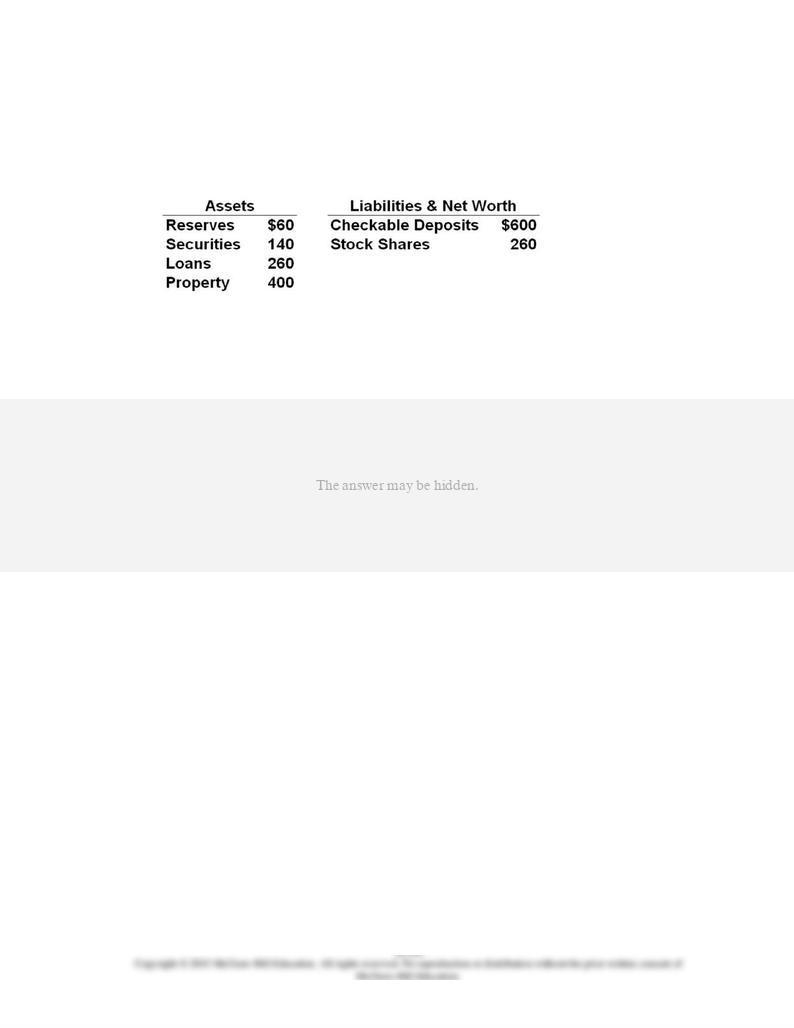
84.
Answer the question on the basis of the following consolidated balance sheet of the
commercial banking system. Assume that the reserve requirement is 10 percent. All
figures are in billions and each question should be answered independently of changes
specified in any preceding ones.
Refer to the given data. Suppose the Fed sold $10 billion of U.S. securities to the banks.
This would:
AACSB: Analytic
Blooms: Apply
Difficulty: 2 Medium
Learning Objective: 34-03 List and explain the goals and tools of monetary policy.
Topic: Tools of monetary policy
Type: Table
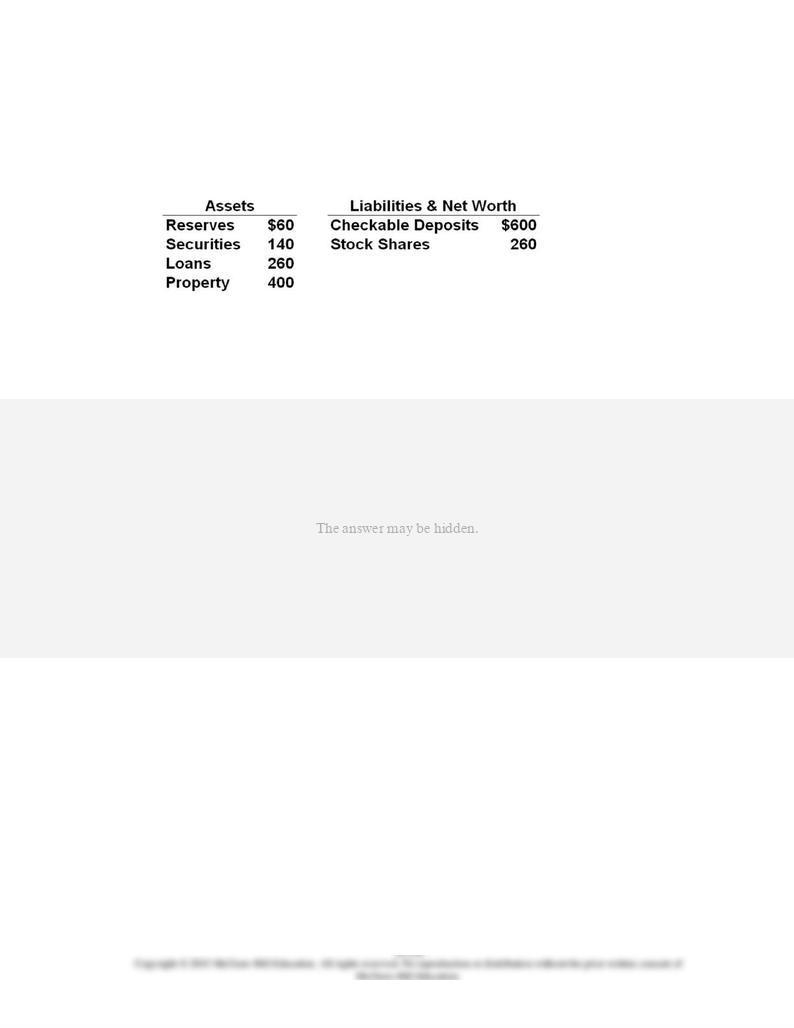
85.
Answer the question on the basis of the following consolidated balance sheet of the
commercial banking system. Assume that the reserve requirement is 10 percent. All
figures are in billions and each question should be answered independently of changes
specified in any preceding ones.
Refer to the given data. Suppose the Fed bought $20 billion of U.S. securities from the
banks. This would:
AACSB: Analytic
Blooms: Apply
Difficulty: 2 Medium
Learning Objective: 34-03 List and explain the goals and tools of monetary policy.
Topic: Tools of monetary policy
Type: Table
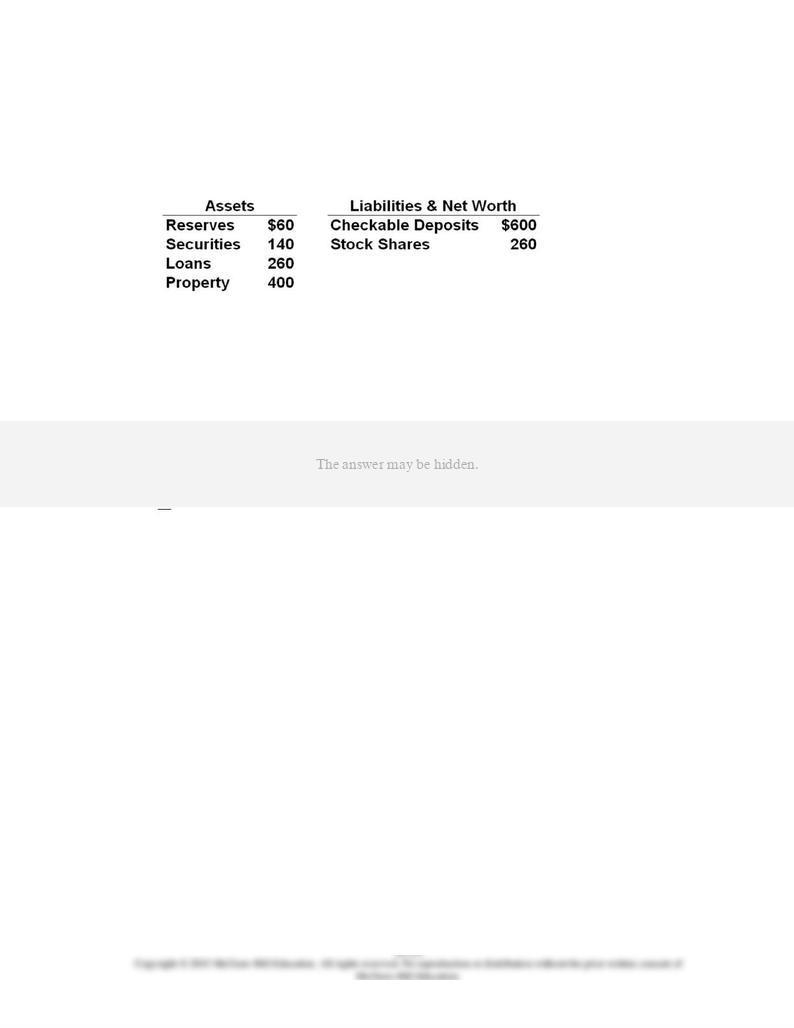
86.
Answer the question on the basis of the following consolidated balance sheet of the
commercial banking system. Assume that the reserve requirement is 10 percent. All
figures are in billions and each question should be answered independently of changes
specified in any preceding ones.
Refer to the given data. Suppose the Fed wants to increase the money supply by $400
billion to drive down interest rates and stimulate the economy. Assuming that the money
multiplier is operating to full effect, to accomplish the desired increase, the Fed could:
AACSB: Analytic
Blooms: Apply
Difficulty: 2 Medium
Learning Objective: 34-03 List and explain the goals and tools of monetary policy.
Topic: Tools of monetary policy
Type: Table
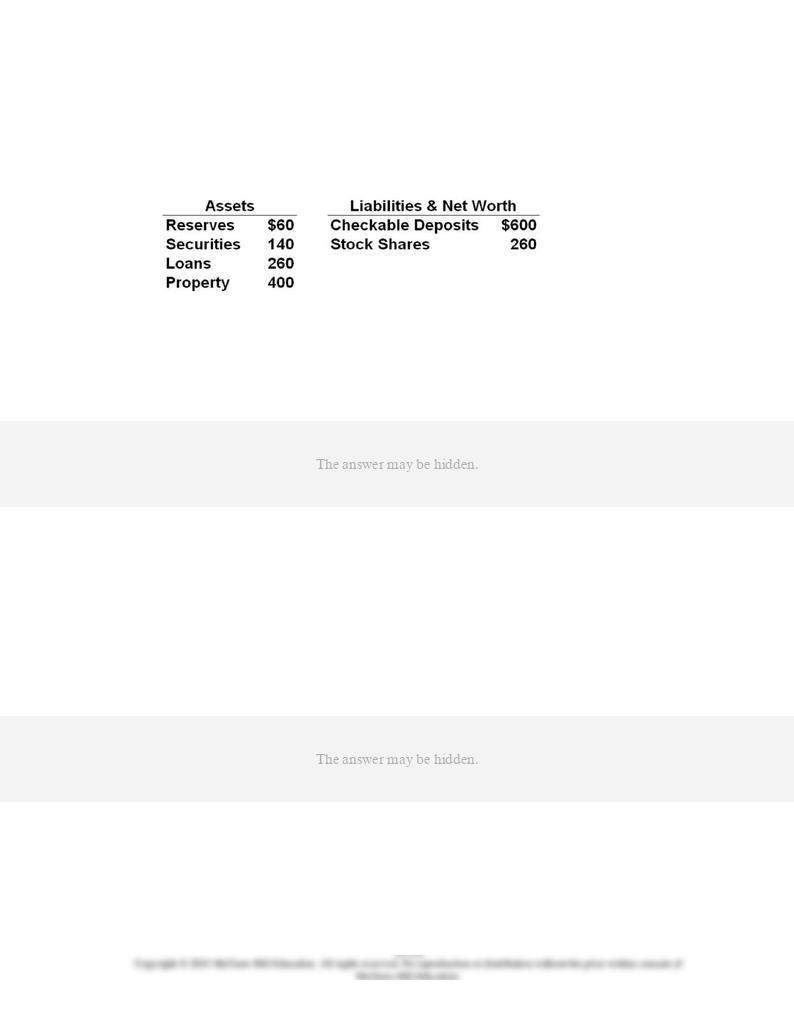
87.
Answer the question on the basis of the following consolidated balance sheet of the
commercial banking system. Assume that the reserve requirement is 10 percent. All
figures are in billions and each question should be answered independently of changes
specified in any preceding ones.
Refer to the given data. Suppose the Fed wants to reduce the money supply by $400
billion to drive up interest rates and dampen inflation. Assuming that the money multiplier
is operating to full effect, to accomplish the desired reduction, the Fed could:
AACSB: Analytic
Blooms: Apply
Difficulty: 2 Medium
Learning Objective: 34-03 List and explain the goals and tools of monetary policy.
Topic: Tools of monetary policy
Type: Table
88.
If the Fed were to reduce the legal reserve ratio, we would expect:
AACSB: Reflective Thinking
Accessibility: Keyboard Navigation
Blooms: Analyze
Difficulty: 3 Hard
Learning Objective: 34-03 List and explain the goals and tools of monetary policy.
Topic: Tools of monetary policy
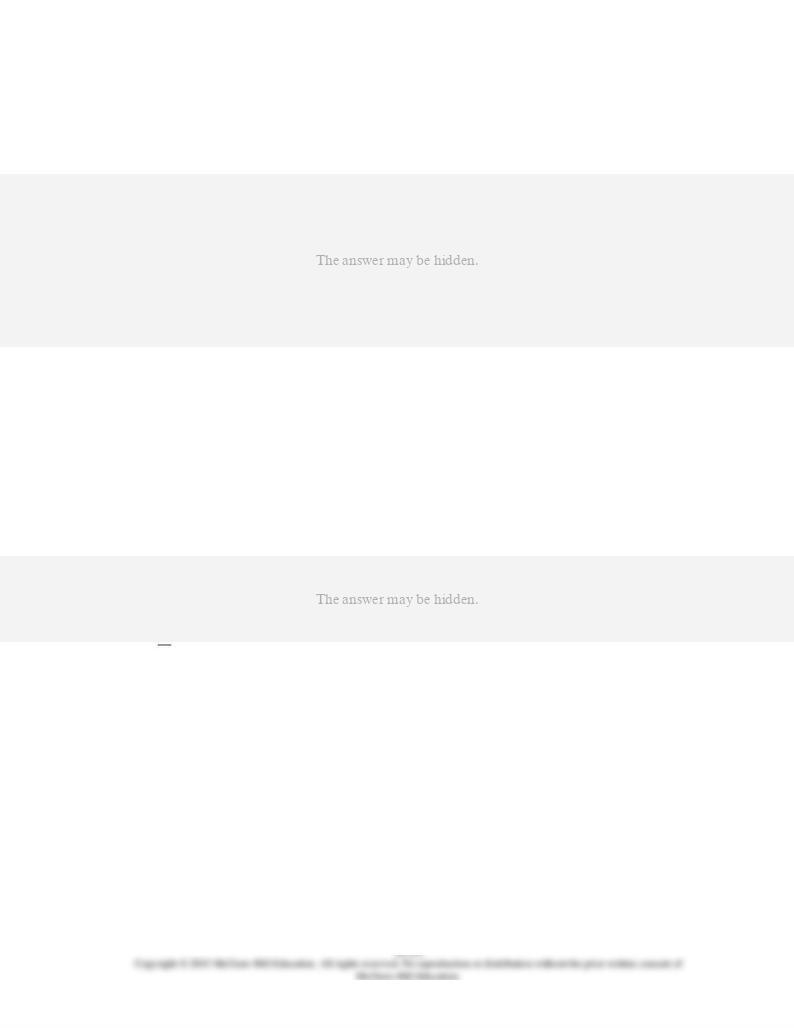
89.
An increase in the legal reserve ratio:
AACSB: Reflective Thinking
Accessibility: Keyboard Navigation
Blooms: Understand
Difficulty: 2 Medium
Learning Objective: 34-03 List and explain the goals and tools of monetary policy.
Topic: Tools of monetary policy
90.
When the reserve requirement is increased:
AACSB: Reflective Thinking
Accessibility: Keyboard Navigation
Blooms: Understand
Difficulty: 2 Medium
Learning Objective: 34-03 List and explain the goals and tools of monetary policy.
Topic: Tools of monetary policy
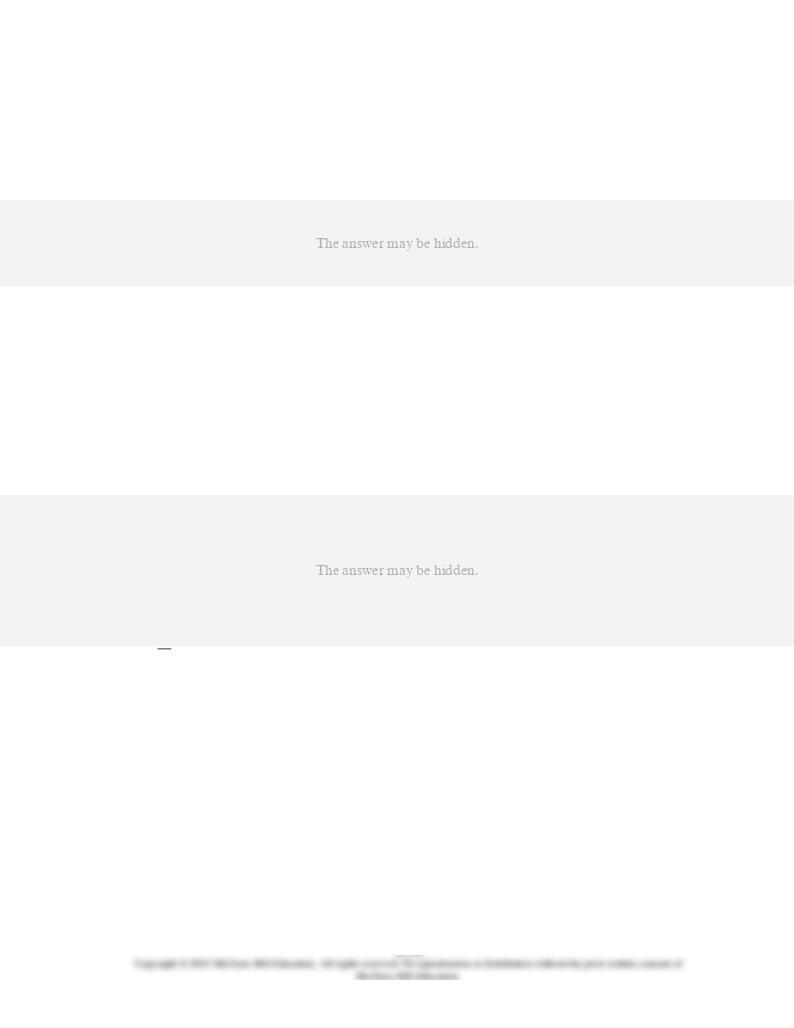
91.
Assume that the commercial banking system has checkable deposits of $10 billion and
excess reserves of $1 billion at a time when the reserve requirement is 20 percent. If the
reserve requirement is now raised to 30 percent, the banking system then has:
AACSB: Analytic
Accessibility: Keyboard Navigation
Blooms: Apply
Difficulty: 2 Medium
Learning Objective: 34-03 List and explain the goals and tools of monetary policy.
Topic: Tools of monetary policy
92.
When the required reserve ratio is increased, the excess reserves of member banks are:
AACSB: Reflective Thinking
Accessibility: Keyboard Navigation
Blooms: Understand
Difficulty: 2 Medium
Learning Objective: 34-03 List and explain the goals and tools of monetary policy.
Topic: Tools of monetary policy
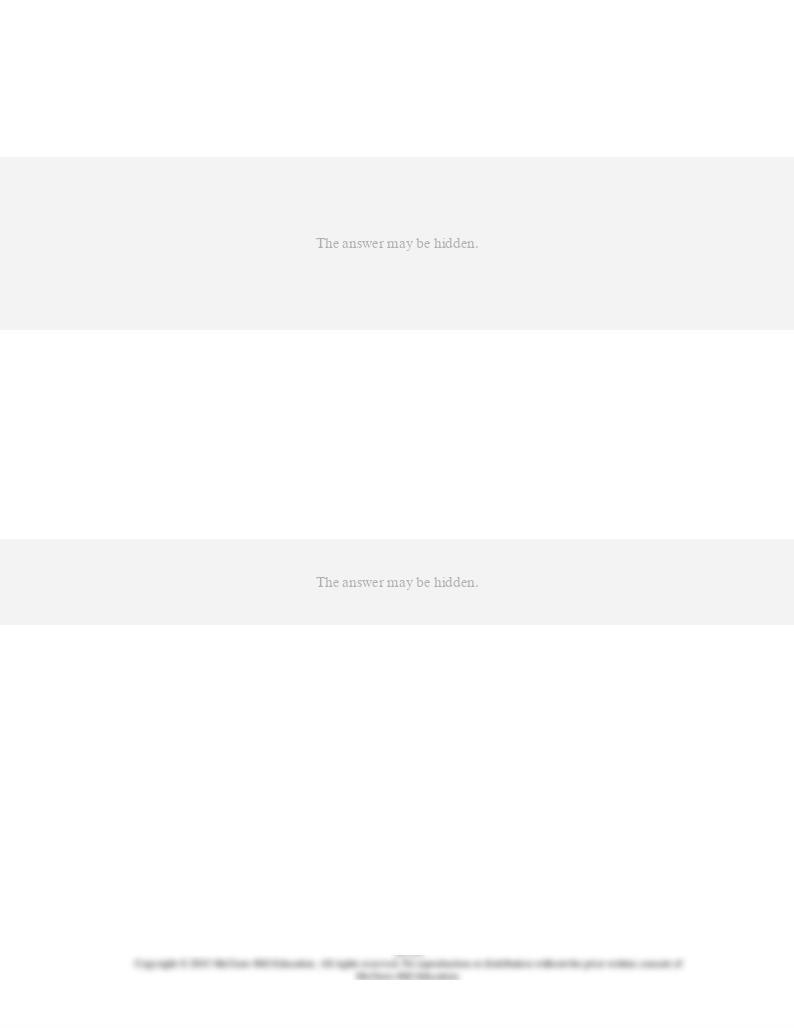
93.
When the required reserve ratio is decreased, the excess reserves of member banks are:
AACSB: Reflective Thinking
Accessibility: Keyboard Navigation
Blooms: Understand
Difficulty: 2 Medium
Learning Objective: 34-03 List and explain the goals and tools of monetary policy.
Topic: Tools of monetary policy
94.
A decrease in the reserve ratio increases the:
AACSB: Reflective Thinking
Accessibility: Keyboard Navigation
Blooms: Understand
Difficulty: 2 Medium
Learning Objective: 34-03 List and explain the goals and tools of monetary policy.
Topic: Tools of monetary policy
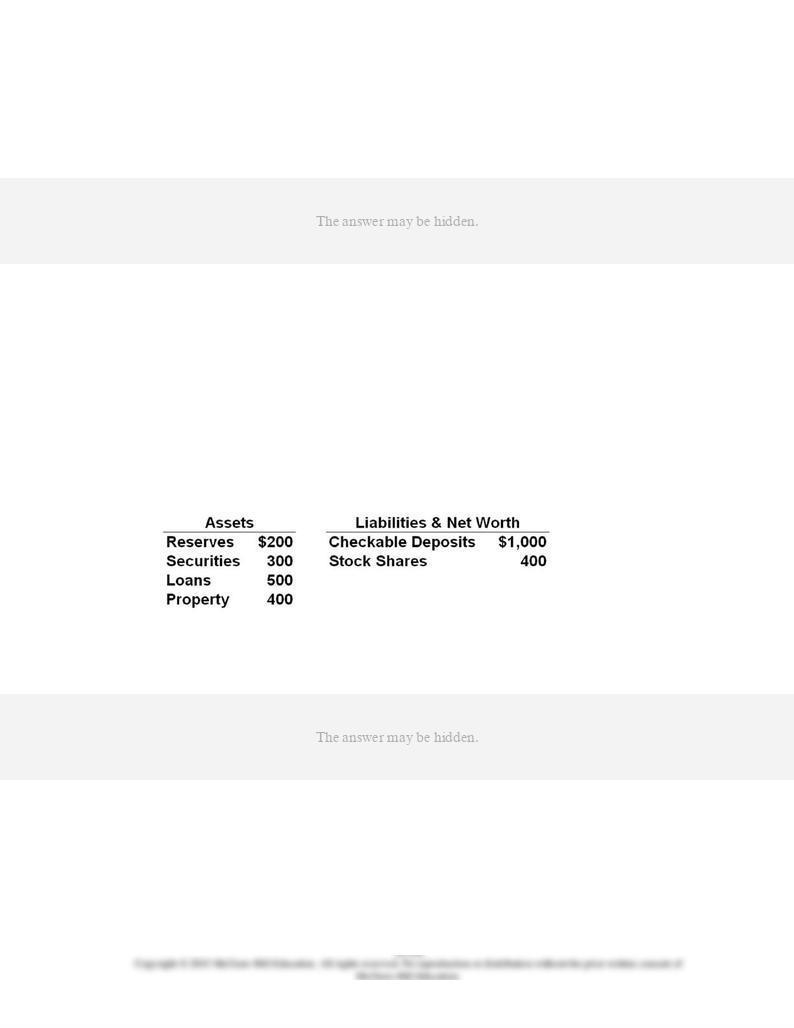
95.
Which of the monetary policy tools can alter both the level of excess reserves and the
money multiplier?
AACSB: Analytic
Accessibility: Keyboard Navigation
Blooms: Remember
Difficulty: 1 Easy
Learning Objective: 34-03 List and explain the goals and tools of monetary policy.
Topic: Tools of monetary policy
96.
Answer the question on the basis of the following consolidated balance sheet of the
commercial banking system. Assume that the reserve requirement is 20 percent. All
figures are in billions and each question should be answered independently of changes
specified in all preceding ones.
Refer to the given data. The commercial banking system has excess reserves of:
AACSB: Analytic
Blooms: Apply
Difficulty: 2 Medium
Learning Objective: 34-03 List and explain the goals and tools of monetary policy.
Topic: Tools of monetary policy
Type: Table
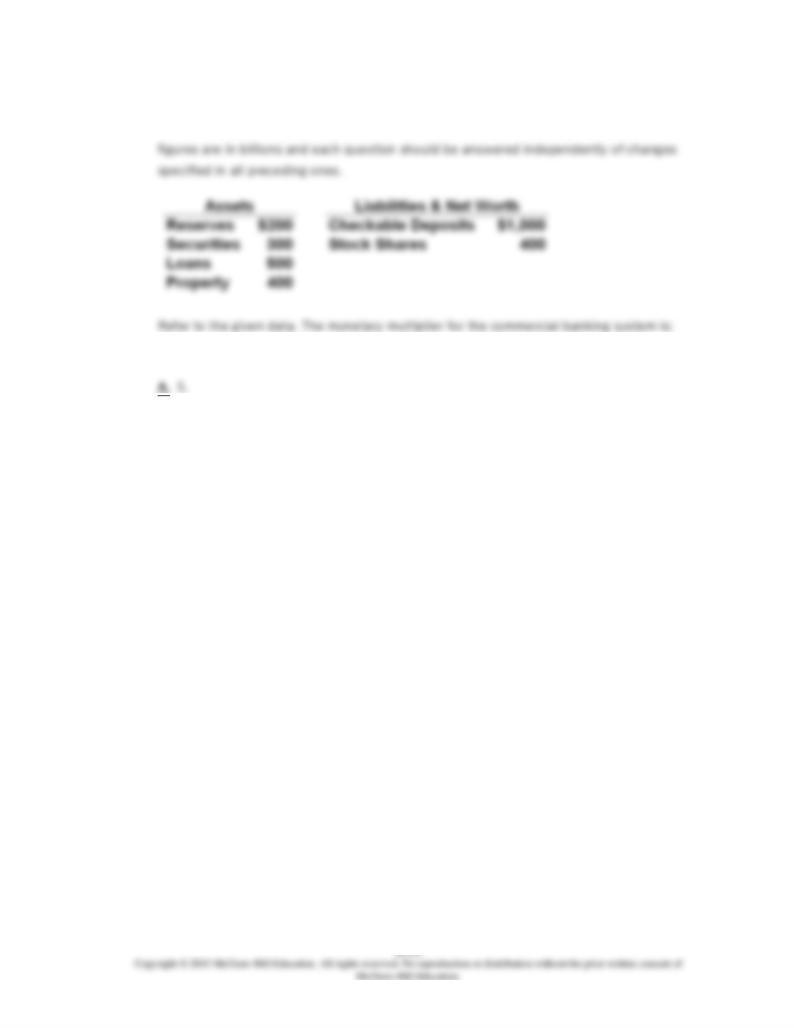
97.
Answer the question on the basis of the following consolidated balance sheet of the
commercial banking system. Assume that the reserve requirement is 20 percent. All
B.
10.
C.
15.
D.
20.
AACSB: Analytic
Blooms: Apply
Difficulty: 2 Medium
Learning Objective: 34-03 List and explain the goals and tools of monetary policy.
Topic: Tools of monetary policy
Type: Table
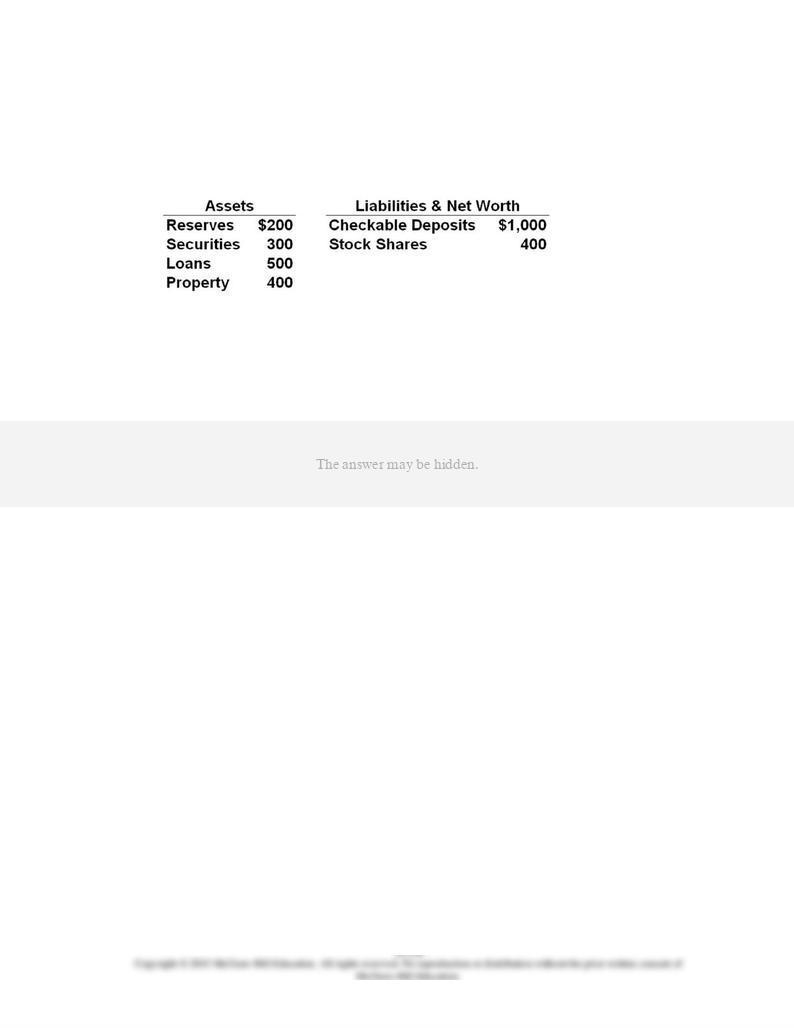
98.
Answer the question on the basis of the following consolidated balance sheet of the
commercial banking system. Assume that the reserve requirement is 20 percent. All
figures are in billions and each question should be answered independently of changes
specified in all preceding ones.
Refer to the given data. If the Fed increased the reserve requirement from 20 percent to 25
percent, a deficiency of reserves in the commercial banking system of _____ would occur
and the monetary multiplier would fall to ____.
AACSB: Analytic
Blooms: Apply
Difficulty: 2 Medium
Learning Objective: 34-03 List and explain the goals and tools of monetary policy.
Topic: Tools of monetary policy
Type: Table
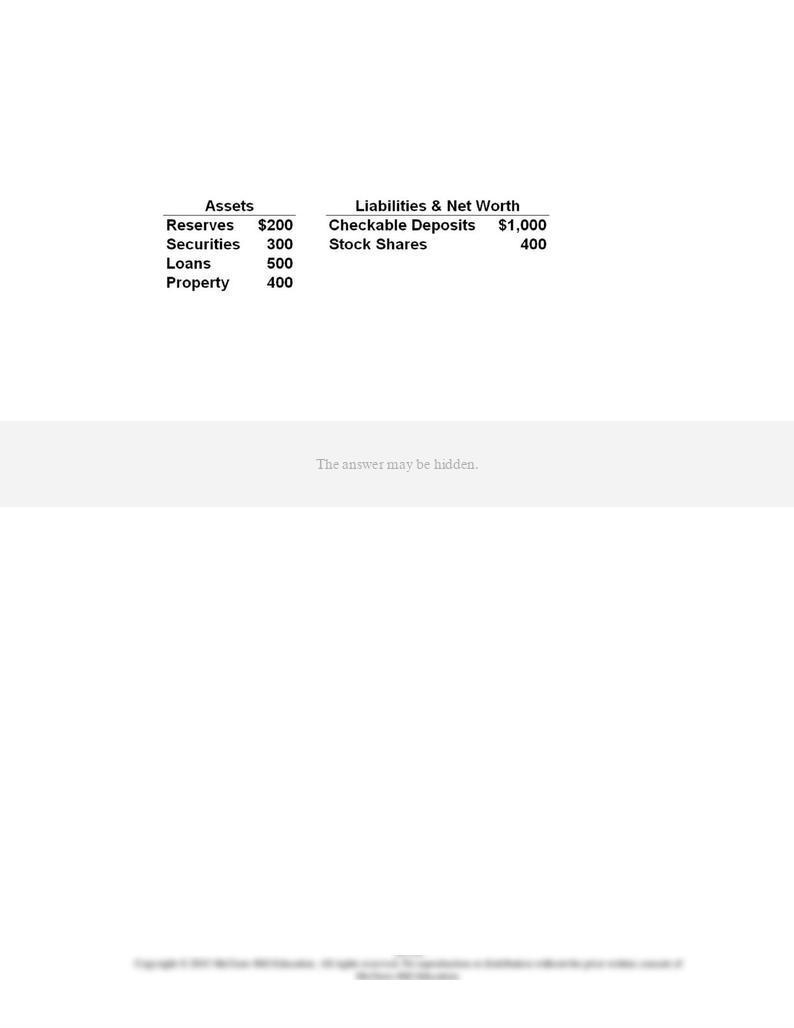
99.
Answer the question on the basis of the following consolidated balance sheet of the
commercial banking system. Assume that the reserve requirement is 20 percent. All
figures are in billions and each question should be answered independently of changes
specified in all preceding ones.
Refer to the given data. If the Fed reduced the reserve requirement from 20 percent to 16
percent, excess reserves in the commercial banking system would increase by _____ and
the monetary multiplier would rise to ____.
AACSB: Analytic
Blooms: Apply
Difficulty: 2 Medium
Learning Objective: 34-03 List and explain the goals and tools of monetary policy.
Topic: Tools of monetary policy
Type: Table
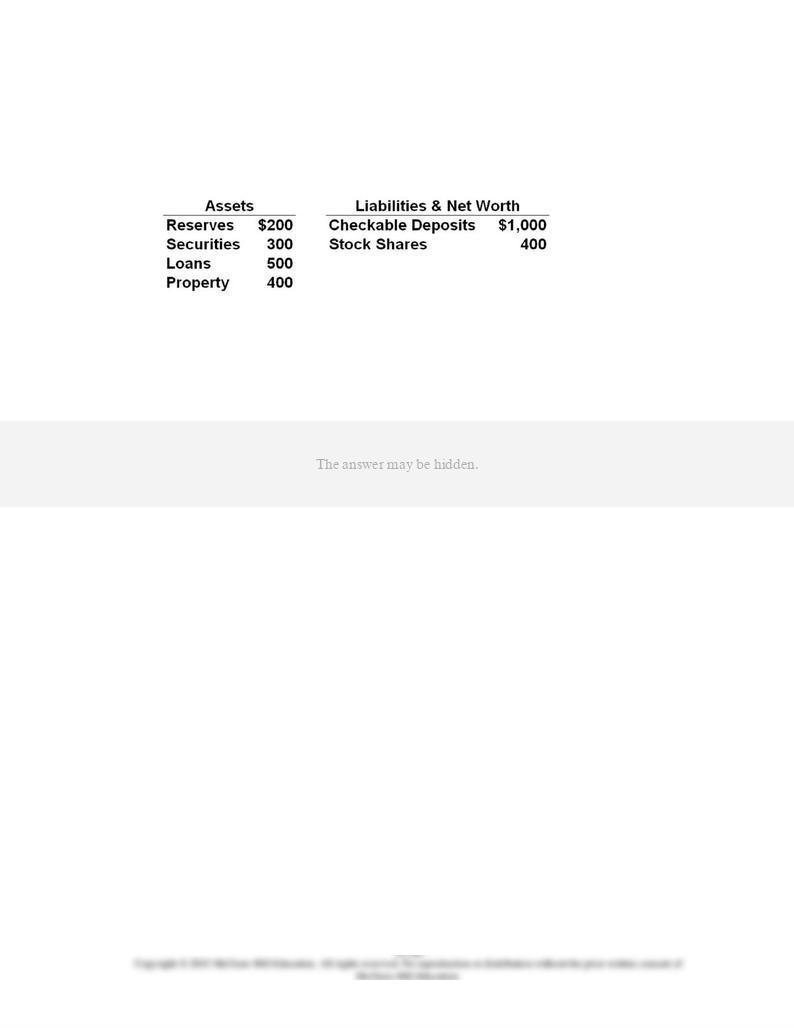
100.
Answer the question on the basis of the following consolidated balance sheet of the
commercial banking system. Assume that the reserve requirement is 20 percent. All
figures are in billions and each question should be answered independently of changes
specified in all preceding ones.
Refer to the given data. Suppose the Fed wants to increase the money supply by $1,000
billion to drive down interest rates and stimulate the economy. To accomplish this, it could
lower the reserve requirement from 20 percent to:
AACSB: Analytic
Blooms: Analyze
Difficulty: 3 Hard
Learning Objective: 34-03 List and explain the goals and tools of monetary policy.
Topic: Tools of monetary policy
Type: Table
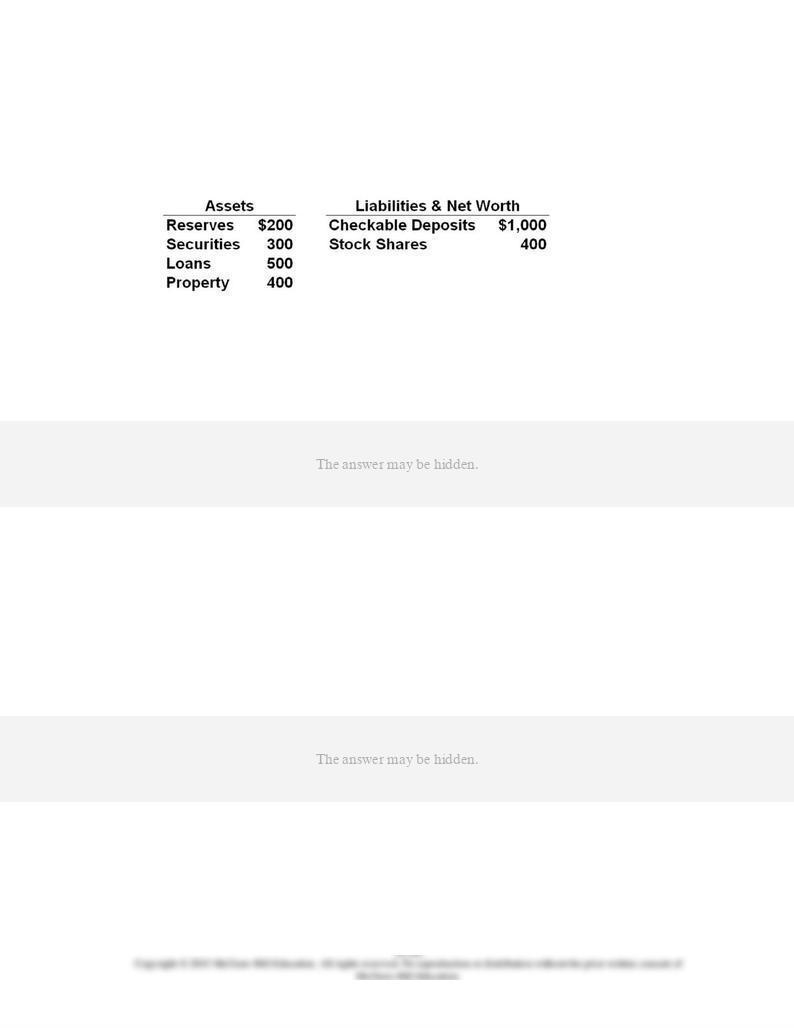
101.
Answer the question on the basis of the following consolidated balance sheet of the
commercial banking system. Assume that the reserve requirement is 20 percent. All
figures are in billions and each question should be answered independently of changes
specified in all preceding ones.
Refer to the given data. Suppose the Fed wants to reduce the money supply by $200
billion to drive up interest rates and dampen inflation. To accomplish this, it could increase
the reserve requirement from 20 percent to:
AACSB: Analytic
Blooms: Analyze
Difficulty: 3 Hard
Learning Objective: 34-03 List and explain the goals and tools of monetary policy.
Topic: Tools of monetary policy
Type: Table
102.
The discount rate is the interest:
AACSB: Analytic
Accessibility: Keyboard Navigation
Blooms: Remember
Difficulty: 1 Easy
Learning Objective: 34-03 List and explain the goals and tools of monetary policy.
Topic: Tools of monetary policy
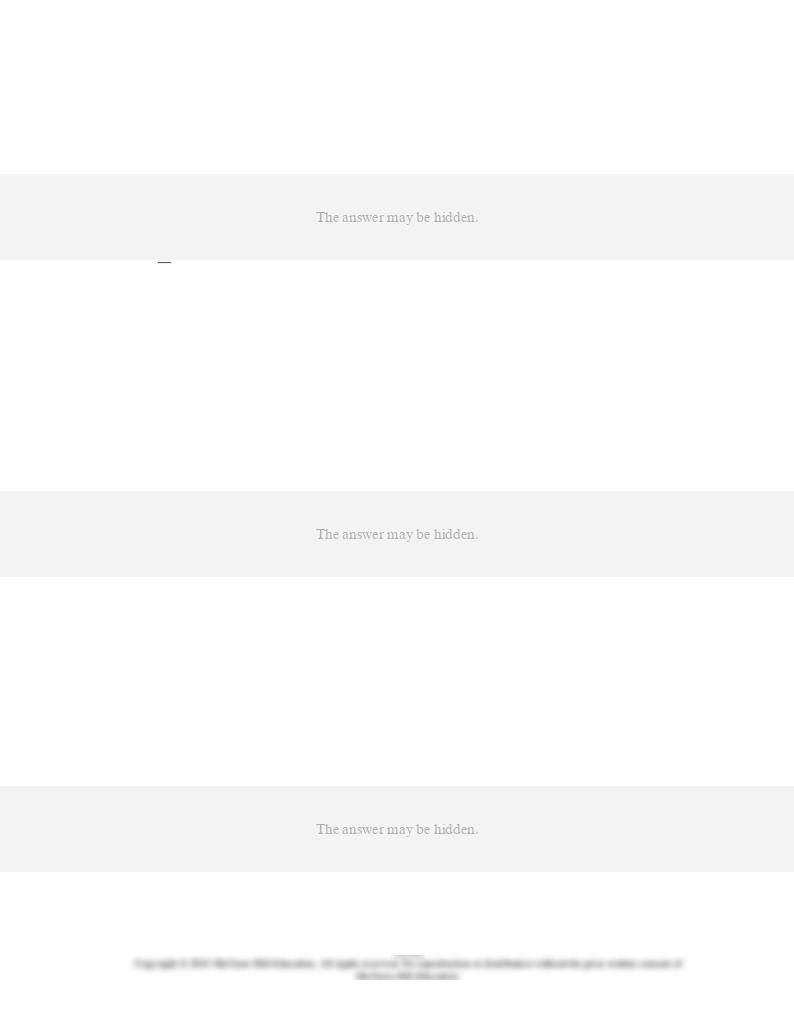
103.
A commercial bank can add to its actual reserves by:
AACSB: Reflective Thinking
Accessibility: Keyboard Navigation
Blooms: Understand
Difficulty: 2 Medium
Learning Objective: 34-03 List and explain the goals and tools of monetary policy.
Topic: Tools of monetary policy
104.
The interest rate at which the Federal Reserve Banks lend to commercial banks is called
the:
AACSB: Analytic
Accessibility: Keyboard Navigation
Blooms: Remember
Difficulty: 1 Easy
Learning Objective: 34-03 List and explain the goals and tools of monetary policy.
Topic: Tools of monetary policy
105.
The discount rate is the rate of interest at which:
AACSB: Analytic
Accessibility: Keyboard Navigation
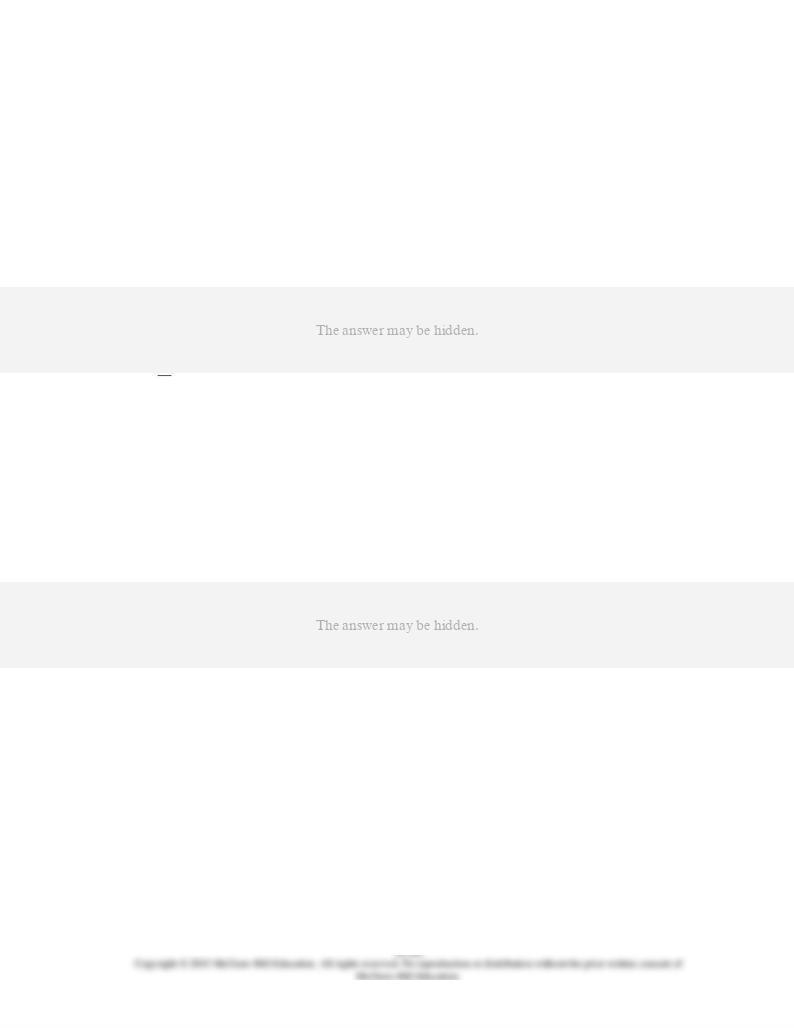
Blooms: Remember
Difficulty: 1 Easy
Learning Objective: 34-03 List and explain the goals and tools of monetary policy.
Topic: Tools of monetary policy
106.
Projecting that it might temporarily fall short of legally required reserves in the coming
days, the Bank of Beano decides to borrow money from its regional Federal Reserve Bank.
The interest rate on the loan is called the:
AACSB: Analytic
Accessibility: Keyboard Navigation
Blooms: Apply
Difficulty: 2 Medium
Learning Objective: 34-03 List and explain the goals and tools of monetary policy.
Topic: Tools of monetary policy
107.
When the Fed lends money to a commercial bank, the bank:
AACSB: Reflective Thinking
Accessibility: Keyboard Navigation
Blooms: Understand
Difficulty: 2 Medium
Learning Objective: 34-03 List and explain the goals and tools of monetary policy.
Topic: Tools of monetary policy
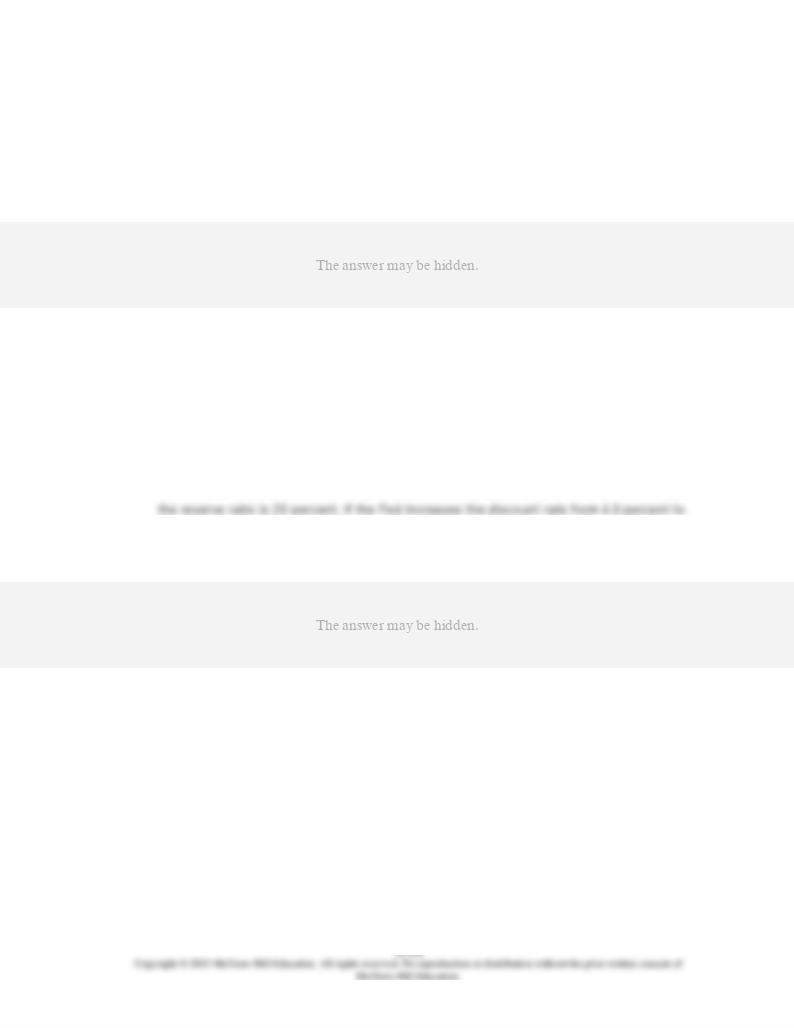
108.
Suppose that, for every 1-percentage-point decline in the discount rate, commercial banks
collectively borrow an additional $2 billion from Federal Reserve Banks. Also assume that
the reserve ratio is 10 percent. If the Fed lowers the discount rate from 4.0 percent to 3.5
percent, bank reserves will:
AACSB: Analytic
Accessibility: Keyboard Navigation
Blooms: Analyze
Difficulty: 3 Hard
Learning Objective: 34-03 List and explain the goals and tools of monetary policy.
Topic: Tools of monetary policy
109.
Suppose that, for every 1-percentage-point decline of the discount rate, commercial banks
collectively borrow an additional $2 billion from Federal Reserve Banks. Also assume that
4.25 percent, bank reserves will:
AACSB: Analytic
Accessibility: Keyboard Navigation
Blooms: Analyze
Difficulty: 3 Hard
Learning Objective: 34-03 List and explain the goals and tools of monetary policy.
Topic: Tools of monetary policy

110.
Which of the following tools of monetary policy is considered the most important on a day-
to-day basis?
AACSB: Reflective Thinking
Accessibility: Keyboard Navigation
Blooms: Remember
Difficulty: 1 Easy
Learning Objective: 34-03 List and explain the goals and tools of monetary policy.
Topic: Tools of monetary policy
111.
Which of the following tools of monetary policy is flexible and able to affect bank reserves
quickly and by relatively specific amounts?
AACSB: Reflective Thinking
Accessibility: Keyboard Navigation
Blooms: Understand
Difficulty: 2 Medium
Learning Objective: 34-03 List and explain the goals and tools of monetary policy.
Topic: Tools of monetary policy
112.
Which of the following tools of monetary policy has not been used since 1992?
AACSB: Reflective Thinking
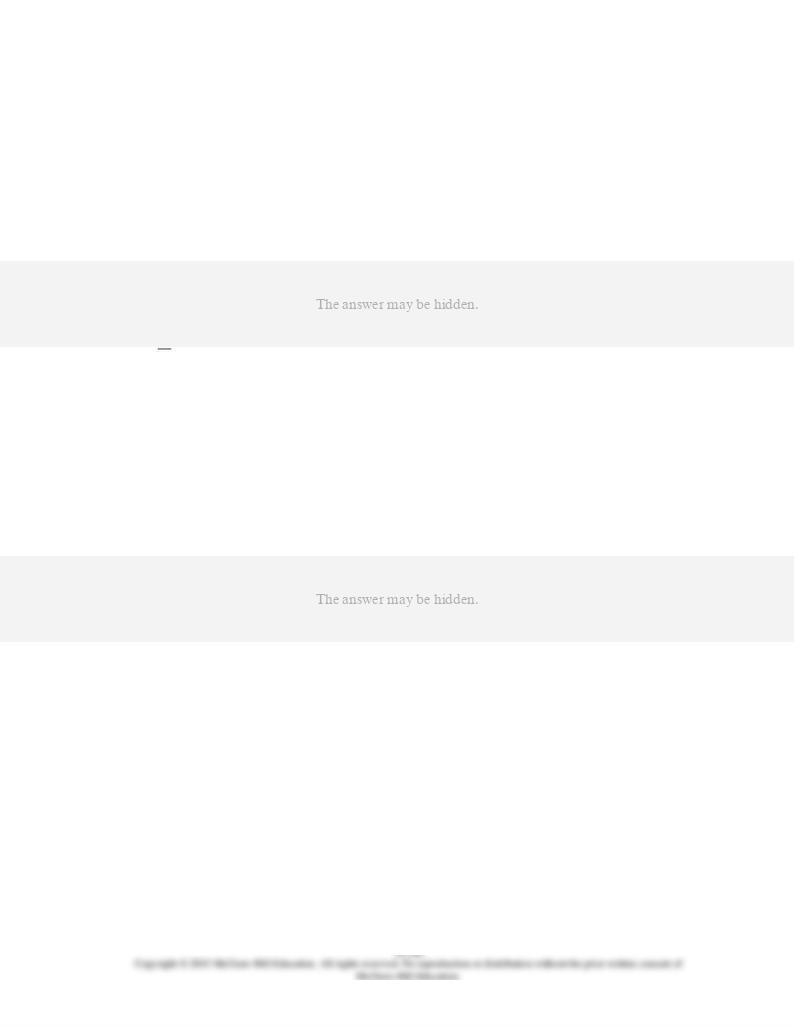
Accessibility: Keyboard Navigation
Blooms: Remember
Difficulty: 1 Easy
Learning Objective: 34-03 List and explain the goals and tools of monetary policy.
Topic: Tools of monetary policy
113.
Which of the following monetary policy tools was introduced in 2008?
AACSB: Reflective Thinking
Accessibility: Keyboard Navigation
Blooms: Remember
Difficulty: 1 Easy
Learning Objective: 34-03 List and explain the goals and tools of monetary policy.
Topic: Tools of monetary policy
114.
If the Fed wants to discourage commercial bank lending, it will:
AACSB: Reflective Thinking
Accessibility: Keyboard Navigation
Blooms: Remember
Difficulty: 1 Easy
Learning Objective: 34-03 List and explain the goals and tools of monetary policy.
Topic: Tools of monetary policy
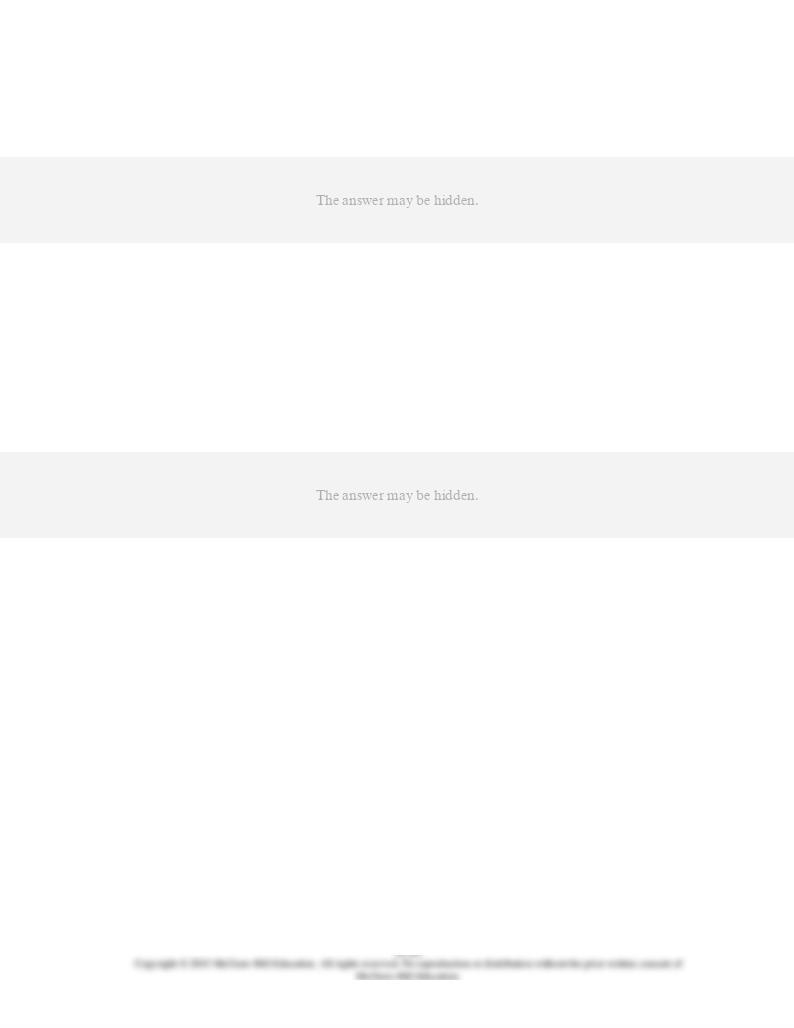
115.
Interest paid on reserves held at the Fed:
AACSB: Reflective Thinking
Accessibility: Keyboard Navigation
Blooms: Understand
Difficulty: 2 Medium
Learning Objective: 34-03 List and explain the goals and tools of monetary policy.
Topic: Tools of monetary policy
116.
Beginning in 2008, the Fed was allowed to:
AACSB: Reflective Thinking
Accessibility: Keyboard Navigation
Blooms: Remember
Difficulty: 1 Easy
Learning Objective: 34-03 List and explain the goals and tools of monetary policy.
Topic: Tools of monetary policy
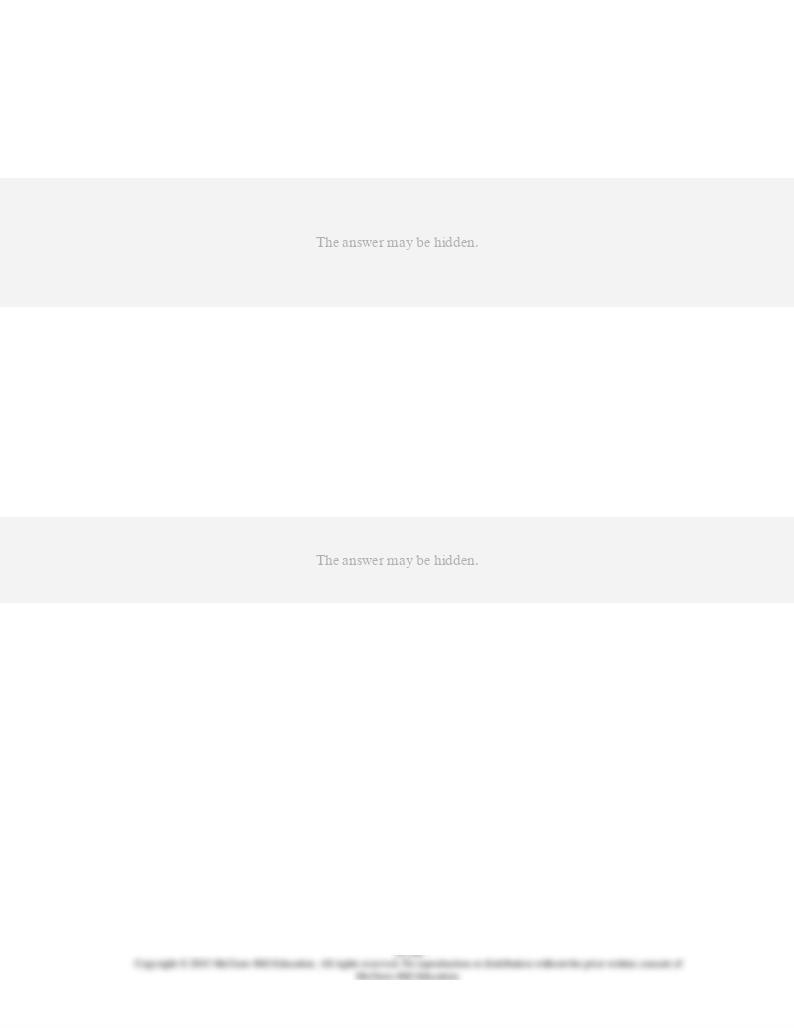
117.
Big Bucks Bank currently holds $20 million in excess reserves. If the Fed increases the
rate of interest it pays on reserves held at the Fed, we would expect Big Bucks Bank to:
AACSB: Analytic
Accessibility: Keyboard Navigation
Blooms: Apply
Difficulty: 2 Medium
Learning Objective: 34-03 List and explain the goals and tools of monetary policy.
Topic: Tools of monetary policy
118.
Which of the following actions by the Fed most likely increase commercial bank lending?
AACSB: Reflective Thinking
Accessibility: Keyboard Navigation
Blooms: Understand
Difficulty: 2 Medium
Learning Objective: 34-03 List and explain the goals and tools of monetary policy.
Topic: Tools of monetary policy
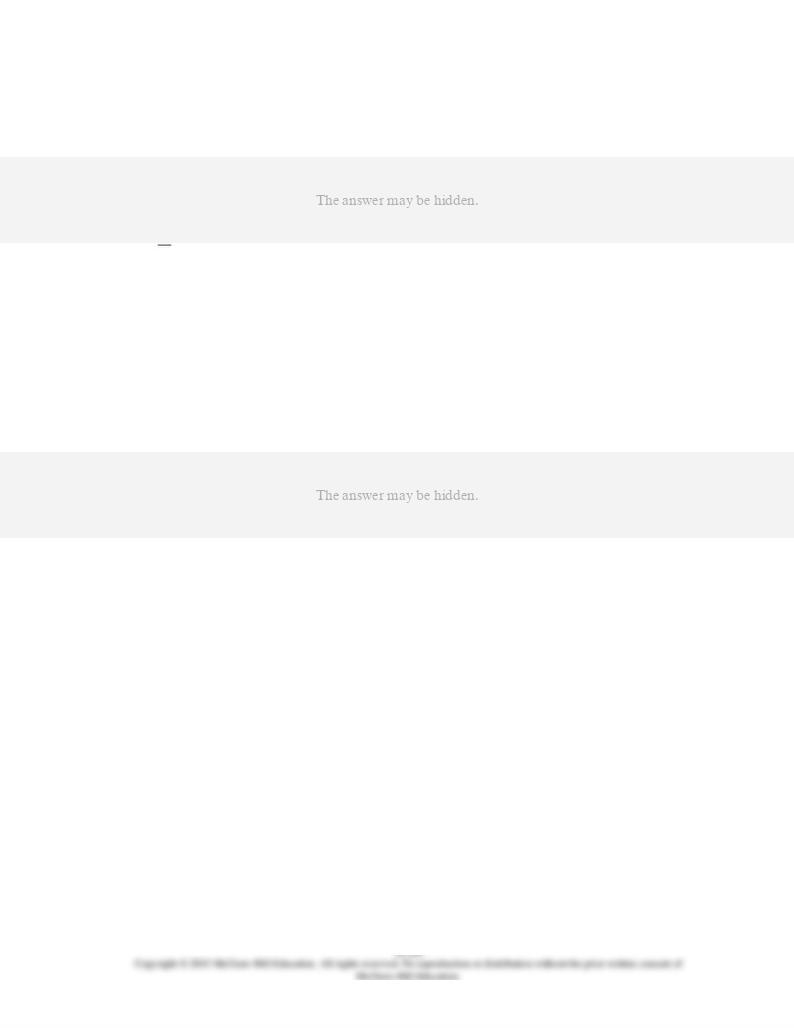
119.
The interest rate that banks charge one another on overnight loans is called the:
AACSB: Analytic
Accessibility: Keyboard Navigation
Blooms: Remember
Difficulty: 1 Easy
Learning Objective: 34-04 Describe the federal funds rate and how the Fed directly influences it.
Topic: Targeting the federal funds rate
120.
The federal funds rate is the interest rate that _______ charge(s) _______.
AACSB: Analytic
Accessibility: Keyboard Navigation
Blooms: Remember
Difficulty: 1 Easy
Learning Objective: 34-04 Describe the federal funds rate and how the Fed directly influences it.
Topic: Targeting the federal funds rate

121.
Which of the following statements is true?
AACSB: Reflective Thinking
Accessibility: Keyboard Navigation
Blooms: Remember
Difficulty: 1 Easy
Learning Objective: 34-04 Describe the federal funds rate and how the Fed directly influences it.
Topic: Targeting the federal funds rate
122.
The Fed directly sets:
AACSB: Reflective Thinking
Accessibility: Keyboard Navigation
Blooms: Remember
Difficulty: 1 Easy
Learning Objective: 34-04 Describe the federal funds rate and how the Fed directly influences it.
Topic: Targeting the federal funds rate
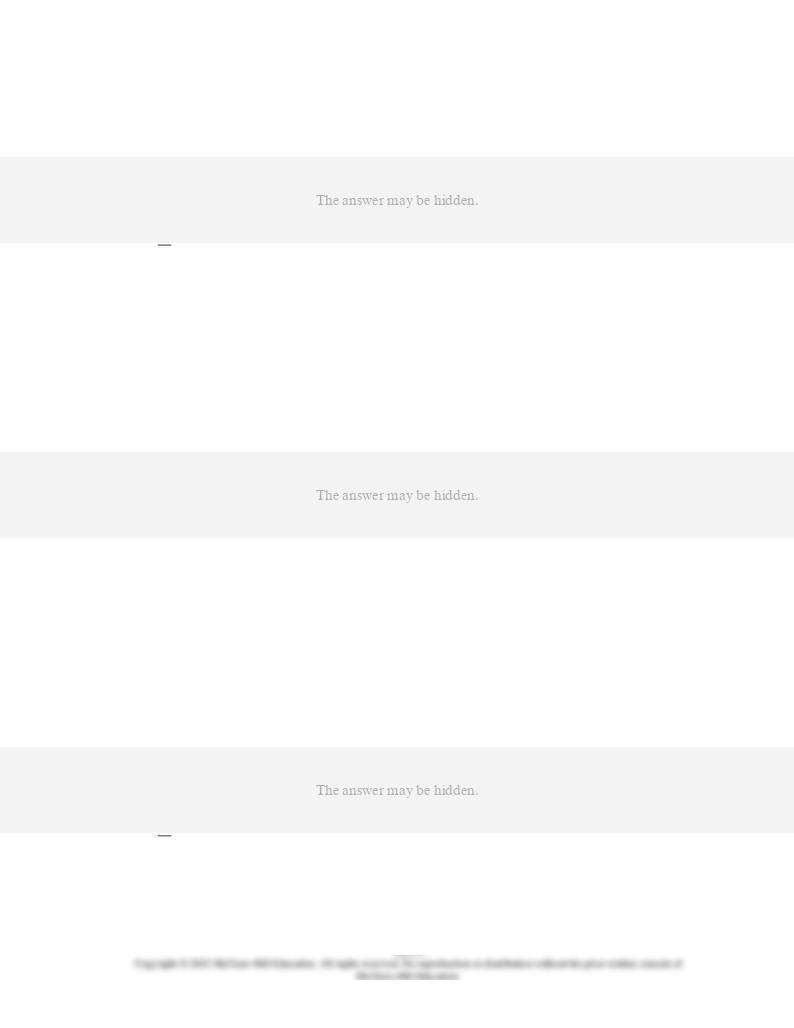
123.
A federal funds rate reduction that is caused by monetary policy will:
AACSB: Reflective Thinking
Accessibility: Keyboard Navigation
Blooms: Understand
Difficulty: 2 Medium
Learning Objective: 34-04 Describe the federal funds rate and how the Fed directly influences it.
Topic: Targeting the federal funds rate
124.
To reduce the federal funds rate, the Fed can:
AACSB: Reflective Thinking
Accessibility: Keyboard Navigation
Blooms: Understand
Difficulty: 2 Medium
Learning Objective: 34-04 Describe the federal funds rate and how the Fed directly influences it.
Topic: Targeting the federal funds rate
125.
Generally, the prime interest rate:
AACSB: Reflective Thinking
Accessibility: Keyboard Navigation
Blooms: Understand
Difficulty: 2 Medium
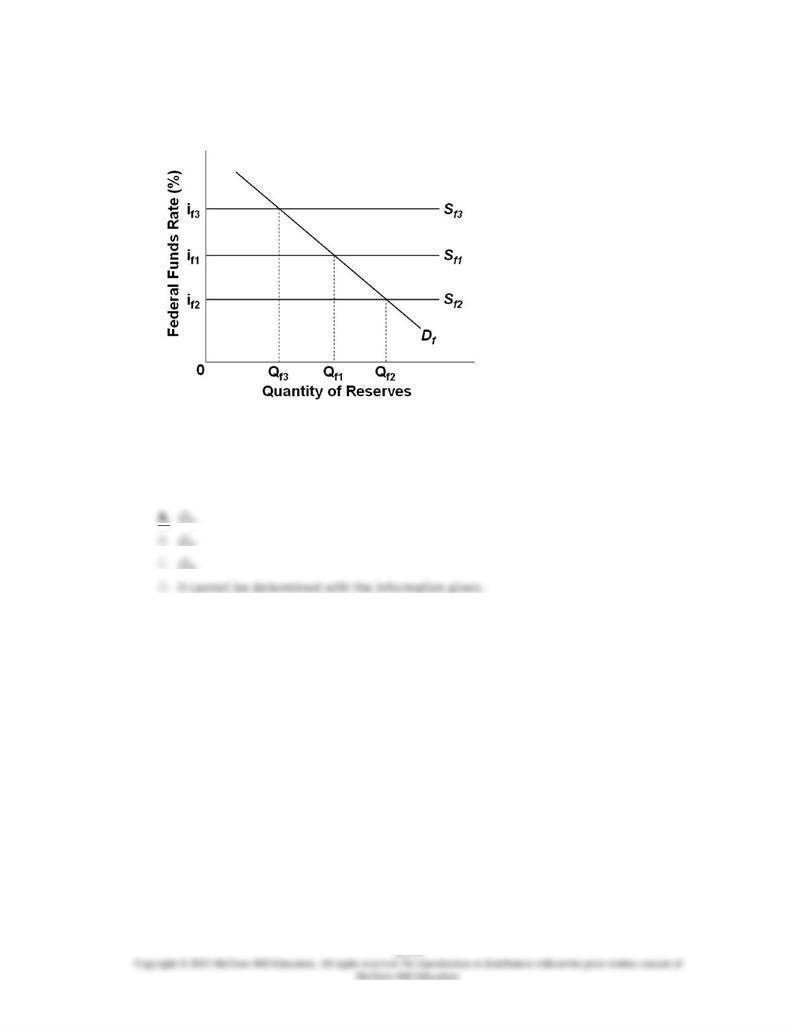
Learning Objective: 34-04 Describe the federal funds rate and how the Fed directly influences it.
Topic: Targeting the federal funds rate
126.
Refer to the given diagram for the federal funds market. If the Fed wants the federal funds
rate to be
if
1, what quantity of reserves do they need to make available to banks?
1.
2.
3.
AACSB: Reflective Thinking
Blooms: Analyze
Difficulty: 3 Hard
Learning Objective: 34-04 Describe the federal funds rate and how the Fed directly influences it.
Topic: Targeting the federal funds rate
Type: Graph

127.
Refer to the diagram for the federal funds market. If the Fed wants the federal funds rate
to fall from
if
1 to
if
2, it can use open-market operations to:
AACSB: Reflective Thinking
Blooms: Analyze
Difficulty: 3 Hard
Learning Objective: 34-04 Describe the federal funds rate and how the Fed directly influences it.
Topic: Targeting the federal funds rate
Type: Graph

128.
Refer to the diagram for the federal funds market. If the Fed wants to raise the federal
funds rate from
if
1 to
if
3, it should:
AACSB: Reflective Thinking
Blooms: Analyze
Difficulty: 3 Hard
Learning Objective: 34-04 Describe the federal funds rate and how the Fed directly influences it.
Topic: Targeting the federal funds rate
Type: Graph
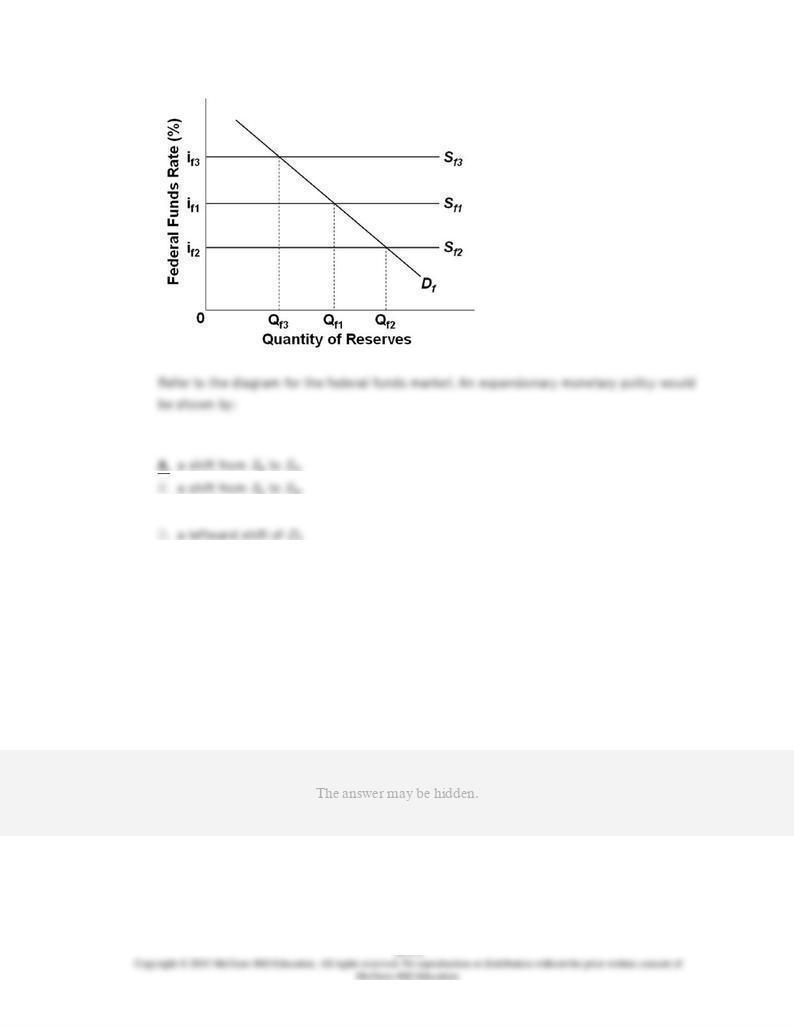
129.
3 to
2.
1 to
3.
C.
a rightward shift of
Df
.
AACSB: Reflective Thinking
Blooms: Apply
Difficulty: 2 Medium
Learning Objective: 34-04 Describe the federal funds rate and how the Fed directly influences it.
Topic: Targeting the federal funds rate
Type: Graph
130.
The demand for federal funds is:
AACSB: Reflective Thinking
Accessibility: Keyboard Navigation
Blooms: Remember
Difficulty: 1 Easy
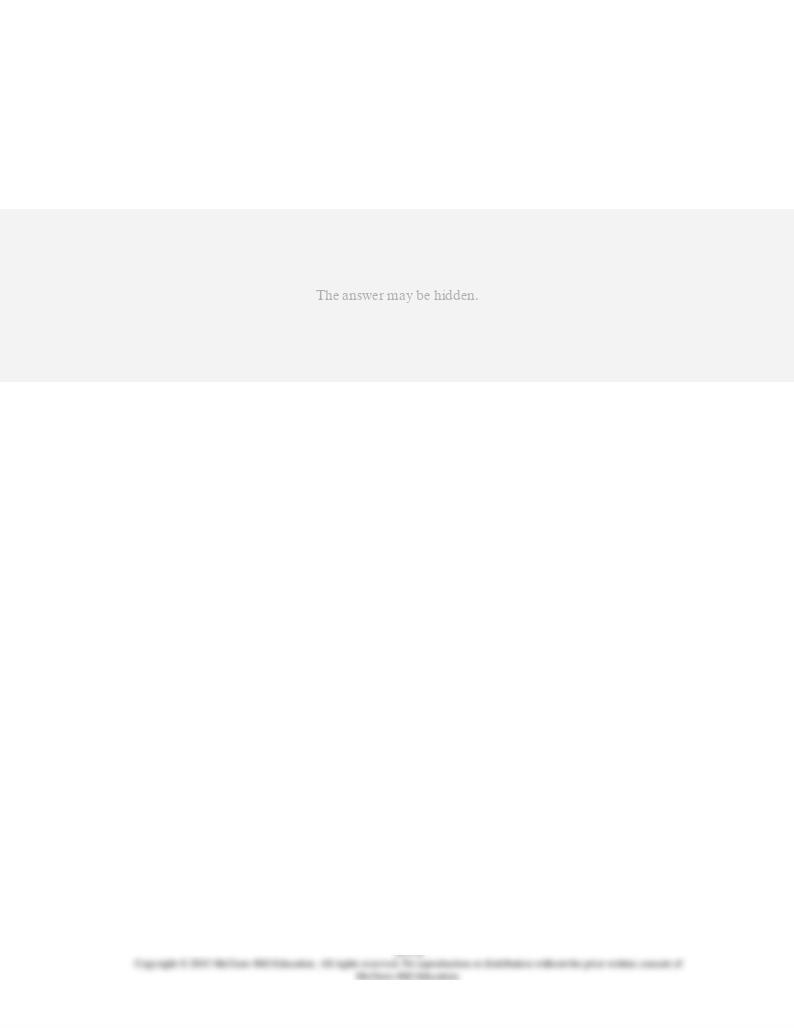
Learning Objective: 34-04 Describe the federal funds rate and how the Fed directly influences it.
Topic: Targeting the federal funds rate
131.
The demand for federal funds is
AACSB: Reflective Thinking
Accessibility: Keyboard Navigation
Blooms: Understand
Difficulty: 2 Medium
Learning Objective: 34-04 Describe the federal funds rate and how the Fed directly influences it.
Topic: Targeting the federal funds rate

132.
A.
6.0 percent.
B.
5.5 percent.
C.
5.0 percent.
AACSB: Analytic
Blooms: Analyze
Difficulty: 3 Hard
Learning Objective: 34-04 Describe the federal funds rate and how the Fed directly influences it.
Topic: Targeting the federal funds rate
Type: Graph
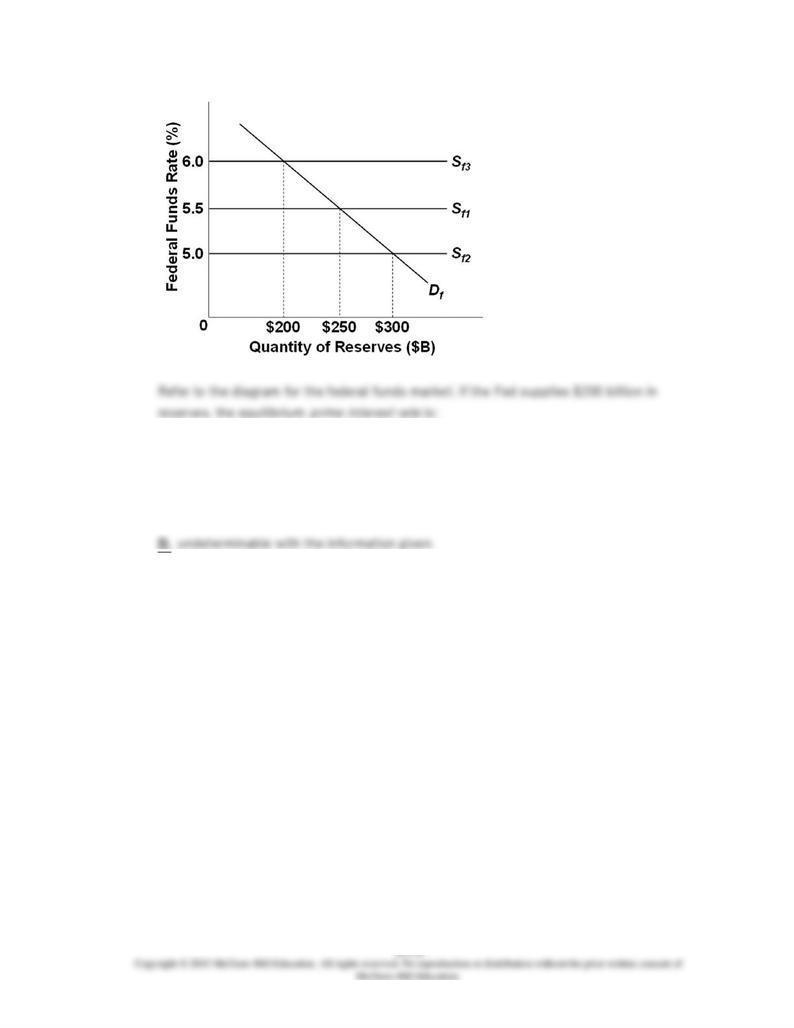
133.
A.
6.0 percent.
B.
5.5 percent.
C.
5.0 percent.
AACSB: Analytic
Blooms: Analyze
Difficulty: 3 Hard
Learning Objective: 34-04 Describe the federal funds rate and how the Fed directly influences it.
Topic: Targeting the federal funds rate
Type: Graph
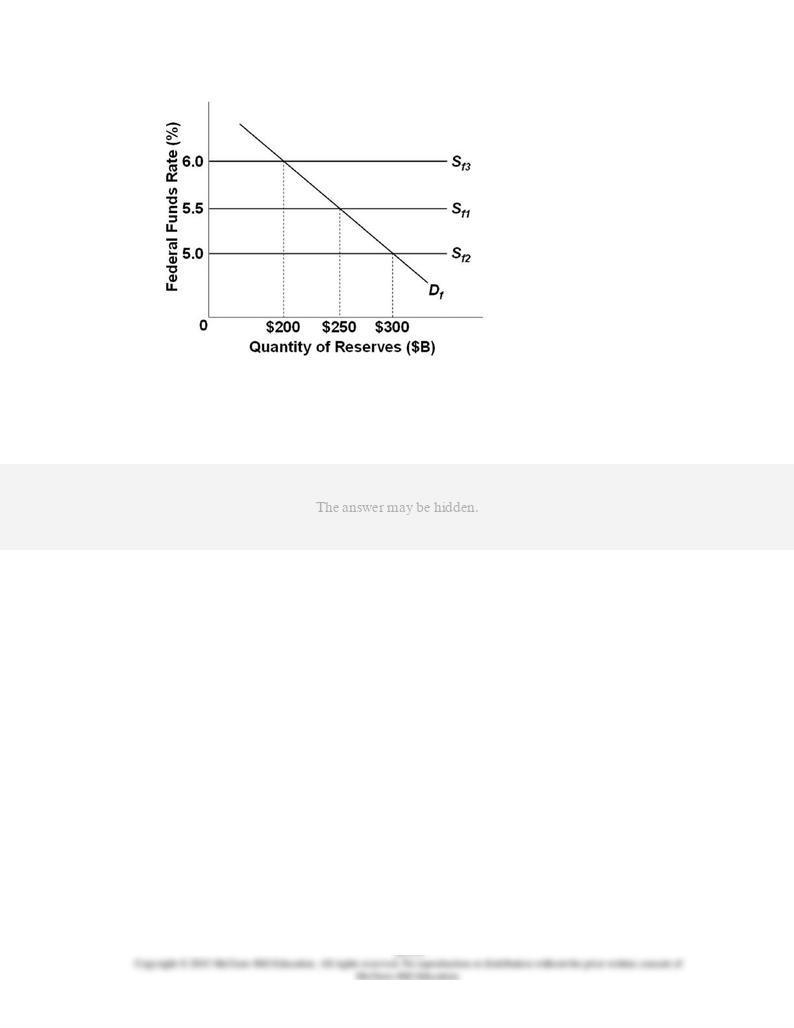
134.
Refer to the diagram for the federal funds market. If the Fed wants to increase reserves
from $200 billion to $300 billion it should:
AACSB: Analytic
Blooms: Apply
Difficulty: 2 Medium
Learning Objective: 34-04 Describe the federal funds rate and how the Fed directly influences it.
Topic: Targeting the federal funds rate
Type: Graph
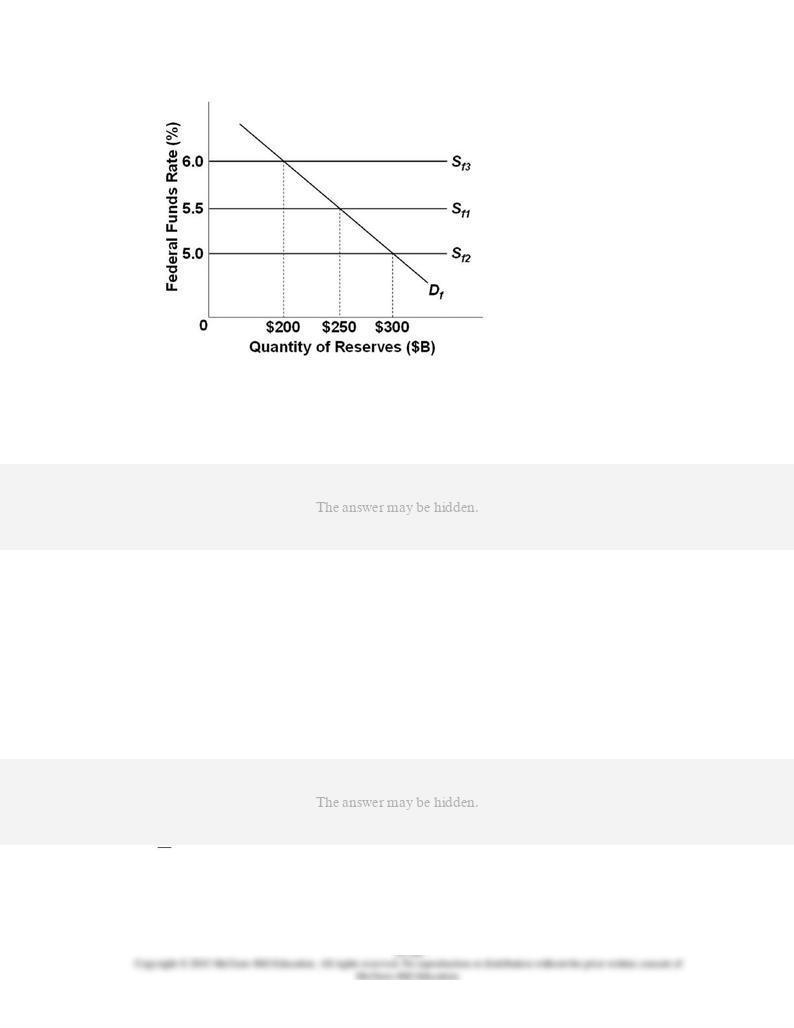
135.
Refer to the diagram for the federal funds market. If the Fed wants to raise the federal
funds rate by one-half of a percentage point, it should:
AACSB: Analytic
Blooms: Apply
Difficulty: 2 Medium
Learning Objective: 34-04 Describe the federal funds rate and how the Fed directly influences it.
Topic: Targeting the federal funds rate
Type: Graph
136.
Reserves borrowed at the federal funds rate are usually repaid:
AACSB: Analytic
Accessibility: Keyboard Navigation
Blooms: Remember
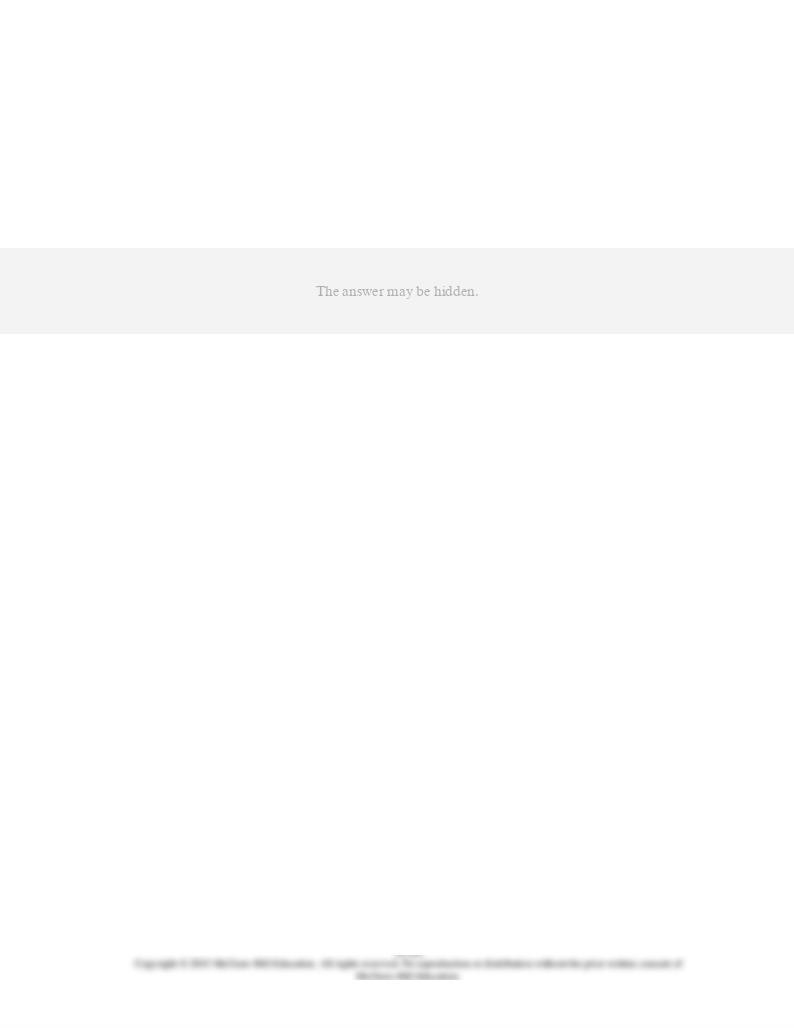
Difficulty: 1 Easy
Learning Objective: 34-04 Describe the federal funds rate and how the Fed directly influences it.
Topic: Targeting the federal funds rate
137.
The Fed's initial step in pursuing restrictive monetary policy using the federal funds rate is
to:
AACSB: Reflective Thinking
Accessibility: Keyboard Navigation
Blooms: Remember
Difficulty: 1 Easy
Learning Objective: 34-04 Describe the federal funds rate and how the Fed directly influences it.
Topic: Targeting the federal funds rate
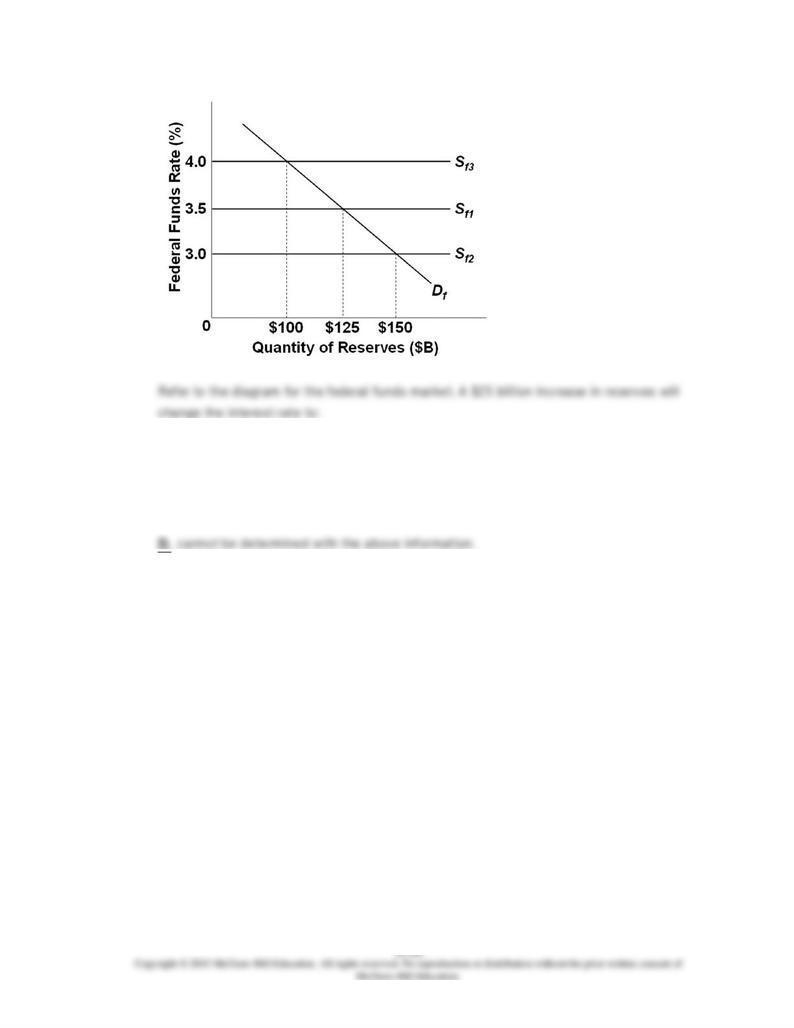
138.
A.
3.0 percent.
B.
3.5 percent.
C.
4.0 percent.
AACSB: Analytic
Blooms: Analyze
Difficulty: 3 Hard
Learning Objective: 34-04 Describe the federal funds rate and how the Fed directly influences it.
Topic: Targeting the federal funds rate
Type: Graph
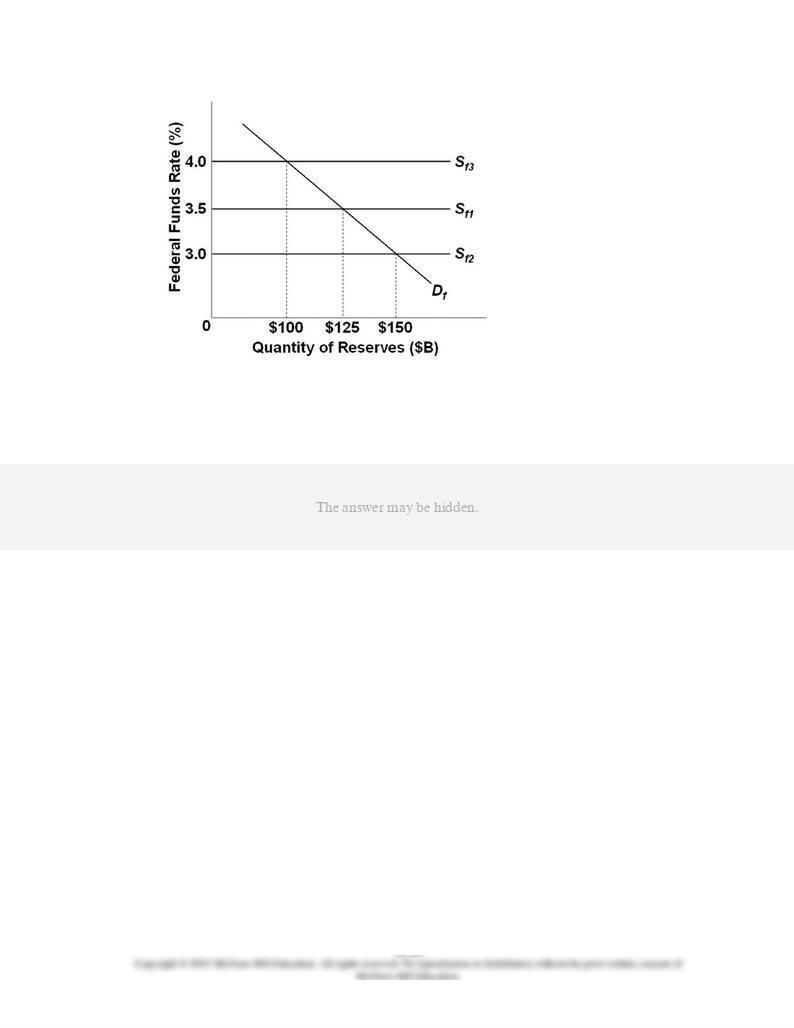
139.
Refer to the diagram for the federal funds market. If the federal funds rate rose from 3.5
percent to 4.0 percent, which of the following is the most likely explanation?
AACSB: Analytic
Blooms: Analyze
Difficulty: 3 Hard
Learning Objective: 34-04 Describe the federal funds rate and how the Fed directly influences it.
Topic: Targeting the federal funds rate
Type: Graph

140.
Refer to the diagram for the federal funds market. The equilibrium federal funds rate:
AACSB: Analytic
Blooms: Analyze
Difficulty: 3 Hard
Learning Objective: 34-04 Describe the federal funds rate and how the Fed directly influences it.
Topic: Targeting the federal funds rate
Type: Graph
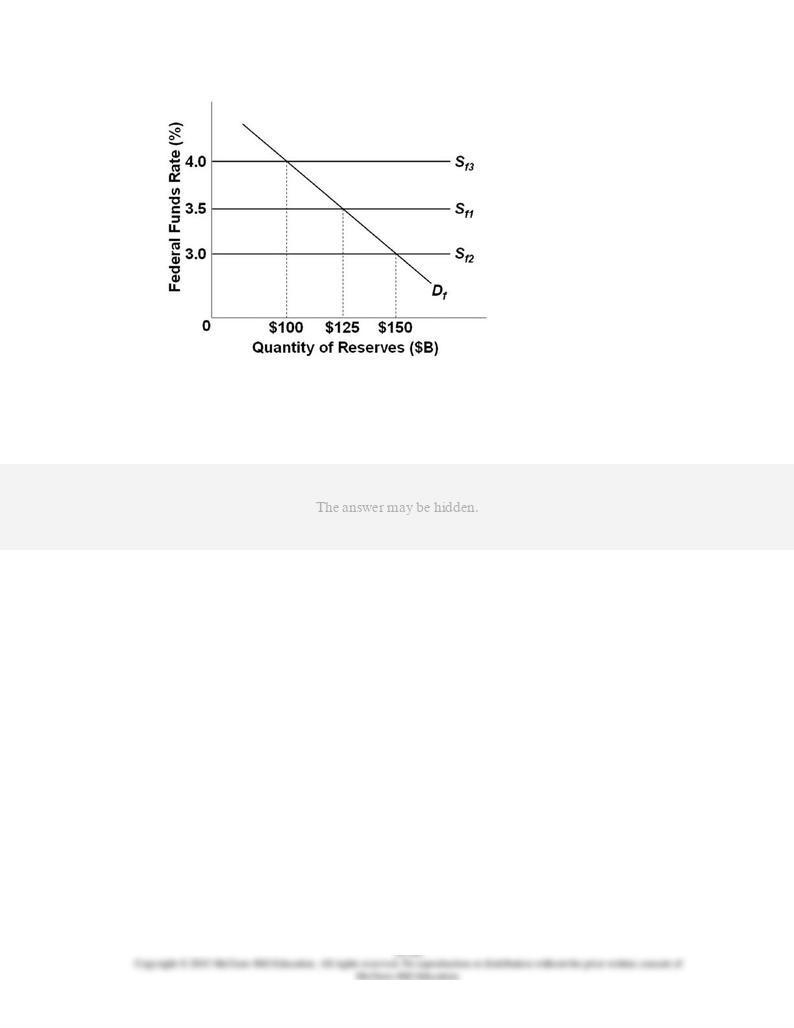
141.
Refer to the diagram for the federal funds market. If the quantity of reserves falls from
$150 billion to $125 billion, we can expect:
AACSB: Analytic
Blooms: Analyze
Difficulty: 3 Hard
Learning Objective: 34-04 Describe the federal funds rate and how the Fed directly influences it.
Topic: Targeting the federal funds rate
Type: Graph
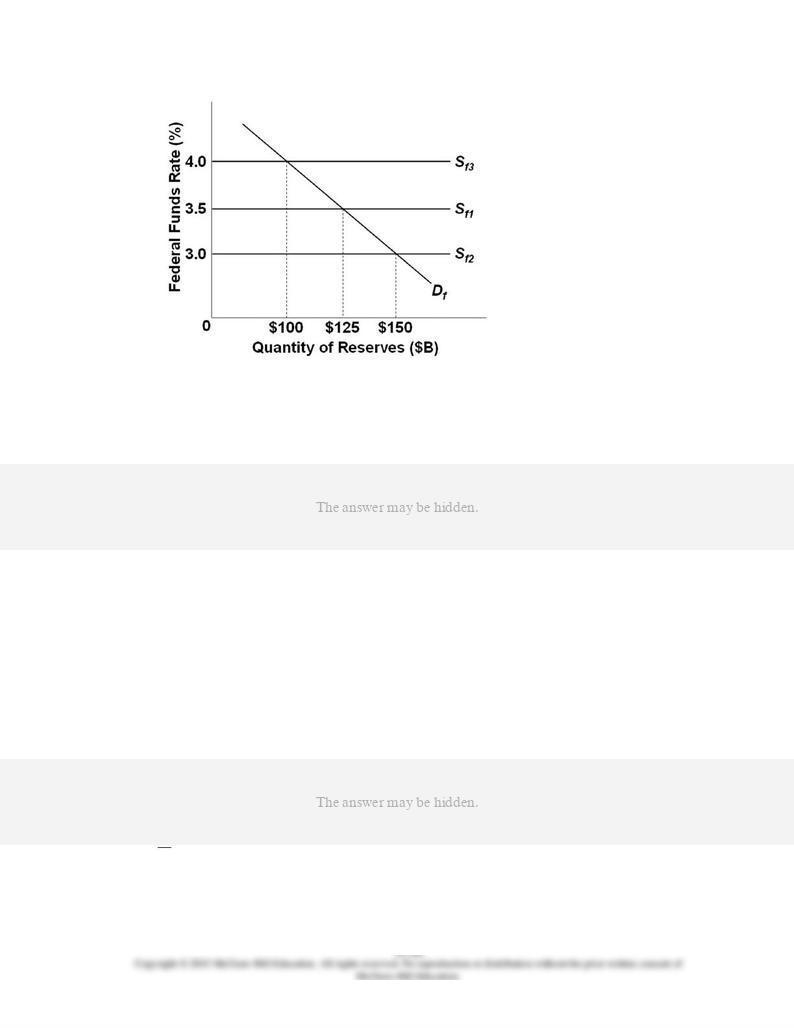
142.
Refer to the diagram for the federal funds market. If the quantity of reserves rises from
$100 billion to $150 billion, we can expect:
AACSB: Analytic
Blooms: Analyze
Difficulty: 3 Hard
Learning Objective: 34-04 Describe the federal funds rate and how the Fed directly influences it.
Topic: Targeting the federal funds rate
Type: Graph
143.
To increase the federal funds rate, the Fed can:
AACSB: Reflective Thinking
Accessibility: Keyboard Navigation
Blooms: Understand

Difficulty: 2 Medium
Learning Objective: 34-04 Describe the federal funds rate and how the Fed directly influences it.
Topic: Targeting the federal funds rate
144.
In recent years, the Fed has communicated changes in its monetary policy by announcing
changes in its policy targets for the:
AACSB: Reflective Thinking
Accessibility: Keyboard Navigation
Blooms: Remember
Difficulty: 1 Easy
Learning Objective: 34-04 Describe the federal funds rate and how the Fed directly influences it.
Topic: Targeting the federal funds rate
145.
The prime interest rate:
AACSB: Reflective Thinking
Accessibility: Keyboard Navigation
Blooms: Understand
Difficulty: 2 Medium
Learning Objective: 34-04 Describe the federal funds rate and how the Fed directly influences it.
Topic: Targeting the federal funds rate
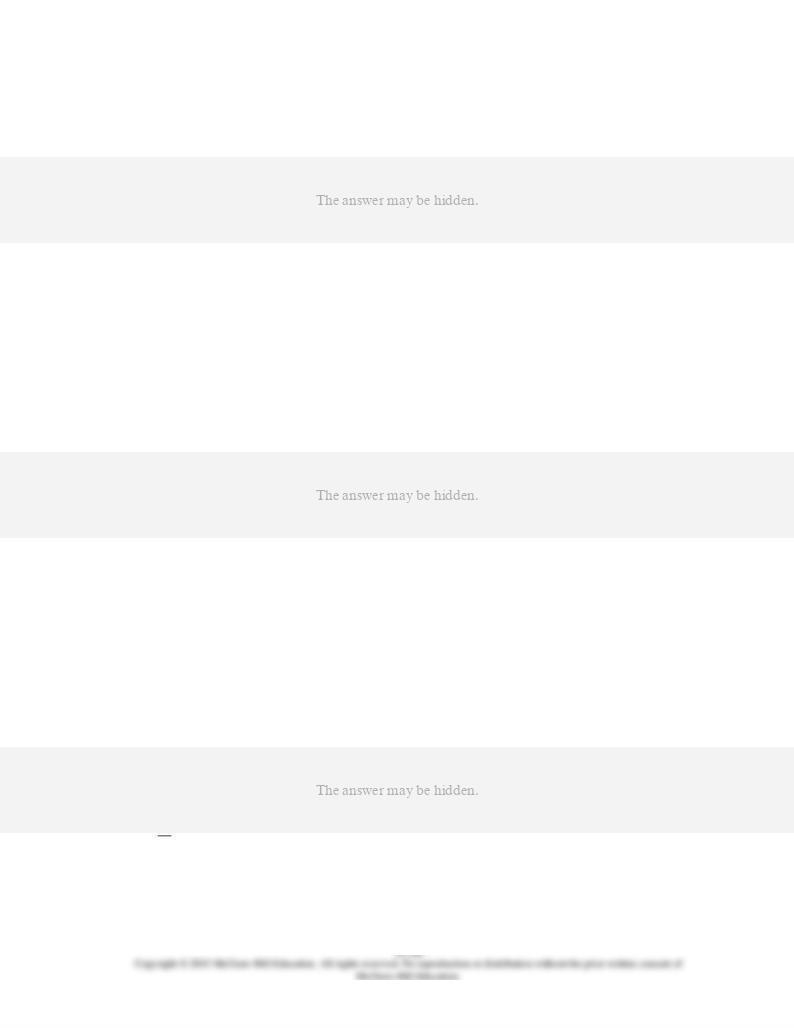
146.
The federal funds rate is:
AACSB: Reflective Thinking
Accessibility: Keyboard Navigation
Blooms: Remember
Difficulty: 1 Easy
Learning Objective: 34-04 Describe the federal funds rate and how the Fed directly influences it.
Topic: Targeting the federal funds rate
147.
If the Fed wants to lower the federal funds rate, it should:
AACSB: Reflective Thinking
Accessibility: Keyboard Navigation
Blooms: Understand
Difficulty: 2 Medium
Learning Objective: 34-04 Describe the federal funds rate and how the Fed directly influences it.
Topic: Targeting the federal funds rate
148.
Other things equal, which of the following would increase the federal funds rate?
AACSB: Reflective Thinking
Accessibility: Keyboard Navigation
Blooms: Understand
Difficulty: 2 Medium
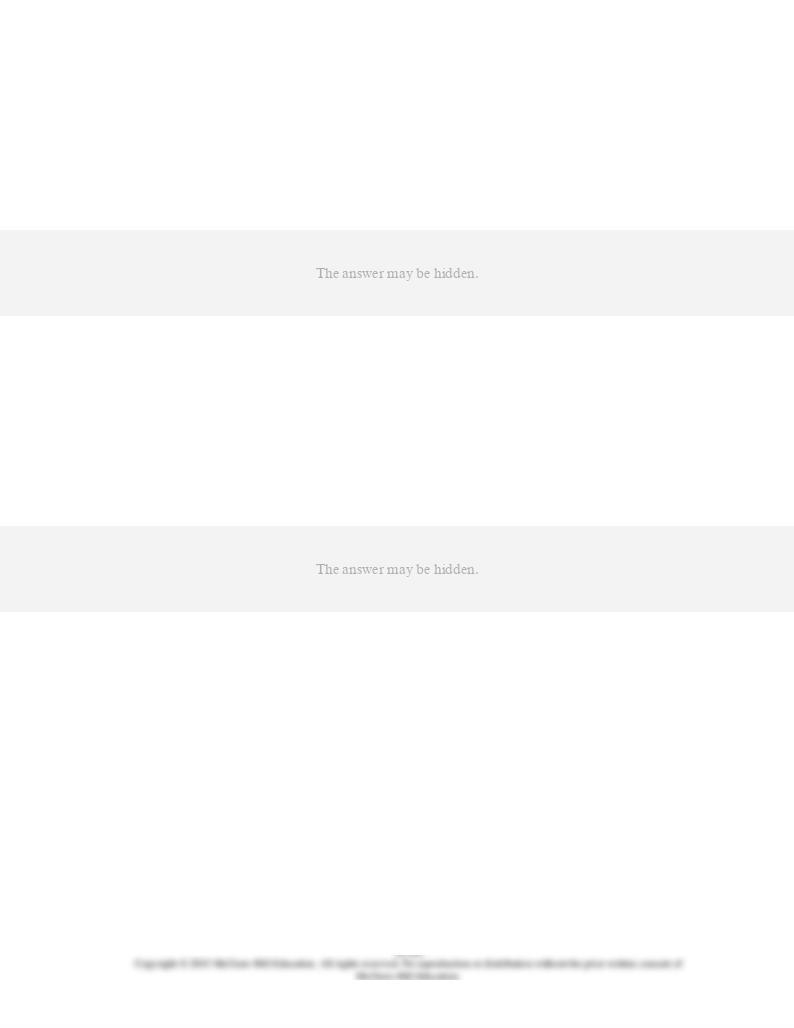
Learning Objective: 34-04 Describe the federal funds rate and how the Fed directly influences it.
Topic: Targeting the federal funds rate
149.
The benchmark interest rate that banks use as a reference point for a variety of consumer
and business loans is the:
AACSB: Analytic
Accessibility: Keyboard Navigation
Blooms: Remember
Difficulty: 1 Easy
Learning Objective: 34-04 Describe the federal funds rate and how the Fed directly influences it.
Topic: Targeting the federal funds rate
150.
The prime interest rate usually:
AACSB: Reflective Thinking
Accessibility: Keyboard Navigation
Blooms: Understand
Difficulty: 2 Medium
Learning Objective: 34-04 Describe the federal funds rate and how the Fed directly influences it.
Topic: Targeting the federal funds rate
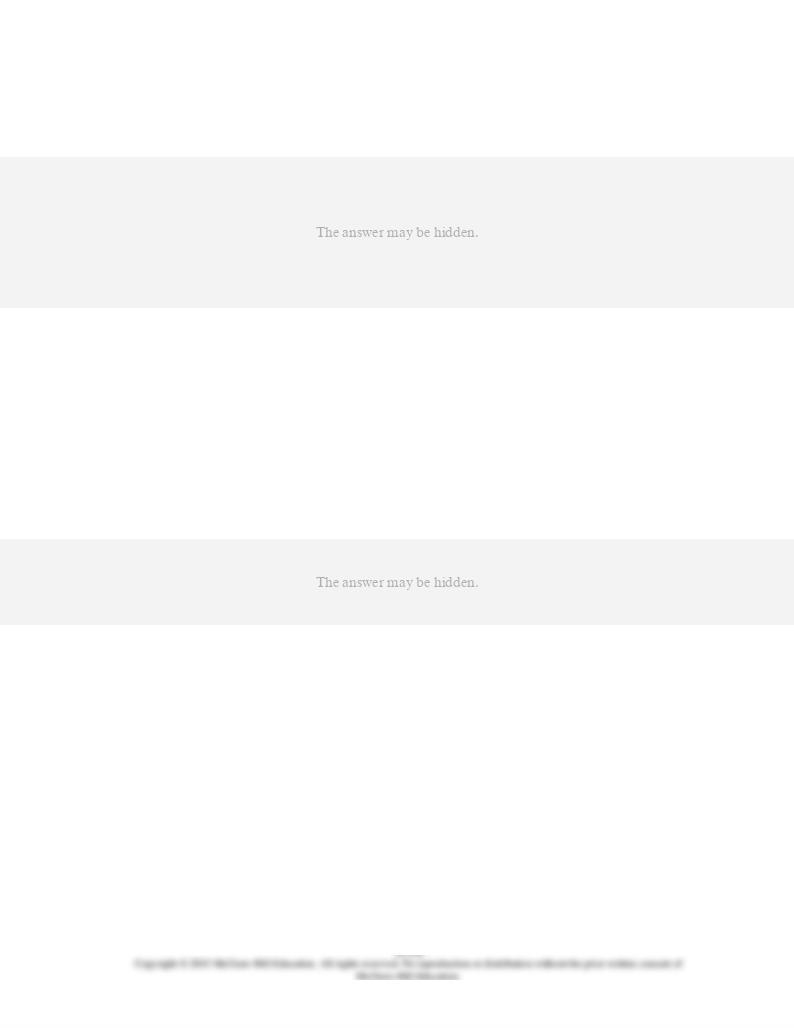
151.
According to the Taylor rule:
AACSB: Analytic
Accessibility: Keyboard Navigation
Blooms: Remember
Difficulty: 1 Easy
Learning Objective: 34-04 Describe the federal funds rate and how the Fed directly influences it.
Topic: Targeting the federal funds rate
152.
If the Fed were to set policy according to the Taylor rule, then if real GDP falls by 2
percent below potential GDP, the Fed should:
AACSB: Analytic
Accessibility: Keyboard Navigation
Blooms: Apply
Difficulty: 2 Medium
Learning Objective: 34-04 Describe the federal funds rate and how the Fed directly influences it.
Topic: Targeting the federal funds rate
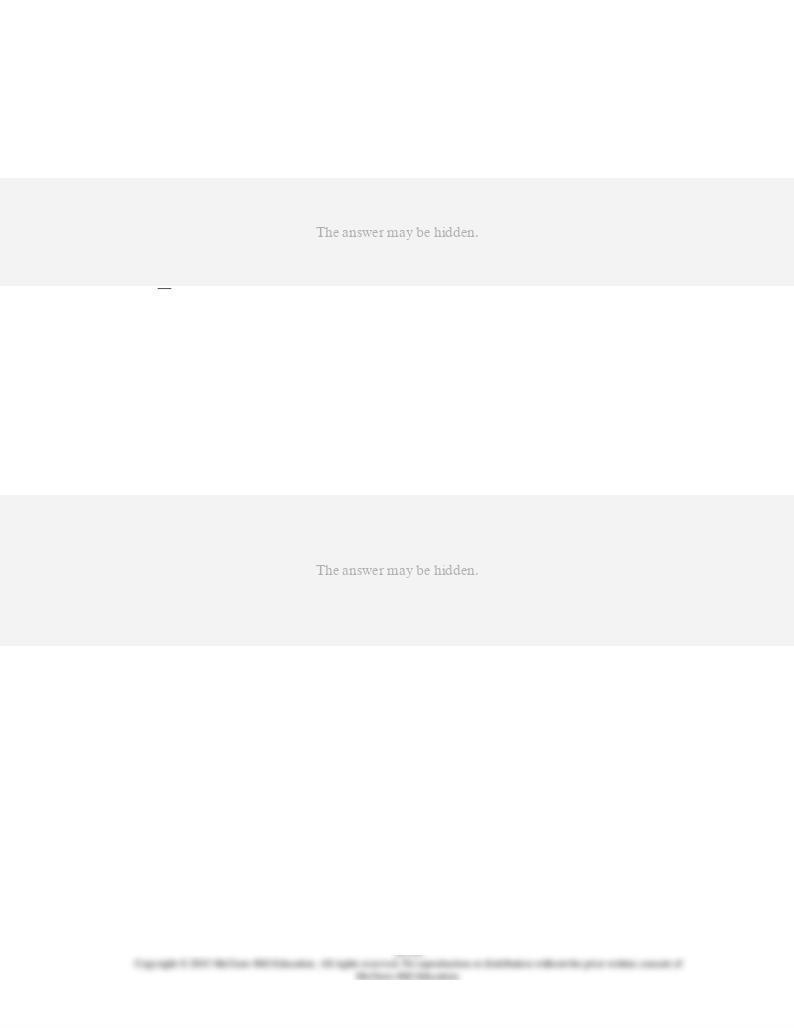
153.
According to the Taylor rule, when real GDP is at its potential and inflation is at its target
rate of 2 percent, the Fed should:
AACSB: Analytic
Accessibility: Keyboard Navigation
Blooms: Remember
Difficulty: 1 Easy
Learning Objective: 34-04 Describe the federal funds rate and how the Fed directly influences it.
Topic: Targeting the federal funds rate
154.
According to the Taylor rule:
AACSB: Analytic
Accessibility: Keyboard Navigation
Blooms: Remember
Difficulty: 1 Easy
Learning Objective: 34-04 Describe the federal funds rate and how the Fed directly influences it.
Topic: Targeting the federal funds rate
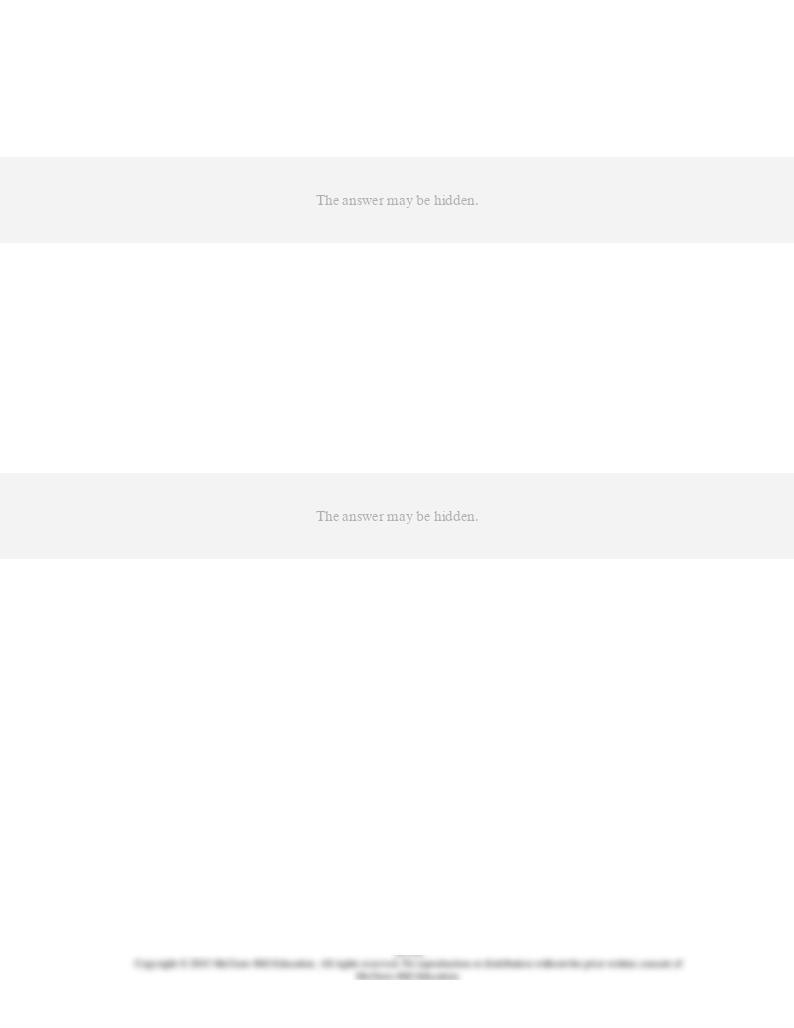
155.
According to the Taylor rule, if real GDP is 4 percent below potential GDP, the Fed should:
AACSB: Analytic
Accessibility: Keyboard Navigation
Blooms: Apply
Difficulty: 2 Medium
Learning Objective: 34-04 Describe the federal funds rate and how the Fed directly influences it.
Topic: Targeting the federal funds rate
156.
According to the Taylor rule, if inflation has risen by 6 percentage points above its target
of 2 percent, the Fed should:
AACSB: Analytic
Accessibility: Keyboard Navigation
Blooms: Apply
Difficulty: 2 Medium
Learning Objective: 34-04 Describe the federal funds rate and how the Fed directly influences it.
Topic: Targeting the federal funds rate
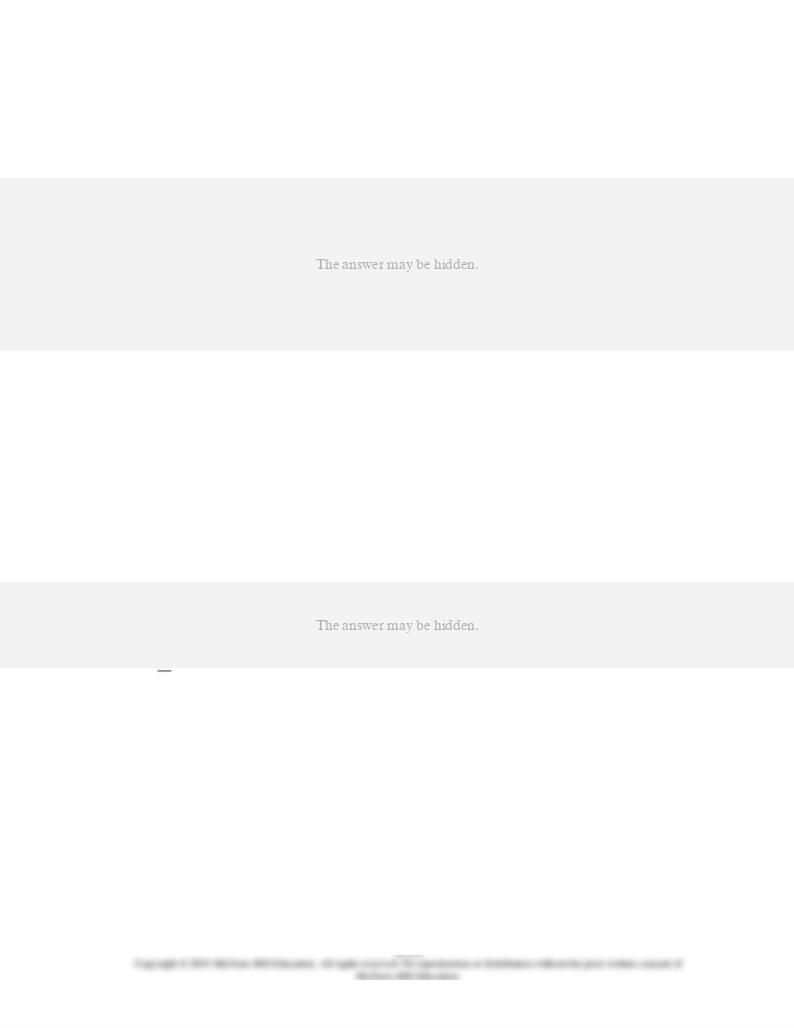
157.
Which of the following best describes the cause-effect chain of an expansionary monetary
policy?
AACSB: Reflective Thinking
Accessibility: Keyboard Navigation
Blooms: Understand
Difficulty: 2 Medium
Learning Objective: 34-05 Identify the mechanisms by which monetary policy affects GDP and the price level.
Topic: Monetary policy, real GDP, and the price level
158.
Upon which of the following industries is a restrictive monetary policy likely to be most
effective?
AACSB: Reflective Thinking
Accessibility: Keyboard Navigation
Blooms: Apply
Difficulty: 2 Medium
Learning Objective: 34-05 Identify the mechanisms by which monetary policy affects GDP and the price level.
Topic: Monetary policy, real GDP, and the price level
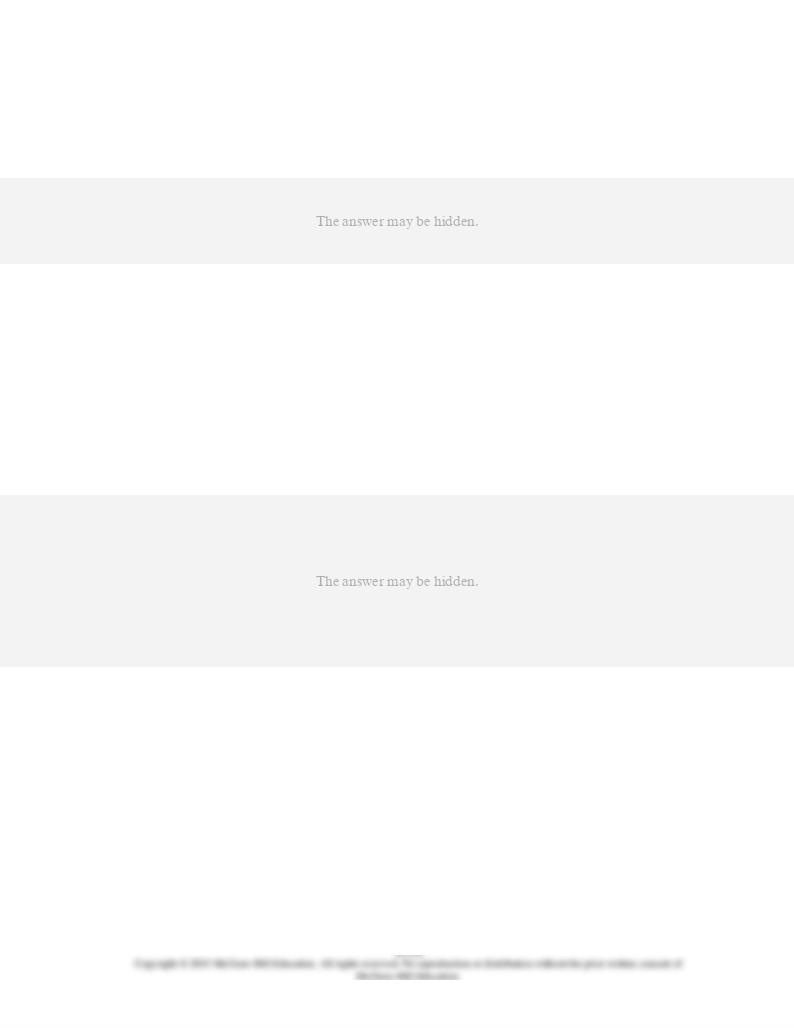
159.
Assuming government wishes to either increase or decrease the level of aggregate
demand, which of the following pairs are
not
consistent policy measures?
AACSB: Reflective Thinking
Accessibility: Keyboard Navigation
Blooms: Understand
Difficulty: 2 Medium
Learning Objective: 34-05 Identify the mechanisms by which monetary policy affects GDP and the price level.
Topic: Monetary policy, real GDP, and the price level
160.
If the Federal Reserve authorities were attempting to reduce demand-pull inflation, the
proper policies would be to:
AACSB: Reflective Thinking
Accessibility: Keyboard Navigation
Blooms: Apply
Difficulty: 2 Medium
Learning Objective: 34-05 Identify the mechanisms by which monetary policy affects GDP and the price level.
Topic: Monetary policy, real GDP, and the price level

161.
A contraction of the money supply:
AACSB: Reflective Thinking
Accessibility: Keyboard Navigation
Blooms: Understand
Difficulty: 2 Medium
Learning Objective: 34-05 Identify the mechanisms by which monetary policy affects GDP and the price level.
Topic: Monetary policy, real GDP, and the price level
162.
The purpose of a restrictive monetary policy is to:
AACSB: Reflective Thinking
Accessibility: Keyboard Navigation
Blooms: Understand
Difficulty: 2 Medium
Learning Objective: 34-05 Identify the mechanisms by which monetary policy affects GDP and the price level.
Topic: Monetary policy, real GDP, and the price level
163.
Monetary policy is expected to have its greatest impact on:
AACSB: Reflective Thinking
Accessibility: Keyboard Navigation
Blooms: Understand
Difficulty: 2 Medium
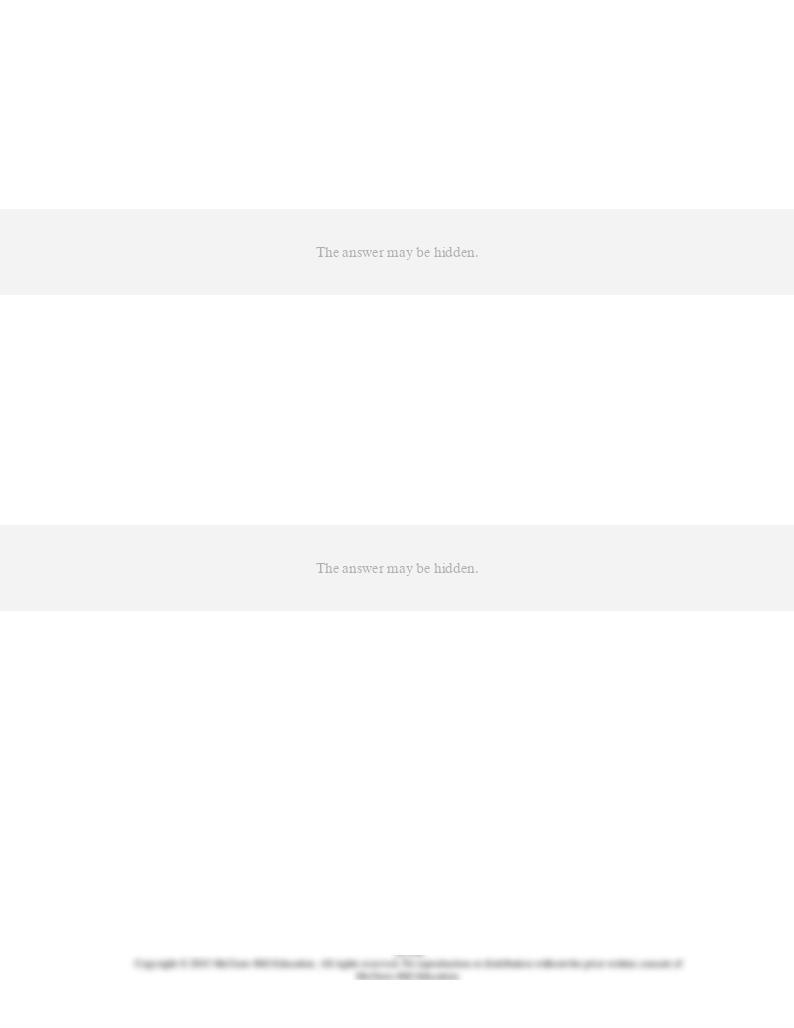
Learning Objective: 34-05 Identify the mechanisms by which monetary policy affects GDP and the price level.
Topic: Monetary policy, real GDP, and the price level
164.
Which of the following actions by the Fed would cause the money supply to increase?
AACSB: Reflective Thinking
Accessibility: Keyboard Navigation
Blooms: Understand
Difficulty: 2 Medium
Learning Objective: 34-05 Identify the mechanisms by which monetary policy affects GDP and the price level.
Topic: Monetary policy, real GDP, and the price level
165.
Assume the economy is operating at less than full employment. An expansionary monetary
policy will cause interest rates to ________, which will ___________ investment spending.
AACSB: Reflective Thinking
Accessibility: Keyboard Navigation
Blooms: Analyze
Difficulty: 3 Hard
Learning Objective: 34-05 Identify the mechanisms by which monetary policy affects GDP and the price level.
Topic: Monetary policy, real GDP, and the price level

166.
Which of the following best describes the cause-effect chain of a restrictive monetary
policy?
AACSB: Reflective Thinking
Accessibility: Keyboard Navigation
Blooms: Understand
Difficulty: 2 Medium
Learning Objective: 34-05 Identify the mechanisms by which monetary policy affects GDP and the price level.
Topic: Monetary policy, real GDP, and the price level
167.
If the economy were encountering a severe recession, proper monetary and fiscal policies
would call for:
AACSB: Reflective Thinking
Accessibility: Keyboard Navigation
Blooms: Analyze
Difficulty: 3 Hard
Learning Objective: 34-05 Identify the mechanisms by which monetary policy affects GDP and the price level.
Topic: Monetary policy, real GDP, and the price level
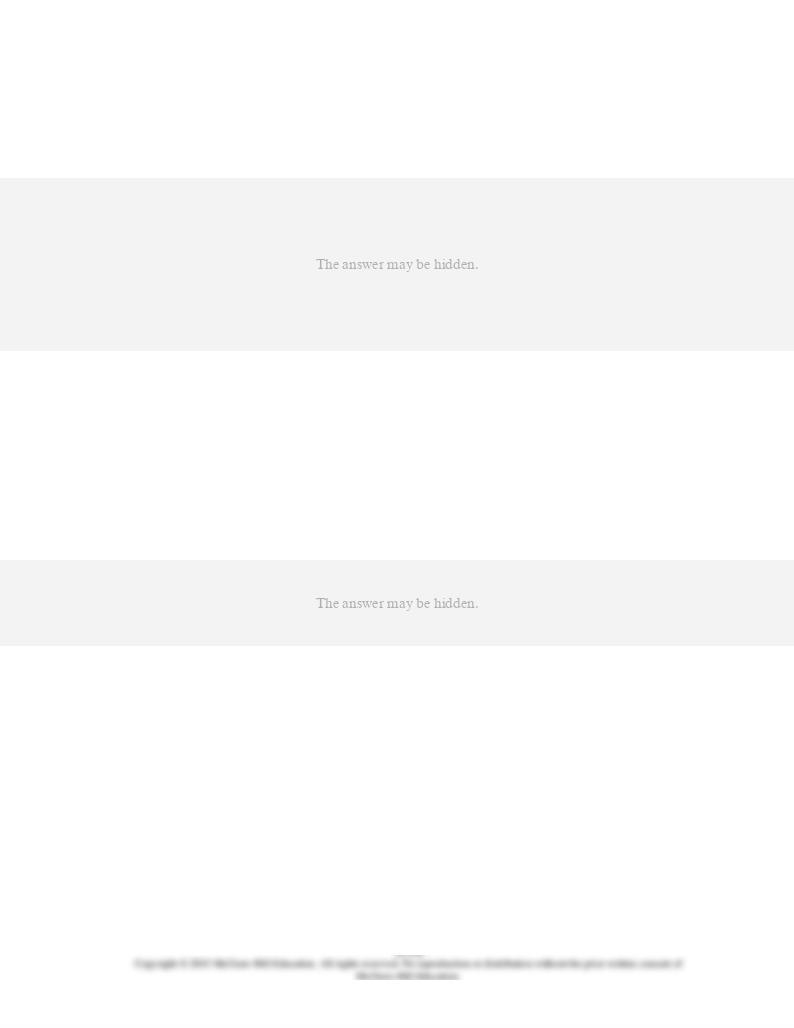
168.
If severe demand-pull inflation was occurring in the economy, proper government policies
would involve a government:
AACSB: Reflective Thinking
Accessibility: Keyboard Navigation
Blooms: Analyze
Difficulty: 3 Hard
Learning Objective: 34-05 Identify the mechanisms by which monetary policy affects GDP and the price level.
Topic: Monetary policy, real GDP, and the price level
169.
If the amount of money demanded exceeds the amount supplied, the:
AACSB: Reflective Thinking
Accessibility: Keyboard Navigation
Blooms: Analyze
Difficulty: 3 Hard
Learning Objective: 34-05 Identify the mechanisms by which monetary policy affects GDP and the price level.
Topic: Monetary policy, real GDP, and the price level

170.
Refer to the diagrams. The numbers in parentheses after the AD1, AD2, and AD3, labels
indicate the levels of investment spending associated with each curve, respectively. All
numbers are in billions of dollars. If the interest rate is 8 percent and the goal of the Fed is
full-employment output of
Qf
, it should:
AACSB: Analytic
Blooms: Analyze
Difficulty: 3 Hard
Learning Objective: 34-05 Identify the mechanisms by which monetary policy affects GDP and the price level.
Topic: Monetary policy, real GDP, and the price level
Type: Graph
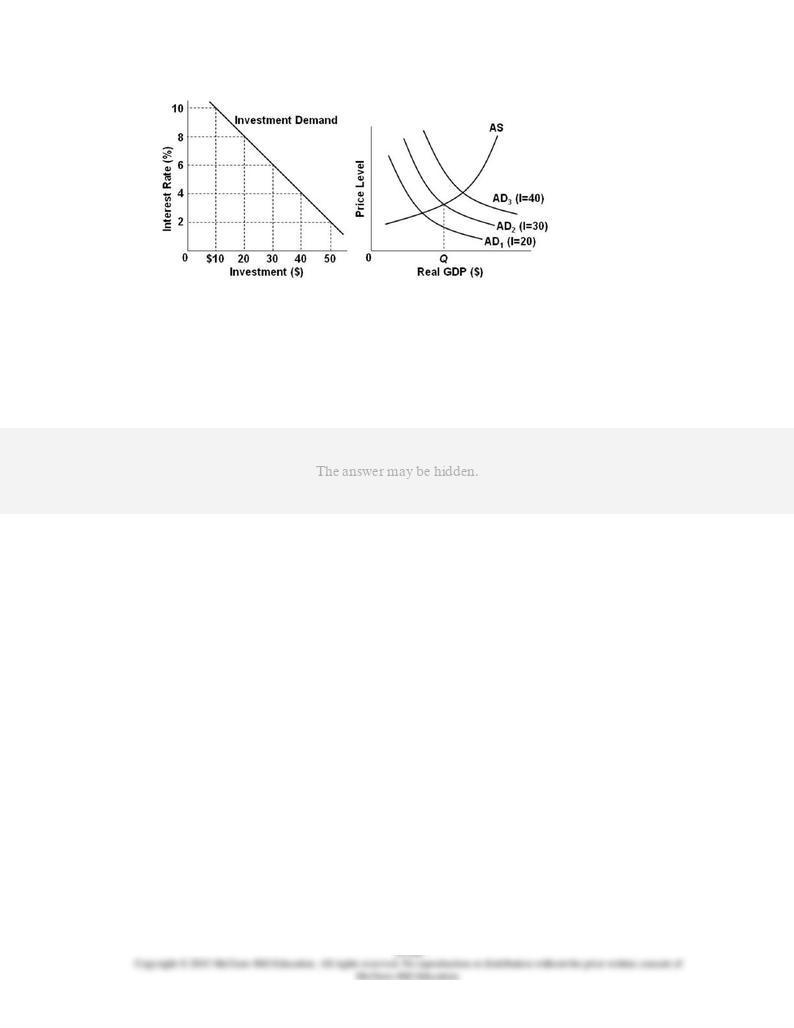
171.
Refer to the diagrams. The numbers in parentheses after the AD1, AD2, and AD3 labels
indicate the levels of investment spending associated with each curve, respectively. All
numbers are in billions of dollars. If the interest rate is 4 percent and the Fed desires to
reduce or eliminate demand-pull inflation, it should:
AACSB: Analytic
Blooms: Analyze
Difficulty: 3 Hard
Learning Objective: 34-05 Identify the mechanisms by which monetary policy affects GDP and the price level.
Topic: Monetary policy, real GDP, and the price level
Type: Graph
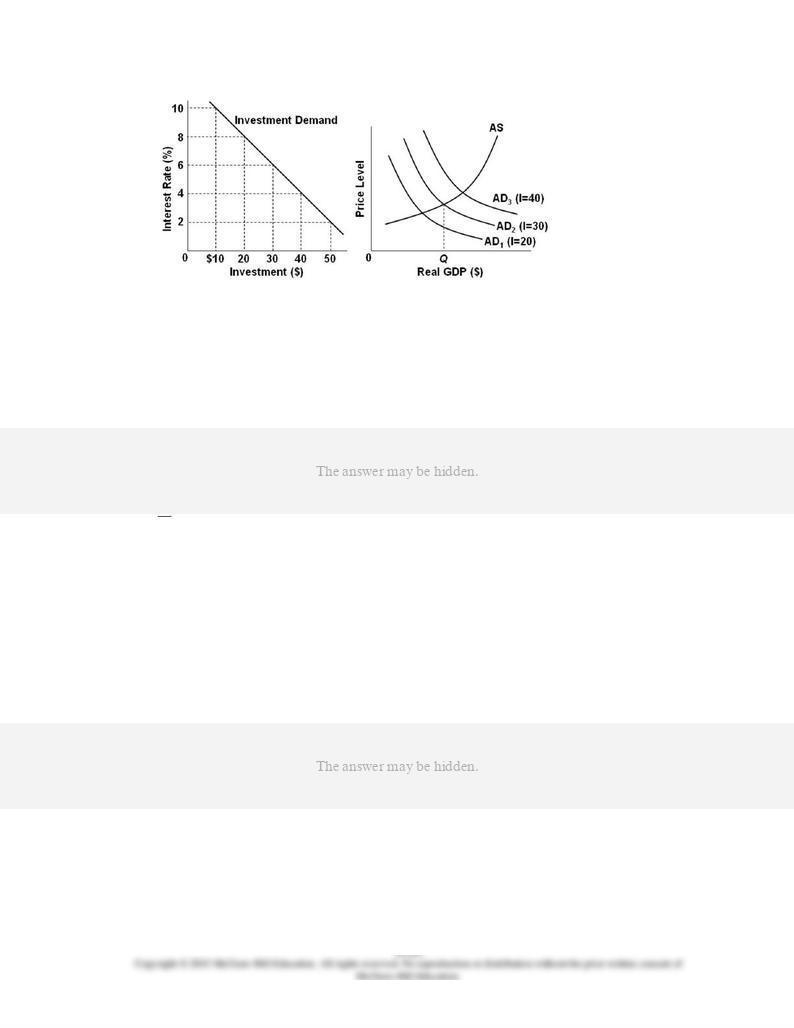
172.
Refer to the diagrams. The numbers in parentheses after the AD1, AD2, and AD3 labels
indicate the levels of investment spending associated with each curve, respectively. All
numbers are in billions of dollars. If the interest rate is 6 percent and the goal of the Fed is
full-employment output of
Qf
, it should:
AACSB: Analytic
Blooms: Analyze
Difficulty: 3 Hard
Learning Objective: 34-05 Identify the mechanisms by which monetary policy affects GDP and the price level.
Topic: Monetary policy, real GDP, and the price level
Type: Graph
173.
The purpose of an expansionary monetary policy is to shift the:
AACSB: Reflective Thinking
Accessibility: Keyboard Navigation
Blooms: Understand
Difficulty: 2 Medium
Learning Objective: 34-05 Identify the mechanisms by which monetary policy affects GDP and the price level.
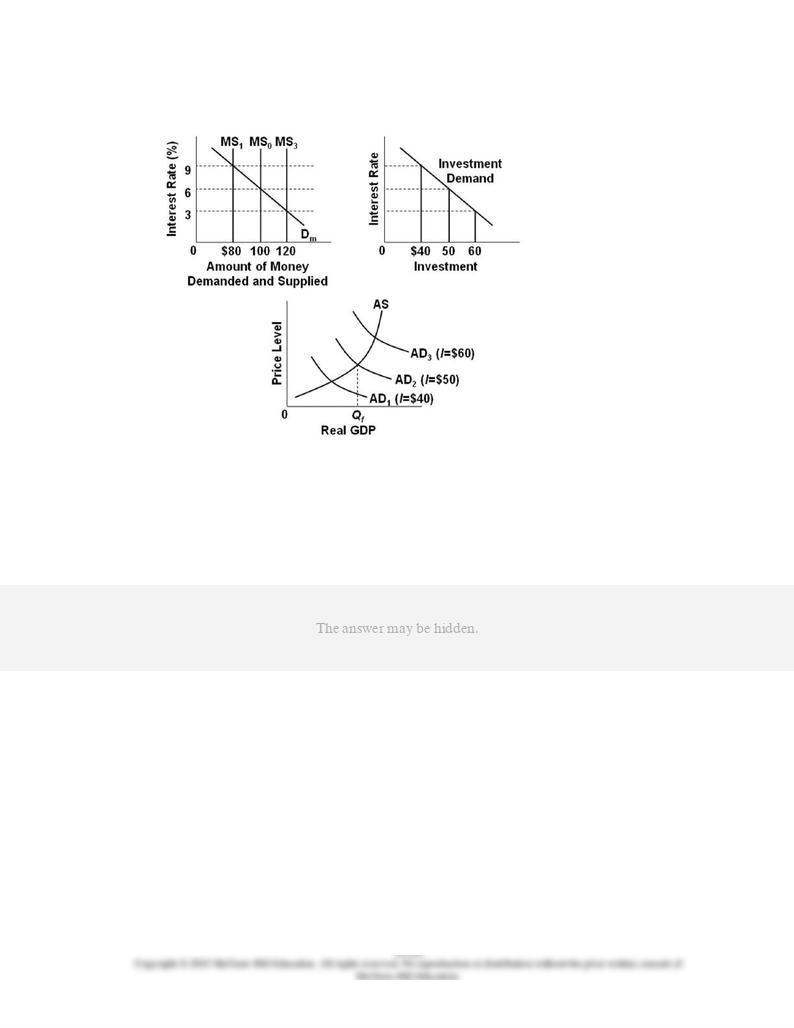
Topic: Monetary policy, real GDP, and the price level
174.
Refer to the diagrams. The numbers in parentheses after the AD1, AD2, and AD3 labels
indicate the levels of investment spending associated with each curve. All figures are in
billions. If the money supply is MS1 and the goal of the monetary authorities is full-
employment output
Qf
, they should:
AACSB: Analytic
Blooms: Analyze
Difficulty: 3 Hard
Learning Objective: 34-05 Identify the mechanisms by which monetary policy affects GDP and the price level.
Topic: Monetary policy, real GDP, and the price level
Type: Graph

175.
Refer to the diagrams. The numbers in parentheses after the AD1, AD2, and AD3 labels
indicate the levels of investment spending associated with each curve. All figures are in
billions. If aggregate demand is AD3 and the monetary authorities desire to reduce it to
AD2, they should:
AACSB: Analytic
Blooms: Analyze
Difficulty: 3 Hard
Learning Objective: 34-05 Identify the mechanisms by which monetary policy affects GDP and the price level.
Topic: Monetary policy, real GDP, and the price level
Type: Graph

176.
Refer to the diagrams. The numbers in parentheses after the AD1, AD2, and AD3 labels
indicate the levels of investment spending associated with each curve. All figures are in
billions. Which of the following would shift the money supply curve from MS1 to MS3?
AACSB: Reflective Thinking
Blooms: Apply
Difficulty: 2 Medium
Learning Objective: 34-05 Identify the mechanisms by which monetary policy affects GDP and the price level.
Topic: Monetary policy, real GDP, and the price level
Type: Graph
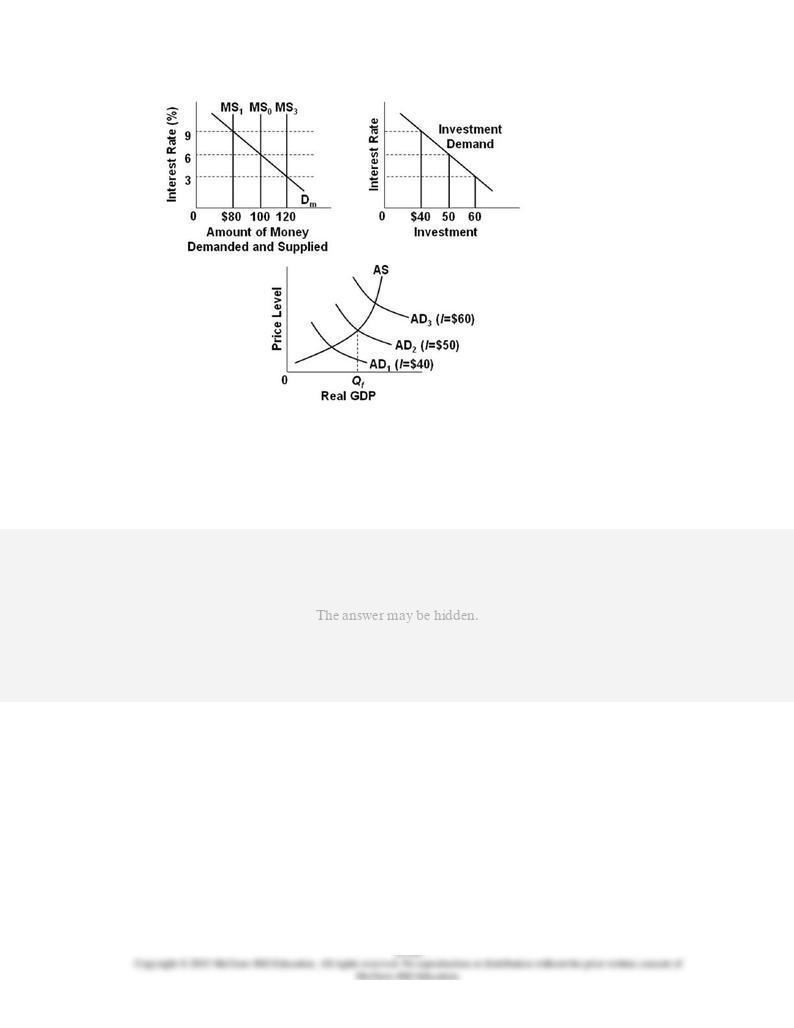
177.
Refer to the diagrams. The numbers in parentheses after the AD1, AD2, and AD3 labels
indicate the levels of investment spending associated with each curve. All figures are in
billions. If the MPC for the economy described by the figures is 0.8:
AACSB: Analytic
Blooms: Analyze
Difficulty: 3 Hard
Learning Objective: 34-05 Identify the mechanisms by which monetary policy affects GDP and the price level.
Topic: Monetary policy, real GDP, and the price level
Type: Graph
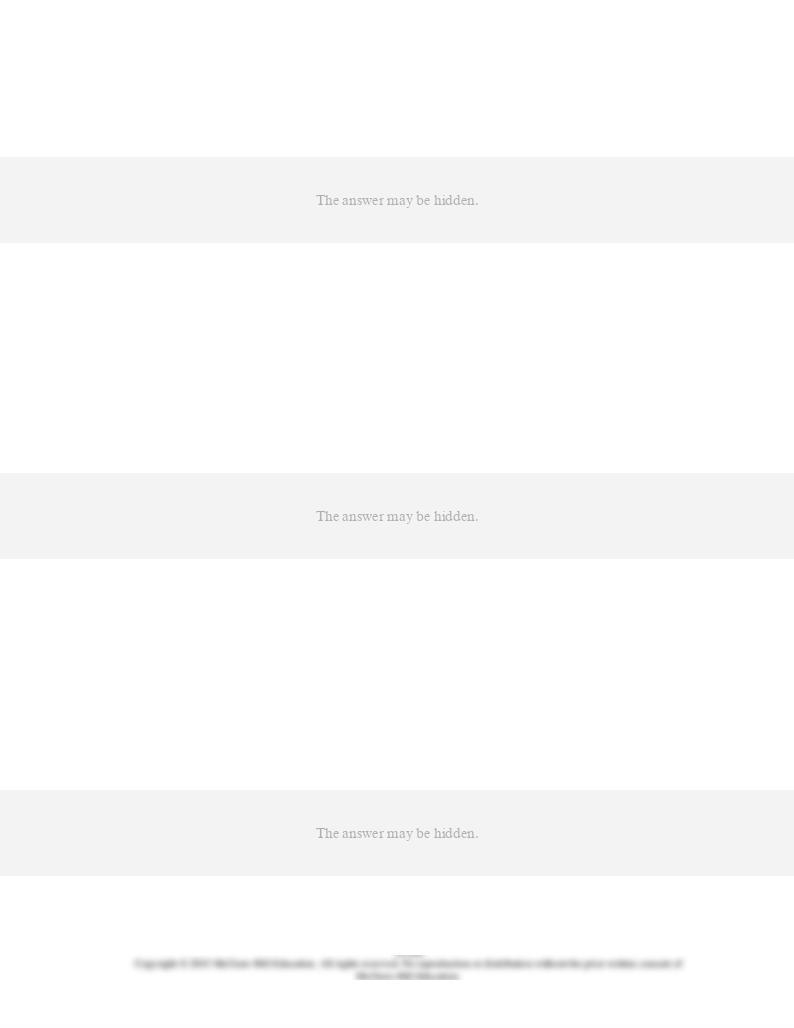
178.
An increase in the money supply will:
AACSB: Reflective Thinking
Accessibility: Keyboard Navigation
Blooms: Understand
Difficulty: 2 Medium
Learning Objective: 34-05 Identify the mechanisms by which monetary policy affects GDP and the price level.
Topic: Monetary policy, real GDP, and the price level
179.
All else equal, when the Federal Reserve Banks engage in a restrictive monetary policy,
the prices of government bonds usually:
AACSB: Reflective Thinking
Accessibility: Keyboard Navigation
Blooms: Understand
Difficulty: 2 Medium
Learning Objective: 34-05 Identify the mechanisms by which monetary policy affects GDP and the price level.
Topic: Monetary policy, real GDP, and the price level
180.
All else equal, when the Federal Reserve Banks engage in an expansionary monetary
policy, the interest rates received on government bonds usually:
AACSB: Reflective Thinking
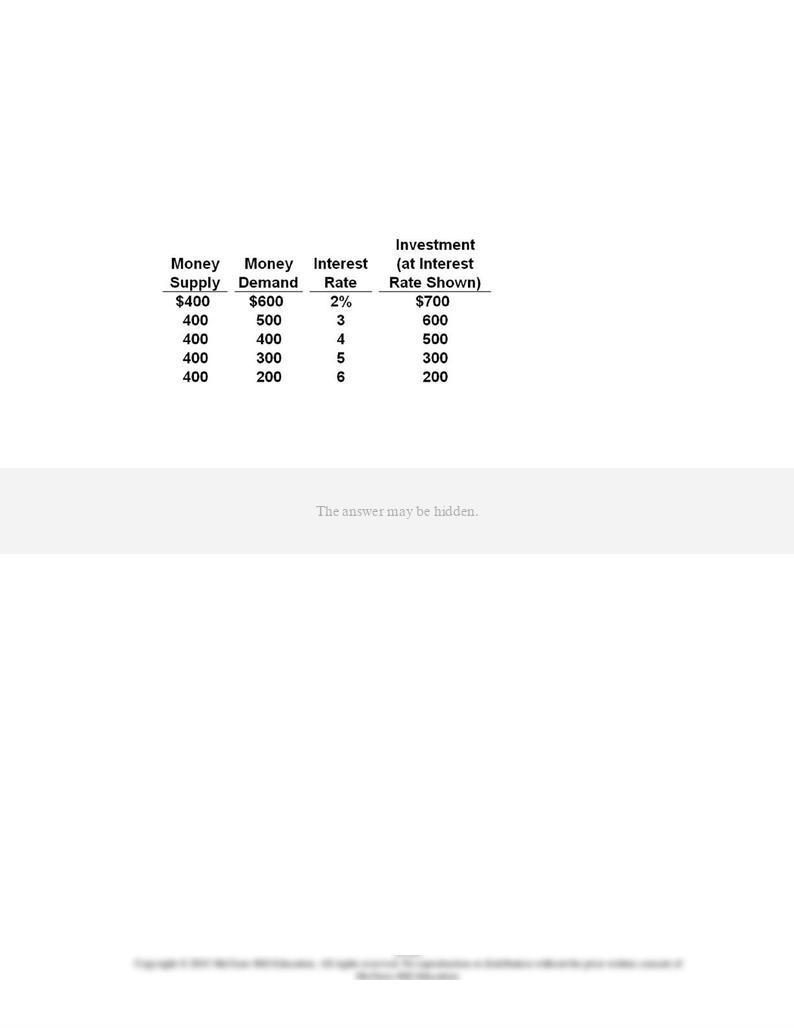
Accessibility: Keyboard Navigation
Blooms: Understand
Difficulty: 2 Medium
Learning Objective: 34-05 Identify the mechanisms by which monetary policy affects GDP and the price level.
Topic: Monetary policy, real GDP, and the price level
181.
Answer the question on the basis of the information in the following table.
Refer to the table. The equilibrium interest rate in this economy is:
AACSB: Analytic
Blooms: Analyze
Difficulty: 3 Hard
Learning Objective: 34-05 Identify the mechanisms by which monetary policy affects GDP and the price level.
Topic: Monetary policy, real GDP, and the price level
Type: Table
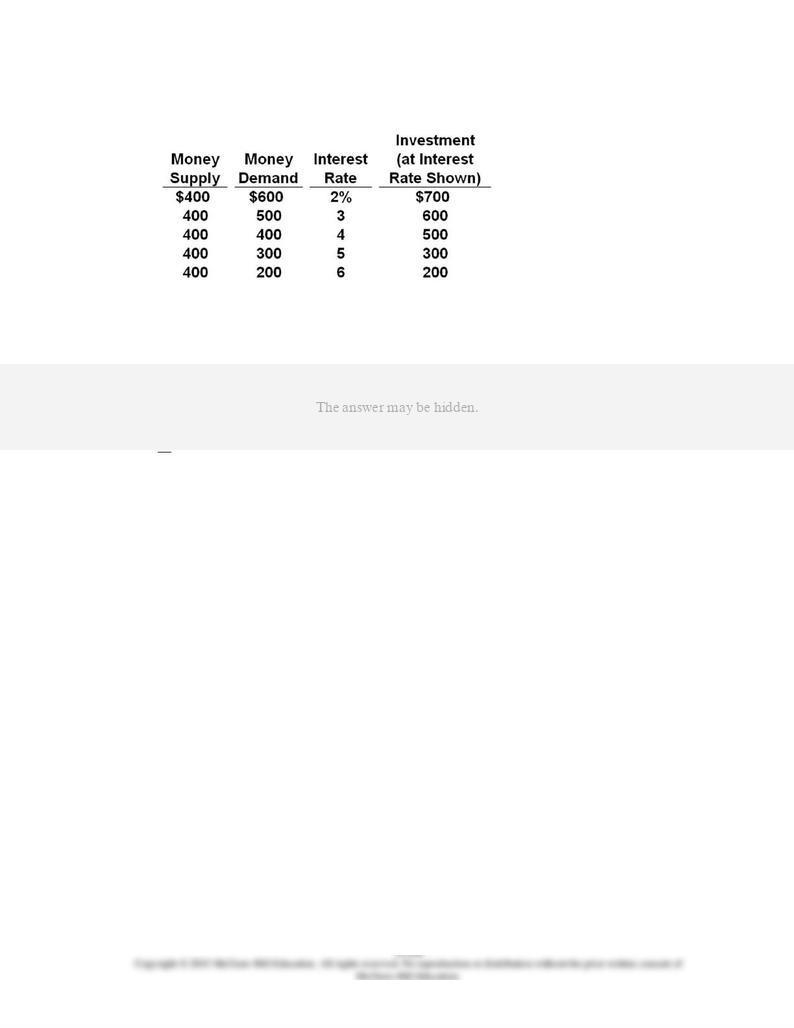
182.
Answer the question on the basis of the information in the following table.
Refer to the table. An interest rate of 2 percent is not sustainable because:
AACSB: Analytic
Blooms: Analyze
Difficulty: 3 Hard
Learning Objective: 34-05 Identify the mechanisms by which monetary policy affects GDP and the price level.
Topic: Monetary policy, real GDP, and the price level
Type: Table
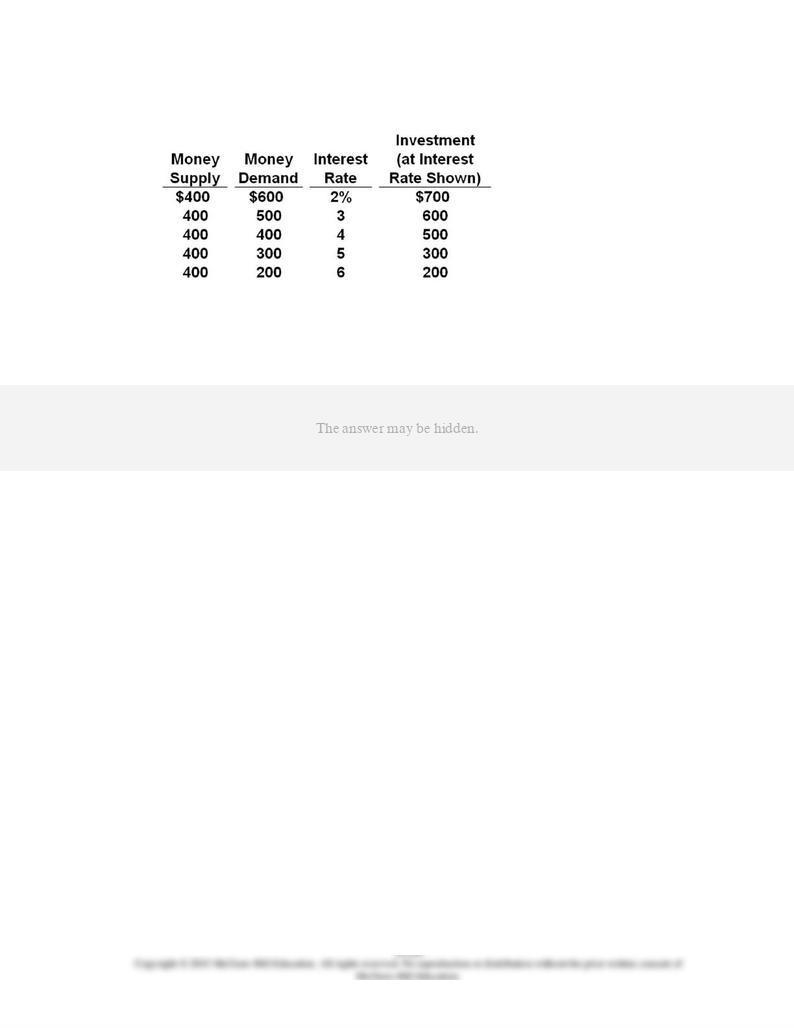
183.
Answer the question on the basis of the information in the following table.
Refer to the table. The amount of investment that will be forthcoming in this economy at
equilibrium is:
AACSB: Analytic
Blooms: Analyze
Difficulty: 3 Hard
Learning Objective: 34-05 Identify the mechanisms by which monetary policy affects GDP and the price level.
Topic: Monetary policy, real GDP, and the price level
Type: Table
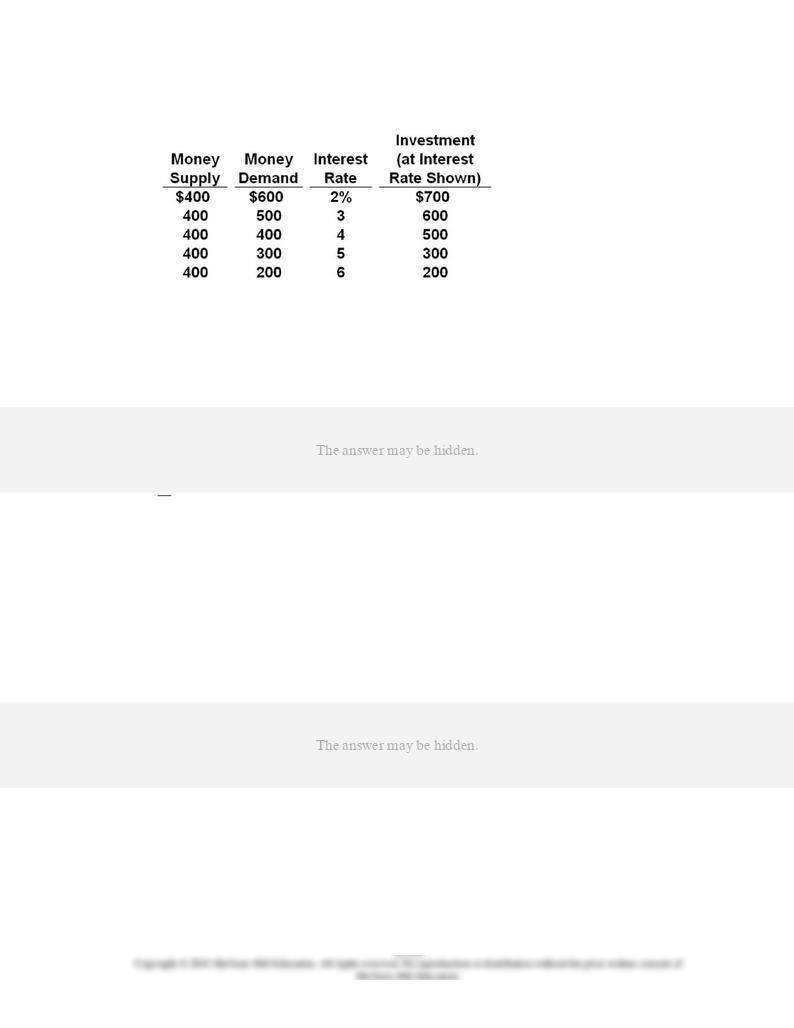
184.
Answer the question on the basis of the information in the following table.
Refer to the table. Suppose the legal reserve requirement is 10 percent and initially there
are no excess reserves in the banking system. If the Fed wished to reduce the interest rate
by 1 percentage point, it would:
AACSB: Analytic
Blooms: Analyze
Difficulty: 3 Hard
Learning Objective: 34-05 Identify the mechanisms by which monetary policy affects GDP and the price level.
Topic: Monetary policy, real GDP, and the price level
Type: Table
185.
The price of government bonds and the interest rate received by a bond buyer are:
AACSB: Reflective Thinking
Accessibility: Keyboard Navigation
Blooms: Understand
Difficulty: 2 Medium
Learning Objective: 34-05 Identify the mechanisms by which monetary policy affects GDP and the price level.
Topic: Monetary policy, real GDP, and the price level
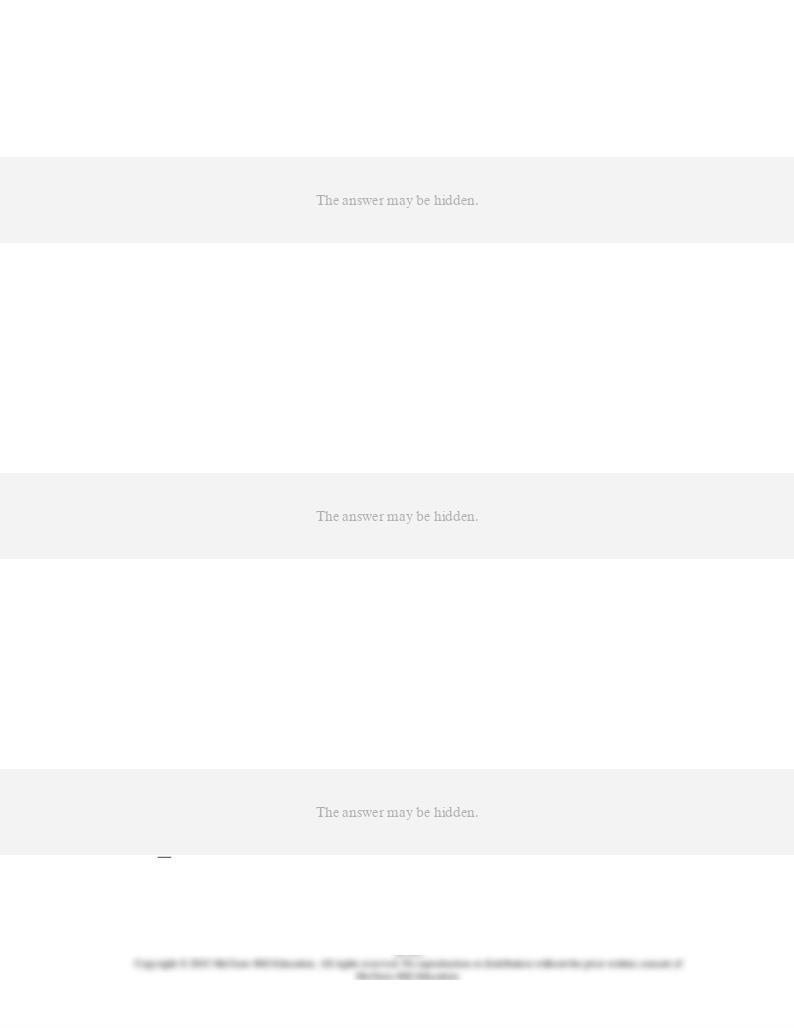
186.
A restrictive monetary policy is designed to shift the:
AACSB: Reflective Thinking
Accessibility: Keyboard Navigation
Blooms: Understand
Difficulty: 2 Medium
Learning Objective: 34-05 Identify the mechanisms by which monetary policy affects GDP and the price level.
Topic: Monetary policy, real GDP, and the price level
187.
If the economy is operating in the relatively steep (upper) portion of its aggregate supply
curve, a reduction in the money supply will:
AACSB: Reflective Thinking
Accessibility: Keyboard Navigation
Blooms: Analyze
Difficulty: 3 Hard
Learning Objective: 34-05 Identify the mechanisms by which monetary policy affects GDP and the price level.
Topic: Monetary policy, real GDP, and the price level
188.
The sale of government bonds by the Federal Reserve Banks to commercial banks will:
AACSB: Reflective Thinking
Accessibility: Keyboard Navigation
Blooms: Understand
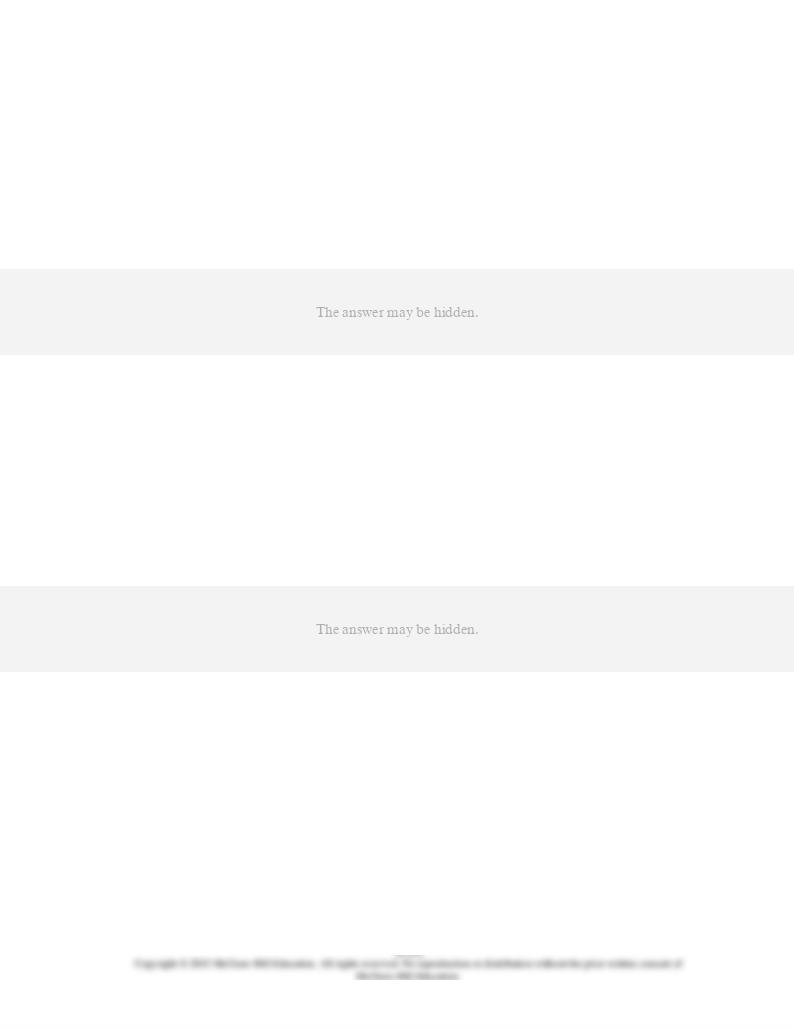
Difficulty: 2 Medium
Learning Objective: 34-05 Identify the mechanisms by which monetary policy affects GDP and the price level.
Topic: Monetary policy, real GDP, and the price level
189.
Assume that the price level is flexible both upward and downward and that the Fed's
policy is to keep the price level from either rising or falling. If aggregate supply increases
in the economy, the Fed:
AACSB: Reflective Thinking
Accessibility: Keyboard Navigation
Blooms: Analyze
Difficulty: 3 Hard
Learning Objective: 34-05 Identify the mechanisms by which monetary policy affects GDP and the price level.
Topic: Monetary policy, real GDP, and the price level
190.
If the demand for money increases and the Fed wants interest rates to remain unchanged,
which of the following would be appropriate policy?
AACSB: Reflective Thinking
Accessibility: Keyboard Navigation
Blooms: Analyze
Difficulty: 3 Hard
Learning Objective: 34-05 Identify the mechanisms by which monetary policy affects GDP and the price level.
Topic: Monetary policy, real GDP, and the price level
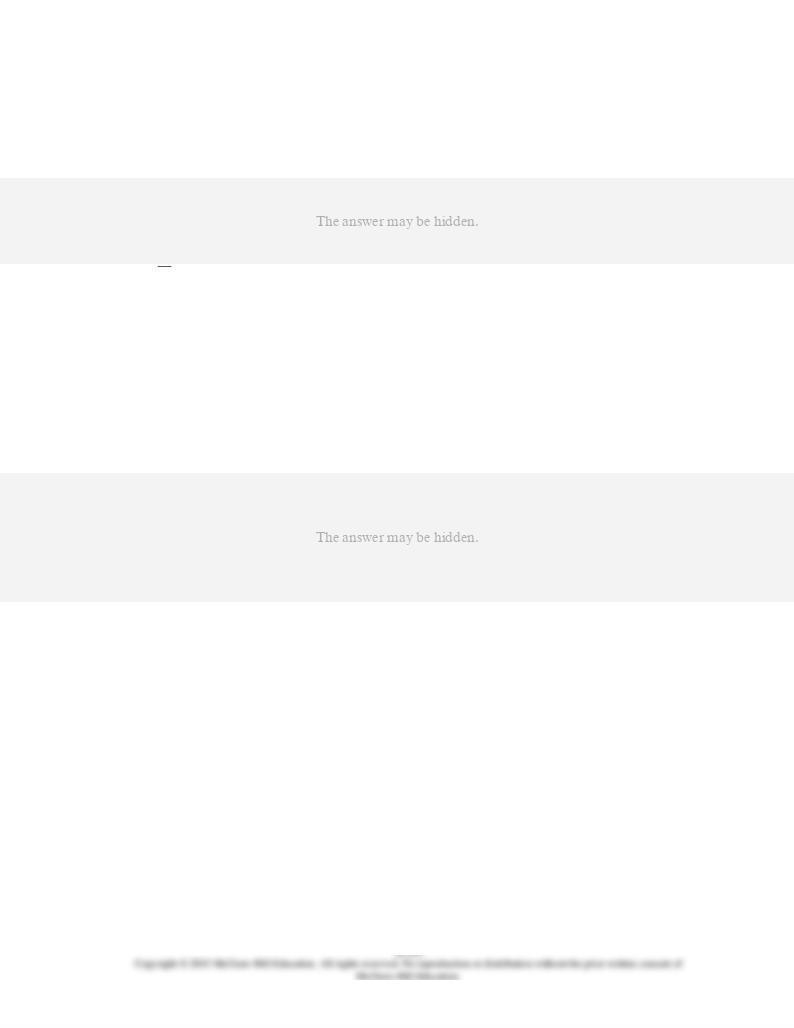
191.
The current (2013) chairperson of the Board of Governors of the Federal Reserve System
is:
AACSB: Reflective Thinking
Accessibility: Keyboard Navigation
Blooms: Remember
Difficulty: 1 Easy
Learning Objective: 34-03 List and explain the goals and tools of monetary policy.
Topic: Monetary policy, real GDP, and the price level
192.
In recent years, the Federal Reserve has:
AACSB: Reflective Thinking
Accessibility: Keyboard Navigation
Blooms: Remember
Difficulty: 1 Easy
Learning Objective: 34-06 Explain the effectiveness of monetary policy and its shortcomings.
Topic: Monetary policy: evaluation and issues
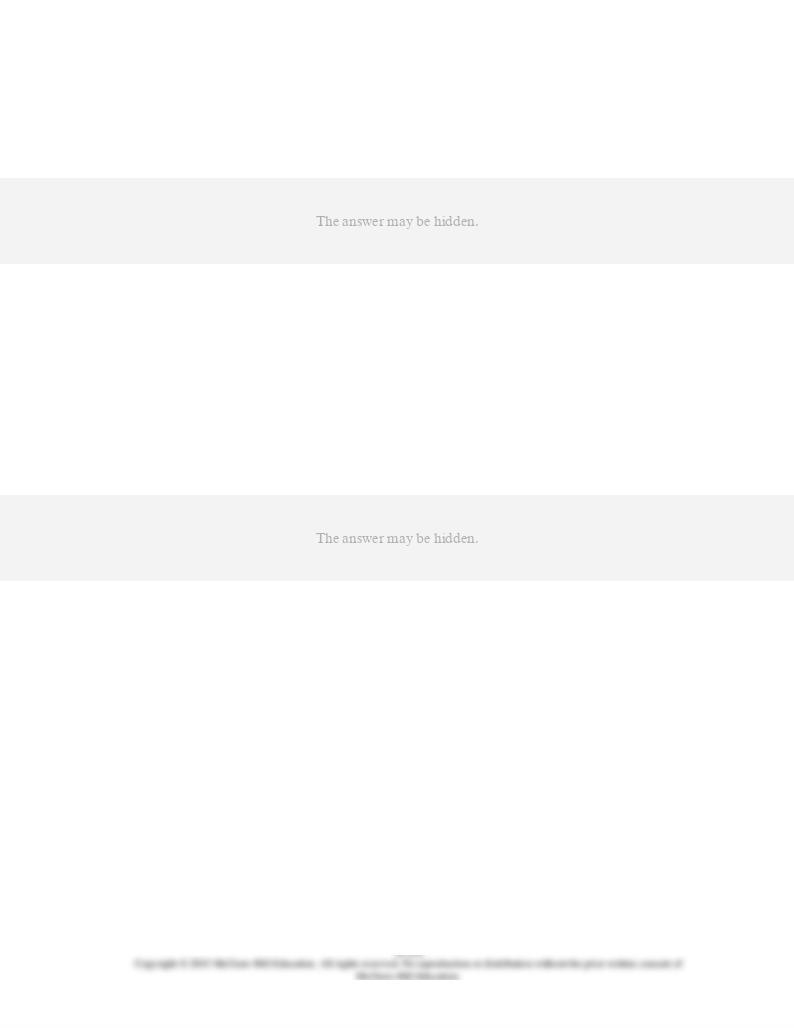
193.
In the latter part of 2001, the Fed cut the federal funds rate several times. The Fed's
purpose was to:
AACSB: Reflective Thinking
Accessibility: Keyboard Navigation
Blooms: Remember
Difficulty: 1 Easy
Learning Objective: 34-06 Explain the effectiveness of monetary policy and its shortcomings.
Topic: Monetary policy: evaluation and issues
194.
Between March 2001 and November 2002, the Fed reduced the federal funds rate from 5
percent to just above 1 percent. The Fed's purpose was to:
AACSB: Reflective Thinking
Accessibility: Keyboard Navigation
Blooms: Remember
Difficulty: 1 Easy
Learning Objective: 34-06 Explain the effectiveness of monetary policy and its shortcomings.
Topic: Monetary policy: evaluation and issues

195.
From 2004 to 2006 the Fed raised the federal funds rate gradually in a series of steps. The
Fed's purpose was to raise the prime interest rate so that:
AACSB: Reflective Thinking
Accessibility: Keyboard Navigation
Blooms: Remember
Difficulty: 1 Easy
Learning Objective: 34-06 Explain the effectiveness of monetary policy and its shortcomings.
Topic: Monetary policy: evaluation and issues
196.
From September 2007 to April 2008 the Fed lowered the federal funds rate from 5.25
percent to 2 percent in a series of steps. The Fed's actions were largely in response to:
AACSB: Reflective Thinking
Accessibility: Keyboard Navigation
Blooms: Remember
Difficulty: 1 Easy
Learning Objective: 34-06 Explain the effectiveness of monetary policy and its shortcomings.
Topic: Monetary policy: evaluation and issues
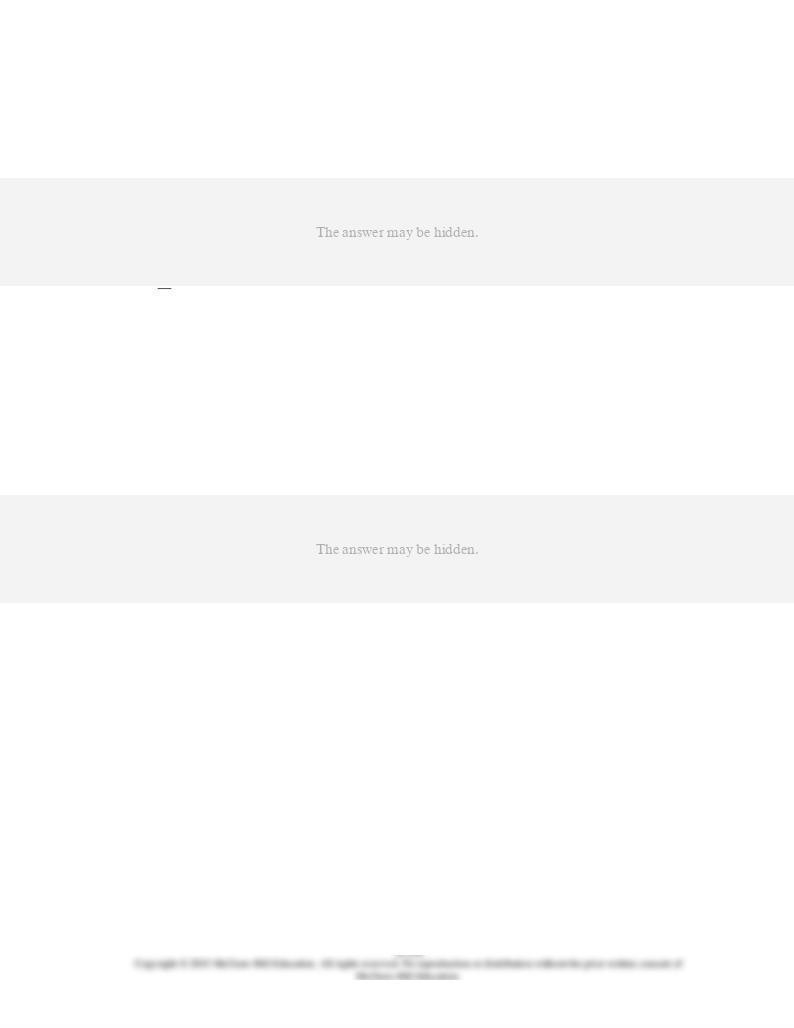
197.
In an effort to stabilize the banking sector and keep banks lending, from October 2008 to
September 2009, the Fed:
AACSB: Reflective Thinking
Accessibility: Keyboard Navigation
Blooms: Remember
Difficulty: 1 Easy
Learning Objective: 34-06 Explain the effectiveness of monetary policy and its shortcomings.
Topic: Monetary policy: evaluation and issues
198.
As part of its zero interest rate policy (ZIRP), the Federal Reserve:
AACSB: Reflective Thinking
Accessibility: Keyboard Navigation
Blooms: Remember
Difficulty: 1 Easy
Learning Objective: 34-06 Explain the effectiveness of monetary policy and its shortcomings.
Topic: Monetary policy: evaluation and issues
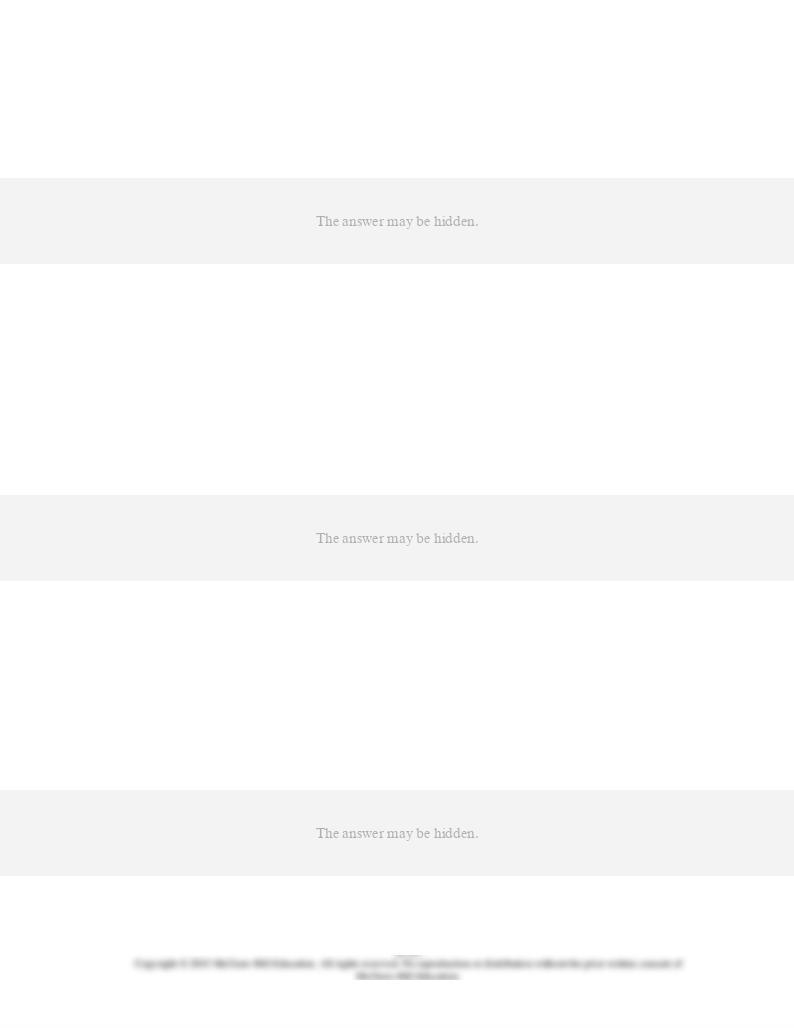
199.
After falling form a peak of 138.1 million in January 2008 to a trough of 129.9 million in
September 2010, employment in the U.S. economy:
AACSB: Reflective Thinking
Accessibility: Keyboard Navigation
Blooms: Remember
Difficulty: 1 Easy
Learning Objective: 34-06 Explain the effectiveness of monetary policy and its shortcomings.
Topic: Monetary policy: evaluation and issues
200.
Which of the following best describes the effect of the zero interest rate policy
implemented in December 2008?
AACSB: Reflective Thinking
Accessibility: Keyboard Navigation
Blooms: Understand
Difficulty: 2 Medium
Learning Objective: 34-06 Explain the effectiveness of monetary policy and its shortcomings.
Topic: Monetary policy: evaluation and issues
201.
In response to the zero lower bound problem:
AACSB: Reflective Thinking

Accessibility: Keyboard Navigation
Blooms: Remember
Difficulty: 1 Easy
Learning Objective: 34-06 Explain the effectiveness of monetary policy and its shortcomings.
Topic: Monetary policy: evaluation and issues
202.
Which of the following is a difference between "quantitative easing" and ordinary open-
market operations?
AACSB: Reflective Thinking
Accessibility: Keyboard Navigation
Blooms: Understand
Difficulty: 2 Medium
Learning Objective: 34-06 Explain the effectiveness of monetary policy and its shortcomings.
Topic: Monetary policy: evaluation and issues
203.
Forward commitment by the Fed:
AACSB: Reflective Thinking
Accessibility: Keyboard Navigation
Blooms: Remember
Difficulty: 1 Easy
Learning Objective: 34-06 Explain the effectiveness of monetary policy and its shortcomings.
Topic: Monetary policy: evaluation and issues
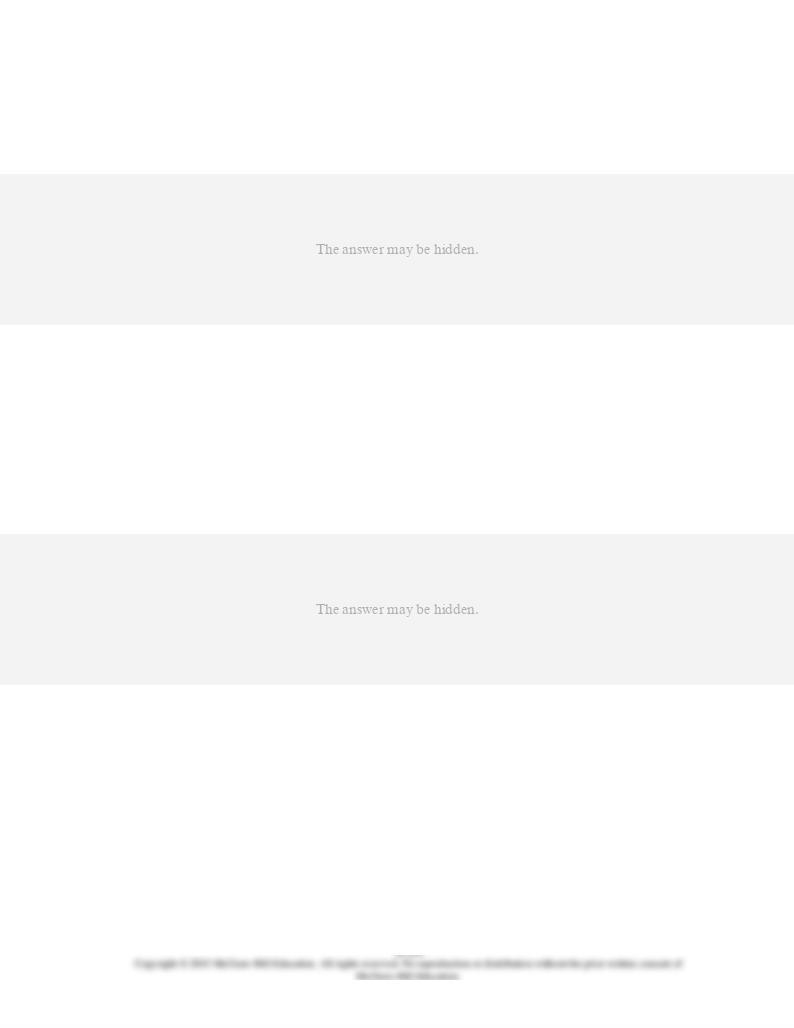
204.
Forward commitment by the Fed has which of the following impacts?
AACSB: Reflective Thinking
Accessibility: Keyboard Navigation
Blooms: Understand
Difficulty: 2 Medium
Learning Objective: 34-06 Explain the effectiveness of monetary policy and its shortcomings.
Topic: Monetary policy: evaluation and issues
205.
Operation Twist:
AACSB: Reflective Thinking
Accessibility: Keyboard Navigation
Blooms: Understand
Difficulty: 2 Medium
Learning Objective: 34-06 Explain the effectiveness of monetary policy and its shortcomings.
Topic: Monetary policy: evaluation and issues
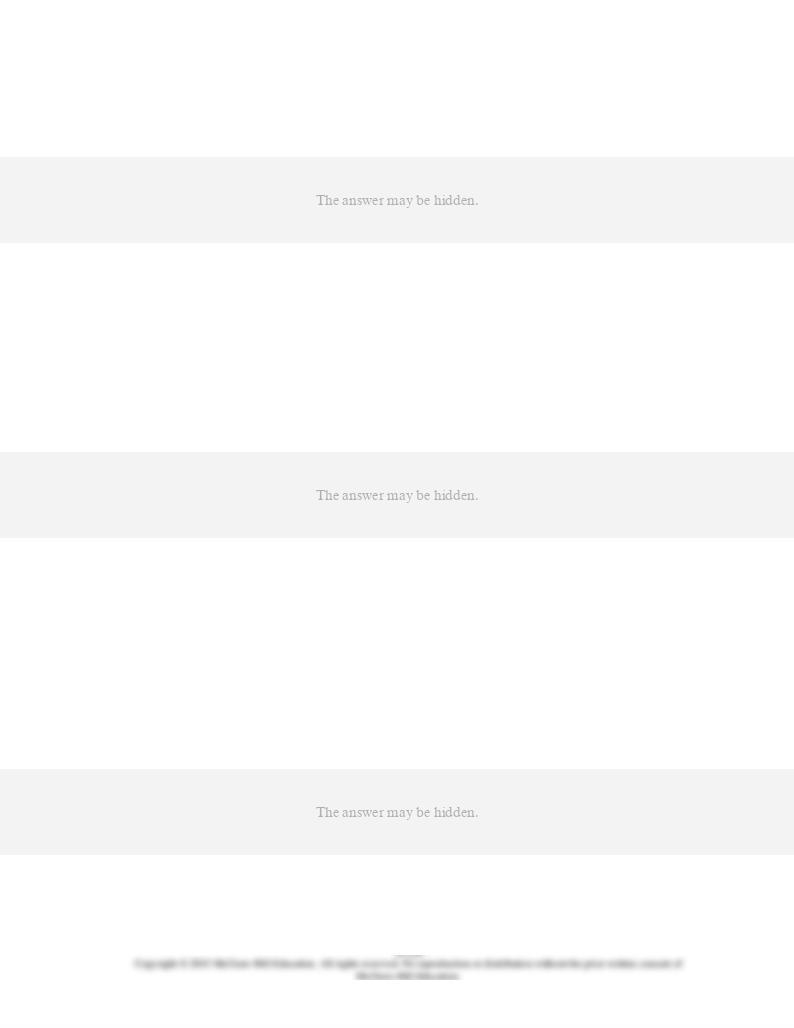
206.
The objective of Operation Twist was to:
AACSB: Reflective Thinking
Accessibility: Keyboard Navigation
Blooms: Remember
Difficulty: 1 Easy
Learning Objective: 34-06 Explain the effectiveness of monetary policy and its shortcomings.
Topic: Monetary policy: evaluation and issues
207.
Which of the following is a primary difference between QE2 and QE3?
AACSB: Reflective Thinking
Accessibility: Keyboard Navigation
Blooms: Remember
Difficulty: 1 Easy
Learning Objective: 34-06 Explain the effectiveness of monetary policy and its shortcomings.
Topic: Monetary policy: evaluation and issues
208.
Which of the following Fed policy actions left the date for completion open, based on
achieving particular employment objectives?
AACSB: Reflective Thinking
Accessibility: Keyboard Navigation
Blooms: Remember
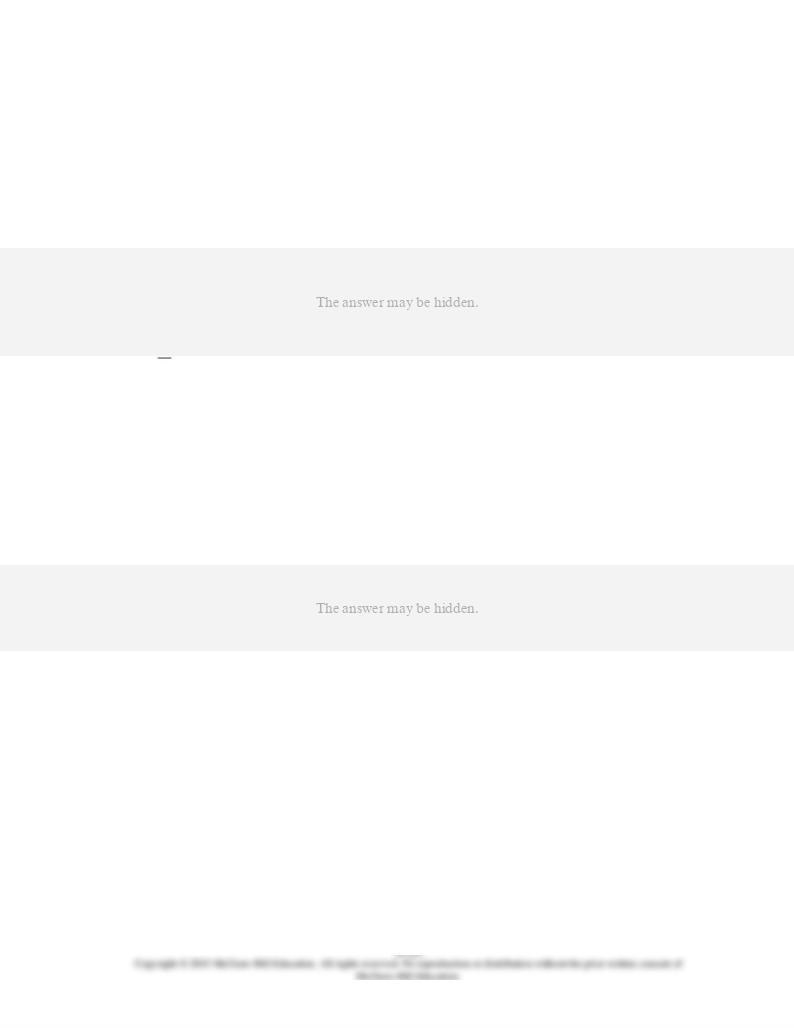
Difficulty: 1 Easy
Learning Objective: 34-06 Explain the effectiveness of monetary policy and its shortcomings.
Topic: Monetary policy: evaluation and issues
209.
QE3 followed QE2 and Operation Twist. Which of the following best explains how QE3
differed from the other two in order to make it more effective?
AACSB: Reflective Thinking
Accessibility: Keyboard Navigation
Blooms: Understand
Difficulty: 2 Medium
Learning Objective: 34-06 Explain the effectiveness of monetary policy and its shortcomings.
Topic: Monetary policy: evaluation and issues
210.
One of the strengths of monetary policy relative to fiscal policy is that monetary policy:
AACSB: Reflective Thinking
Accessibility: Keyboard Navigation
Blooms: Remember
Difficulty: 1 Easy
Learning Objective: 34-06 Explain the effectiveness of monetary policy and its shortcomings.
Topic: Monetary policy: evaluation and issues
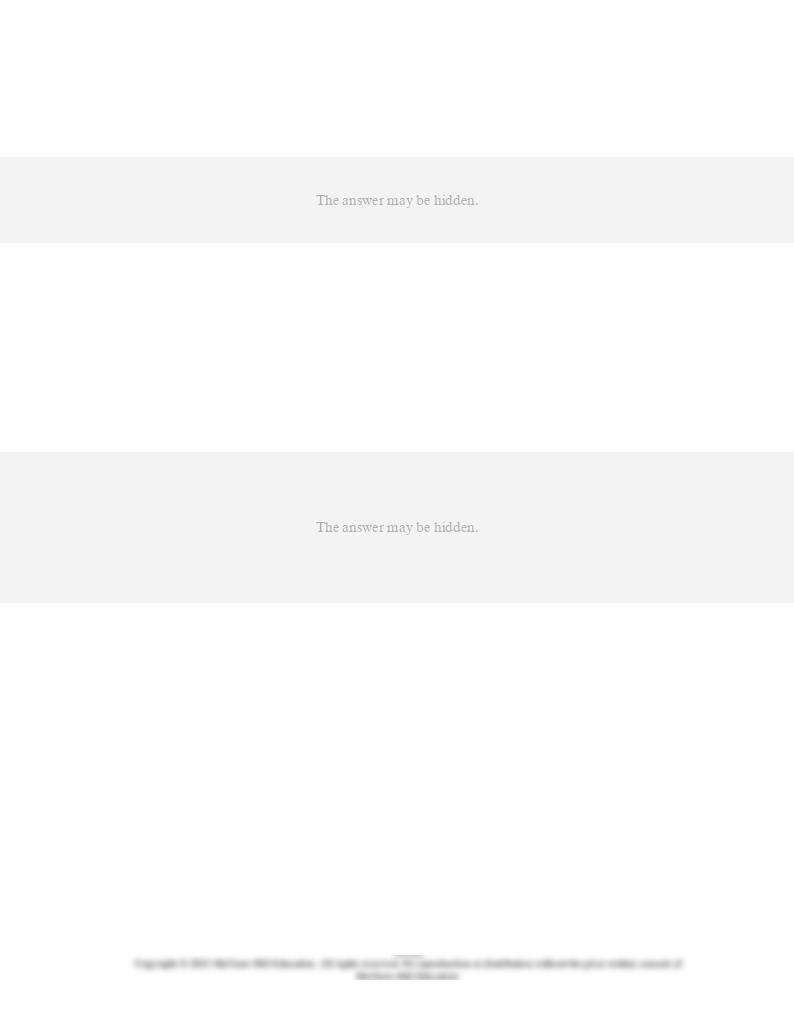
211.
Which of the following is
least
likely to be a problem for monetary policy?
AACSB: Reflective Thinking
Accessibility: Keyboard Navigation
Blooms: Remember
Difficulty: 1 Easy
Learning Objective: 34-06 Explain the effectiveness of monetary policy and its shortcomings.
Topic: Monetary policy: evaluation and issues
212.
The problem of cyclical asymmetry refers to the idea that:
AACSB: Analytic
Accessibility: Keyboard Navigation
Blooms: Understand
Difficulty: 2 Medium
Learning Objective: 34-06 Explain the effectiveness of monetary policy and its shortcomings.
Topic: Monetary policy: evaluation and issues

213.
In economics, the expression "You can lead a horse to water, but you can't make it drink"
illustrates the:
AACSB: Reflective Thinking
Accessibility: Keyboard Navigation
Blooms: Understand
Difficulty: 2 Medium
Learning Objective: 34-06 Explain the effectiveness of monetary policy and its shortcomings.
Topic: Monetary policy: evaluation and issues
214.
An expansionary monetary policy may be less effective than a restrictive monetary policy
because:
AACSB: Reflective Thinking
Accessibility: Keyboard Navigation
Blooms: Understand
Difficulty: 2 Medium
Learning Objective: 34-06 Explain the effectiveness of monetary policy and its shortcomings.
Topic: Monetary policy: evaluation and issues
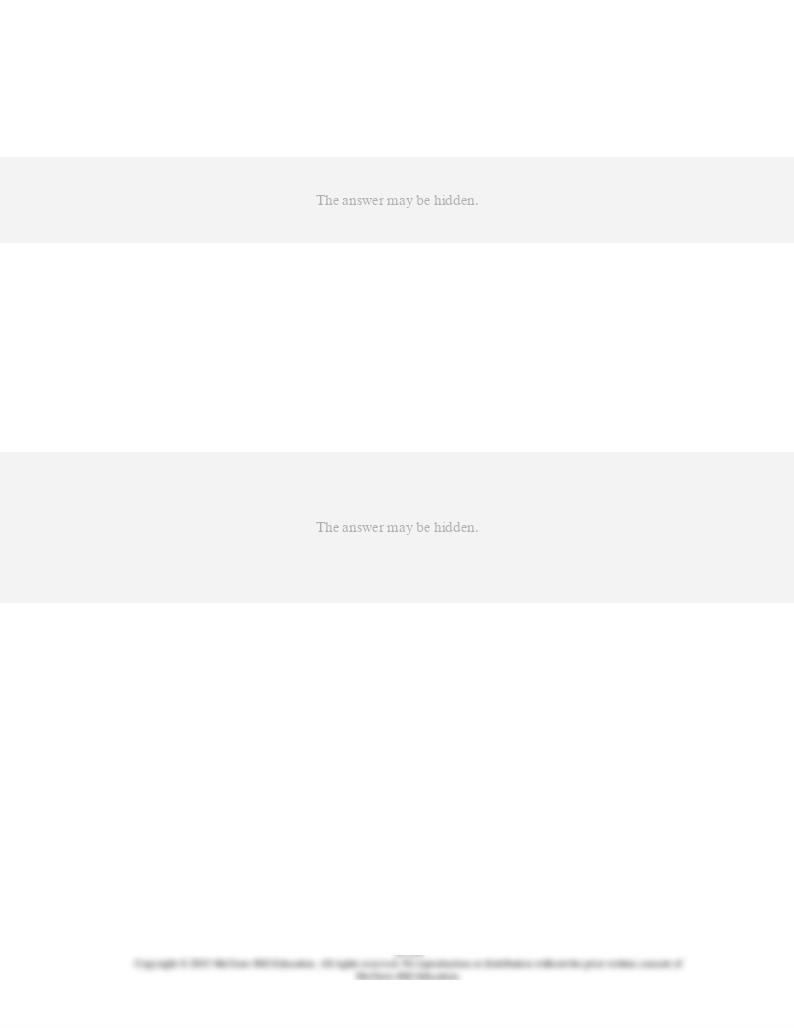
215.
An expansionary monetary policy may be frustrated if the:
AACSB: Reflective Thinking
Accessibility: Keyboard Navigation
Blooms: Understand
Difficulty: 2 Medium
Learning Objective: 34-06 Explain the effectiveness of monetary policy and its shortcomings.
Topic: Monetary policy: evaluation and issues
216.
Monetary policy is thought to be:
AACSB: Reflective Thinking
Accessibility: Keyboard Navigation
Blooms: Remember
Difficulty: 1 Easy
Learning Objective: 34-06 Explain the effectiveness of monetary policy and its shortcomings.
Topic: Monetary policy: evaluation and issues
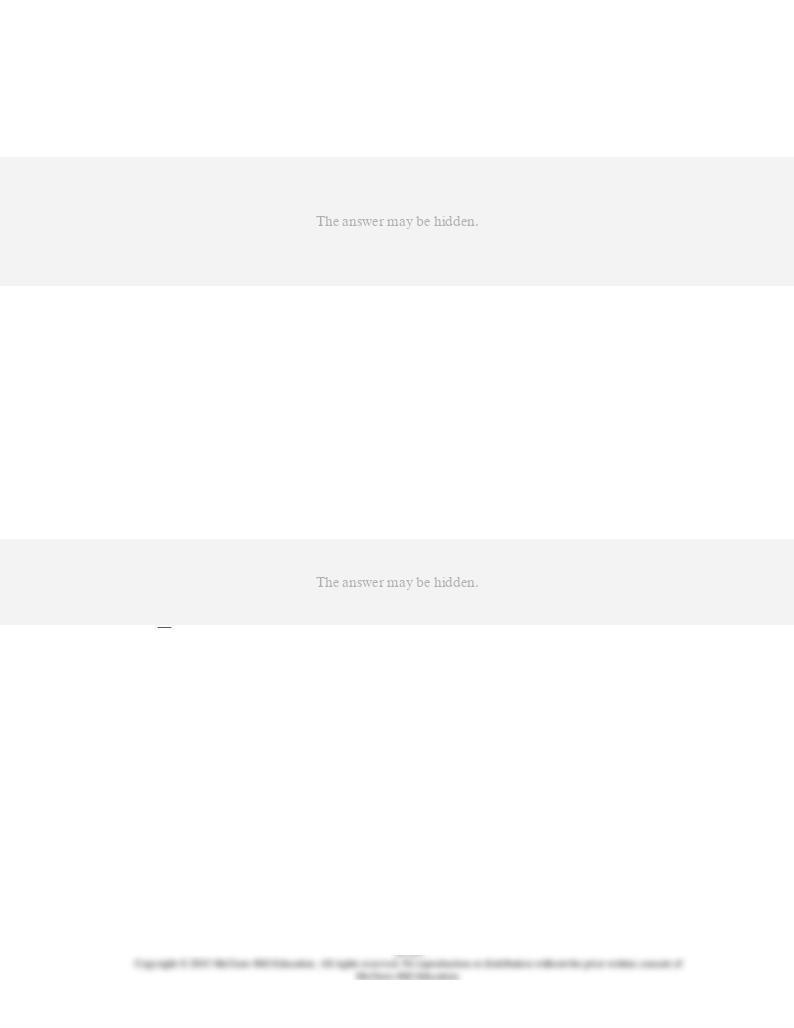
217.
The impact of monetary policy on investment spending may be weakened:
AACSB: Reflective Thinking
Accessibility: Keyboard Navigation
Blooms: Understand
Difficulty: 2 Medium
Learning Objective: 34-06 Explain the effectiveness of monetary policy and its shortcomings.
Topic: Monetary policy: evaluation and issues
218.
In the 1990s and early 2000s, Japan's central bank reduced real interest rates to zero
percent, but investment spending did not respond enough to bring the economy out of
recession. Japan's experience is an illustration of:
AACSB: Reflective Thinking
Accessibility: Keyboard Navigation
Blooms: Apply
Difficulty: 2 Medium
Learning Objective: 34-06 Explain the effectiveness of monetary policy and its shortcomings.
Topic: Monetary policy: evaluation and issues
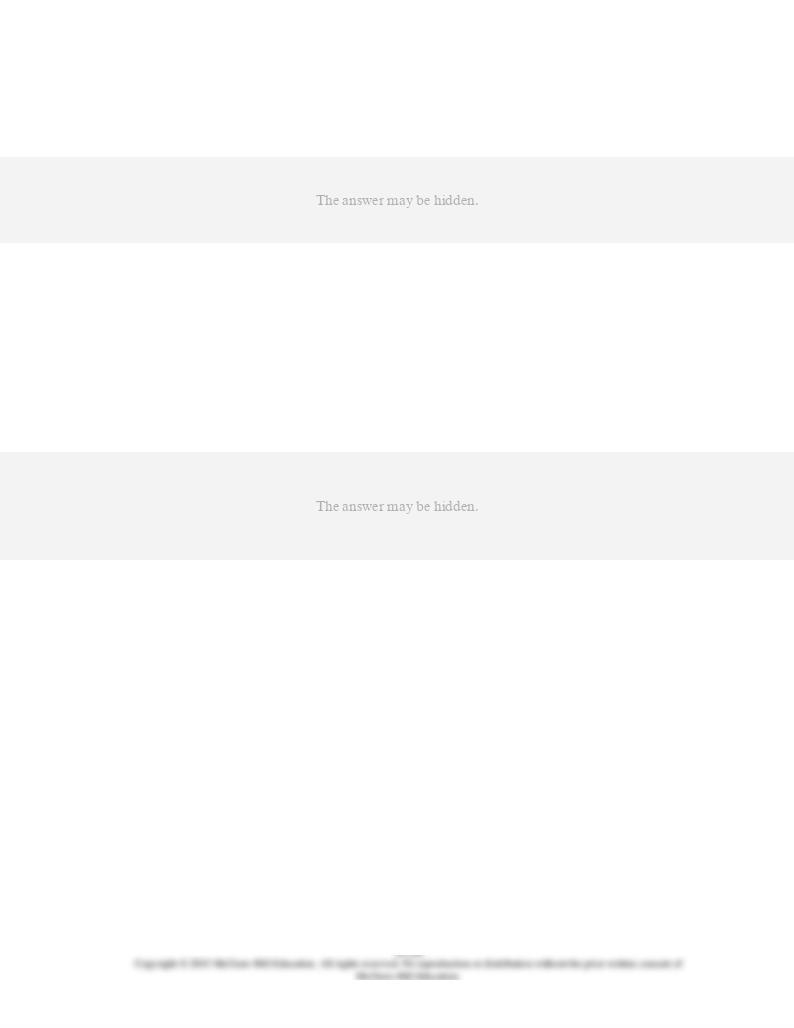
219.
The possible asymmetry of monetary policy is the central idea of the:
AACSB: Reflective Thinking
Accessibility: Keyboard Navigation
Blooms: Remember
Difficulty: 1 Easy
Learning Objective: 34-06 Explain the effectiveness of monetary policy and its shortcomings.
Topic: Monetary policy: evaluation and issues
220.
The pushing-on-a-string analogy makes the point that monetary policy may be better at:
AACSB: Reflective Thinking
Accessibility: Keyboard Navigation
Blooms: Understand
Difficulty: 2 Medium
Learning Objective: 34-06 Explain the effectiveness of monetary policy and its shortcomings.
Topic: Monetary policy: evaluation and issues
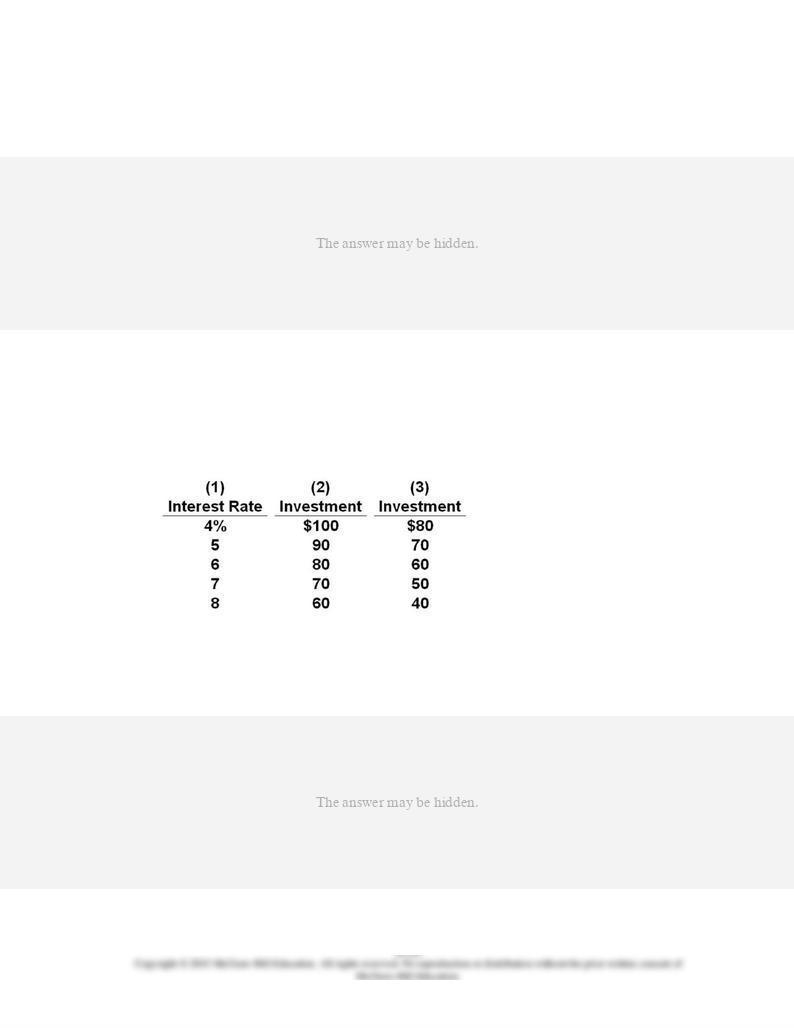
221.
The liquidity trap refers to the situation where:
AACSB: Reflective Thinking
Accessibility: Keyboard Navigation
Blooms: Understand
Difficulty: 2 Medium
Learning Objective: 34-06 Explain the effectiveness of monetary policy and its shortcomings.
Topic: Monetary policy: evaluation and issues
222.
Refer to the table, in which investment is in billions. Which of the following scenarios
would be consistent with the occurrence of cyclical asymmetry?
AACSB: Analytic
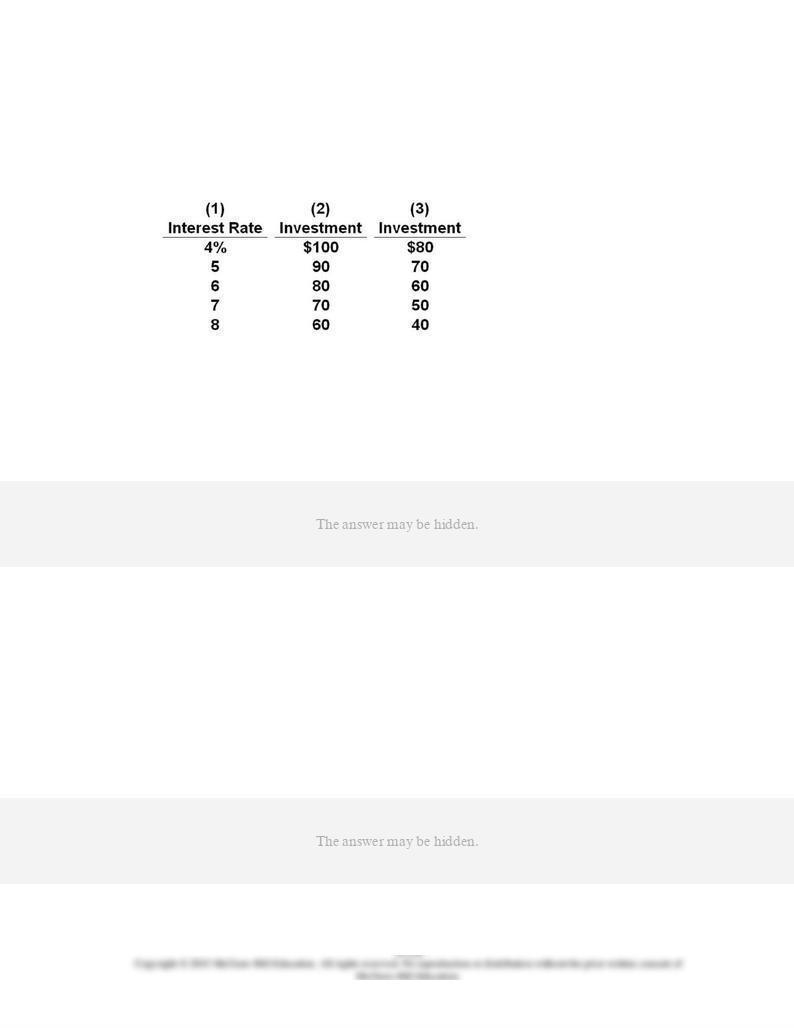
Blooms: Apply
Difficulty: 2 Medium
Learning Objective: 34-05 Identify the mechanisms by which monetary policy affects GDP and the price level.
Topic: Monetary policy: evaluation and issues
Type: Table
223.
Refer to the table, in which investment is in billions. Suppose the Fed reduces the interest
rate from 6 to 5 percent at a time when the investment demand declines from that shown
by columns (1) and (2) to that shown by columns (1) and (3). As a result of these two
occurrences, investment will:
AACSB: Analytic
Blooms: Apply
Difficulty: 2 Medium
Learning Objective: 34-06 Explain the effectiveness of monetary policy and its shortcomings.
Topic: Monetary policy: evaluation and issues
Type: Table
224.
(Consider This) The Fed's ability to alter the level of reserves in the banking system is the
main idea of the:
AACSB: Reflective Thinking
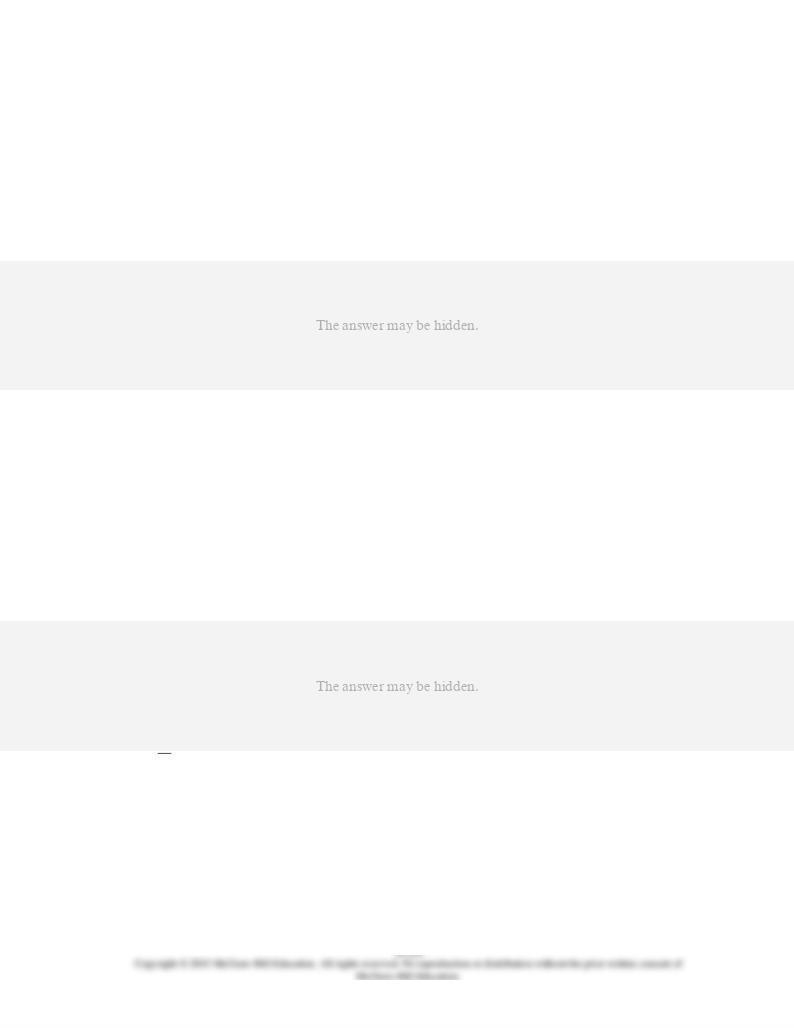
Accessibility: Keyboard Navigation
Blooms: Understand
Difficulty: 2 Medium
Learning Objective: 34-05 Identify the mechanisms by which monetary policy affects GDP and the price level.
Topic: Monetary policy, real GDP, and the price level
225.
(Consider This) The Fed is like a sponge in that it can:
AACSB: Reflective Thinking
Accessibility: Keyboard Navigation
Blooms: Understand
Difficulty: 2 Medium
Learning Objective: 34-05 Identify the mechanisms by which monetary policy affects GDP and the price level.
Topic: Monetary policy, real GDP, and the price level
226.
(Consider This) During and immediately following the severe recession of 2007-2009, on
the consolidated balance sheet of the 12 Federal Reserve Banks:
AACSB: Reflective Thinking
Accessibility: Keyboard Navigation
Blooms: Remember
Difficulty: 1 Easy
Learning Objective: 34-05 Identify the mechanisms by which monetary policy affects GDP and the price level.
Learning Objective: 34-06 Explain the effectiveness of monetary policy and its shortcomings.
Topic: Monetary policy, real GDP, and the price level
Topic: Monetary policy: evaluation and issues
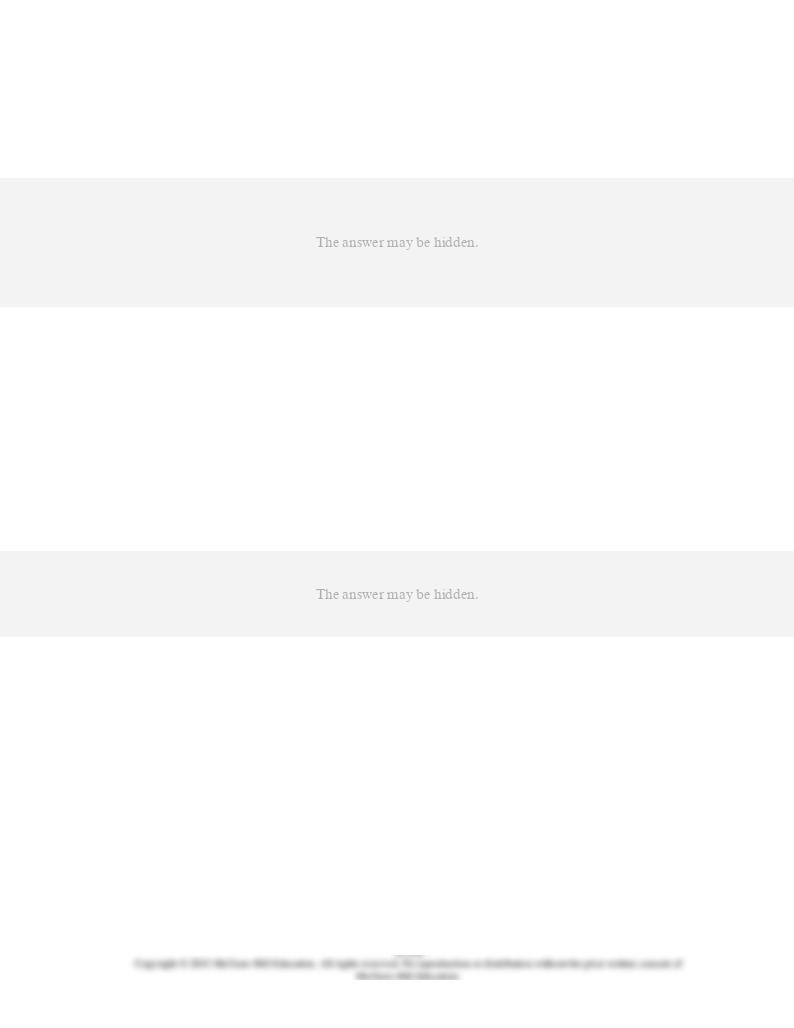
227.
(Consider This) During and immediately following the severe recession of 2007-2009,
commercial bank reserves held on deposit in Federal Reserve Banks:
AACSB: Reflective Thinking
Accessibility: Keyboard Navigation
Blooms: Remember
Difficulty: 1 Easy
Learning Objective: 34-05 Identify the mechanisms by which monetary policy affects GDP and the price level.
Learning Objective: 34-06 Explain the effectiveness of monetary policy and its shortcomings.
Topic: Monetary policy, real GDP, and the price level
Topic: Monetary policy: evaluation and issues
228.
Other things equal, an increase in productivity will:
AACSB: Reflective Thinking
Accessibility: Keyboard Navigation
Blooms: Analyze
Difficulty: 3 Hard
Learning Objective: 34-05 Identify the mechanisms by which monetary policy affects GDP and the price level.
Topic: Big picture
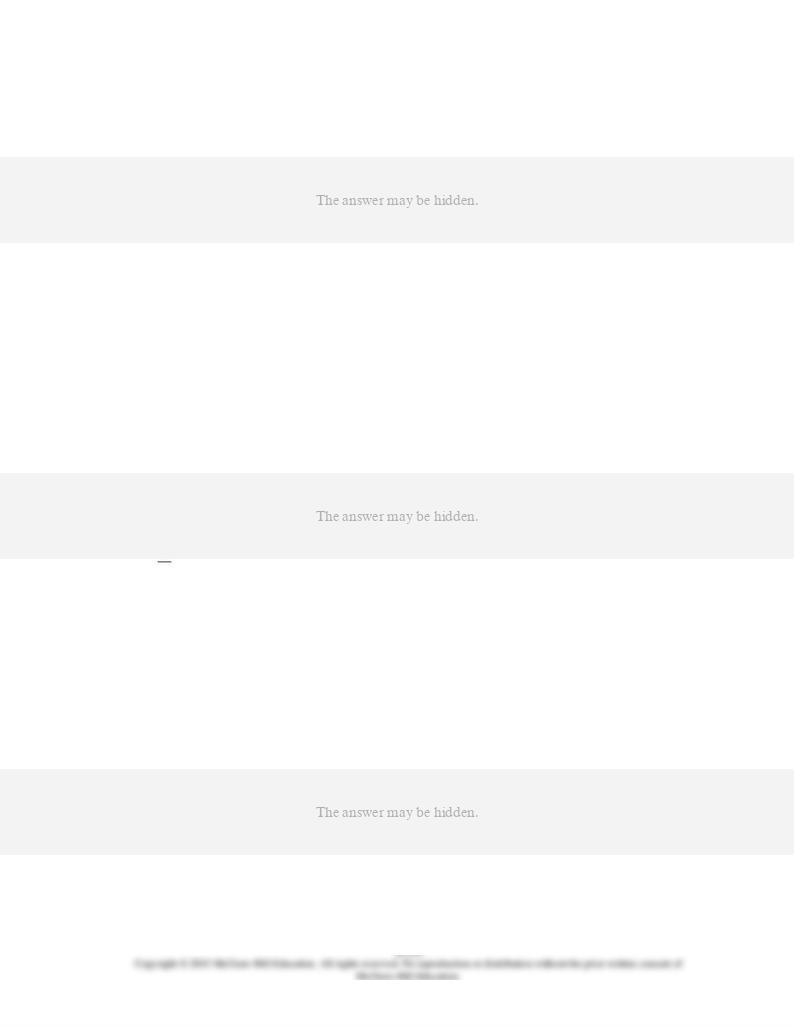
229.
Other things equal, an increase in input prices will:
AACSB: Reflective Thinking
Accessibility: Keyboard Navigation
Blooms: Analyze
Difficulty: 3 Hard
Learning Objective: 34-05 Identify the mechanisms by which monetary policy affects GDP and the price level.
Topic: Big picture
230.
Other things equal, a restrictive monetary policy during a period of demand-pull inflation
will:
AACSB: Reflective Thinking
Accessibility: Keyboard Navigation
Blooms: Analyze
Difficulty: 3 Hard
Learning Objective: 34-05 Identify the mechanisms by which monetary policy affects GDP and the price level.
Topic: Big picture
231.
Other things equal, a reduction in income taxes would:
AACSB: Reflective Thinking
Accessibility: Keyboard Navigation
Blooms: Analyze
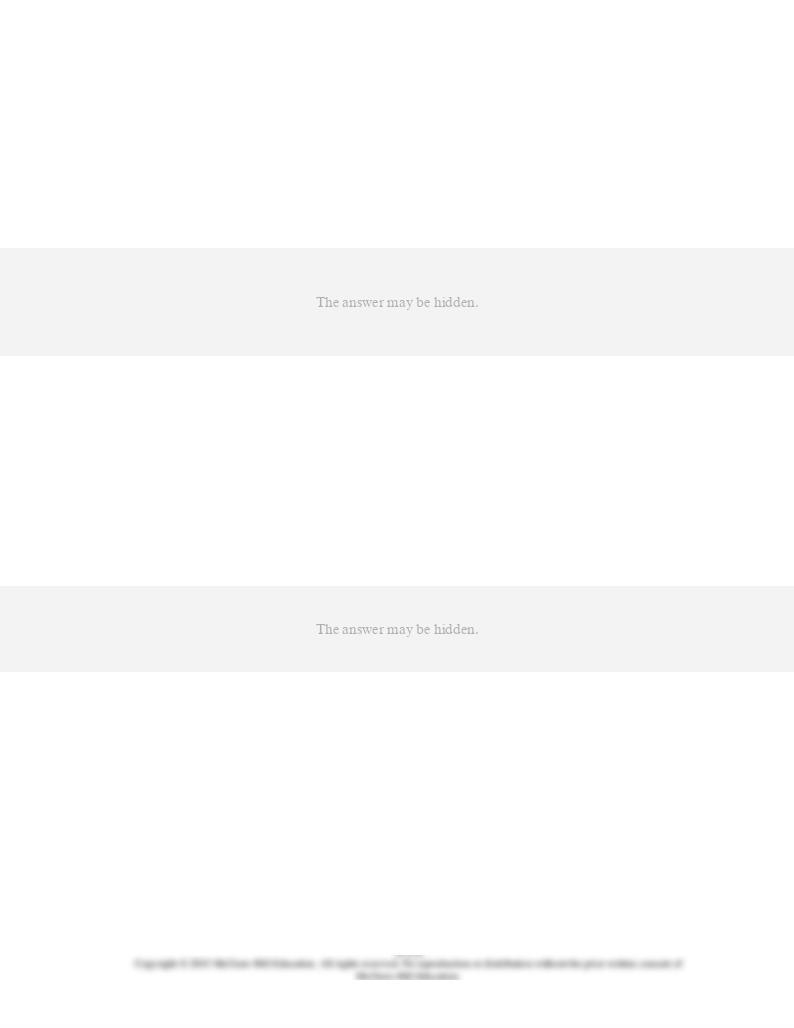
Difficulty: 3 Hard
Learning Objective: 34-05 Identify the mechanisms by which monetary policy affects GDP and the price level.
Topic: Big picture
232.
(Last Word) Which of the following is a concern about the consequences of ZIRP, QE, and
Operation Twist?
AACSB: Reflective Thinking
Accessibility: Keyboard Navigation
Blooms: Understand
Difficulty: 2 Medium
Learning Objective: 34-06 Explain the effectiveness of monetary policy and its shortcomings.
Topic: Monetary policy: evaluation and issues
233.
(Last Word) Which of the following is true about the effects of ZIRP, QE, and Operation
Twist?
AACSB: Reflective Thinking
Accessibility: Keyboard Navigation
Blooms: Remember
Difficulty: 1 Easy
Learning Objective: 34-06 Explain the effectiveness of monetary policy and its shortcomings.
Topic: Monetary policy: evaluation and issues
True / False Questions
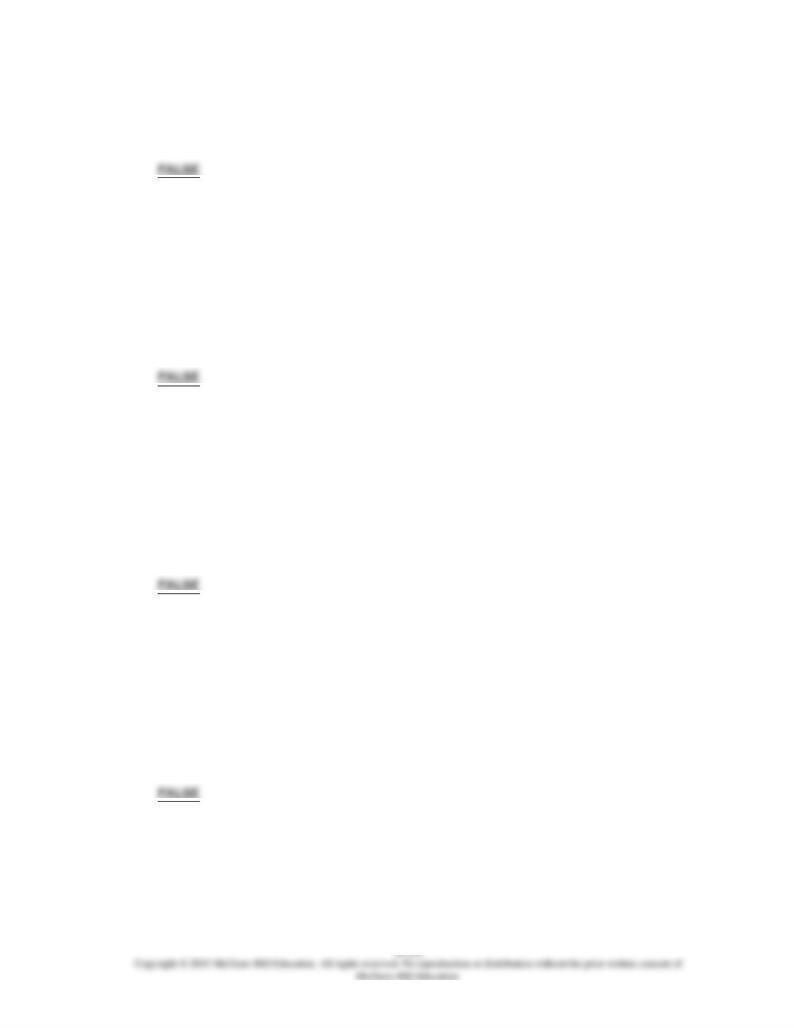
234.
The higher the interest rate, the larger will be the amount of money demanded for
transaction purposes.
AACSB: Reflective Thinking
Accessibility: Keyboard Navigation
Blooms: Understand
Difficulty: 2 Medium
Learning Objective: 34-01 Discuss how the equilibrium interest rate is determined in the market for money.
Topic: Interest rates
235.
The asset demand for money varies inversely with the nominal GDP.
AACSB: Reflective Thinking
Accessibility: Keyboard Navigation
Blooms: Understand
Difficulty: 2 Medium
Learning Objective: 34-01 Discuss how the equilibrium interest rate is determined in the market for money.
Topic: Interest rates
236.
Bond prices and interest rates are directly or positively related.
AACSB: Reflective Thinking
Accessibility: Keyboard Navigation
Blooms: Remember
Difficulty: 1 Easy
Learning Objective: 34-01 Discuss how the equilibrium interest rate is determined in the market for money.
Topic: Interest rates
237.
The Fed reduces interest rates mainly by selling government securities.
AACSB: Reflective Thinking
Accessibility: Keyboard Navigation
Blooms: Understand
Difficulty: 2 Medium
Learning Objective: 34-01 Discuss how the equilibrium interest rate is determined in the market for money.
Learning Objective: 34-03 List and explain the goals and tools of monetary policy.
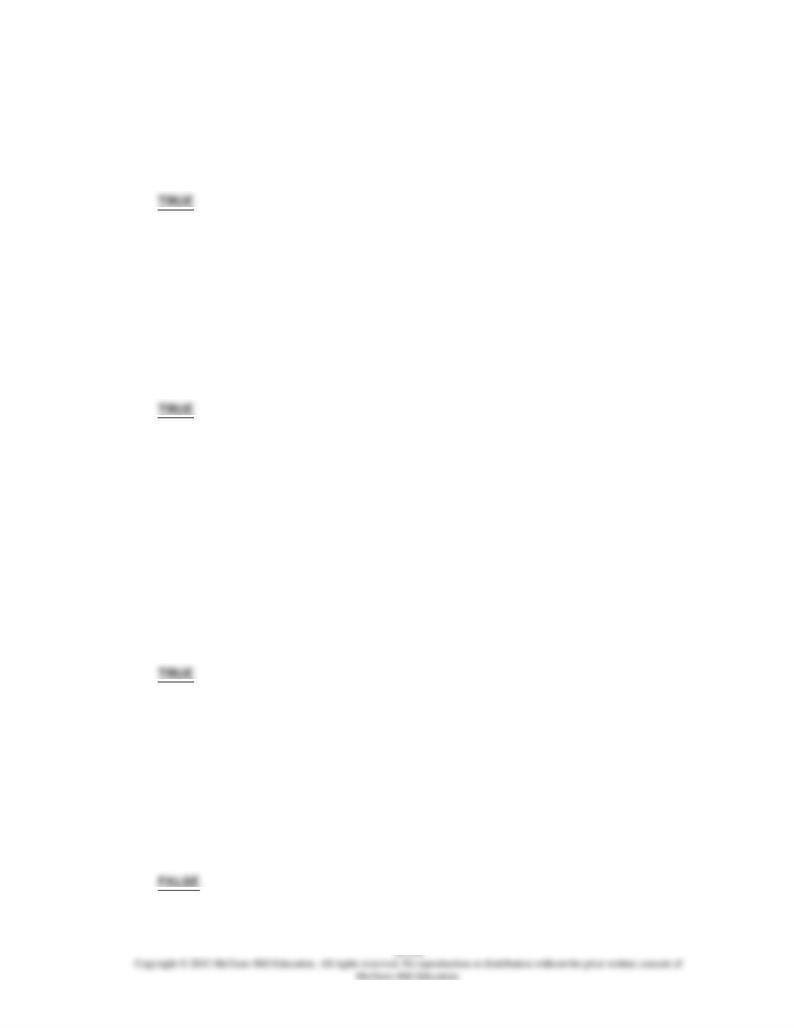
Topic: Interest rates
Topic: Tools of monetary policy
238.
The Fed increases interest rates mainly by selling government securities.
AACSB: Reflective Thinking
Accessibility: Keyboard Navigation
Blooms: Understand
Difficulty: 2 Medium
Learning Objective: 34-03 List and explain the goals and tools of monetary policy.
Topic: Tools of monetary policy
239.
Ben Bernanke is the current (2013) chair of the Board of Governors.
AACSB: Reflective Thinking
Accessibility: Keyboard Navigation
Blooms: Remember
Difficulty: 1 Easy
Learning Objective: 34-05 Identify the mechanisms by which monetary policy affects GDP and the price level.
Learning Objective: 34-06 Explain the effectiveness of monetary policy and its shortcomings.
Topic: Monetary policy, real GDP, and the price level
Topic: Monetary policy: evaluation and issues
240.
A change in the reserve ratio will affect both the amount of the banking system's excess
reserves and the multiple by which the system can lend on the basis of excess reserves.
AACSB: Reflective Thinking
Accessibility: Keyboard Navigation
Blooms: Understand
Difficulty: 2 Medium
Learning Objective: 34-03 List and explain the goals and tools of monetary policy.
Topic: Tools of monetary policy
241.
The federal funds rate target is the most frequently used monetary policy tool.
AACSB: Reflective Thinking
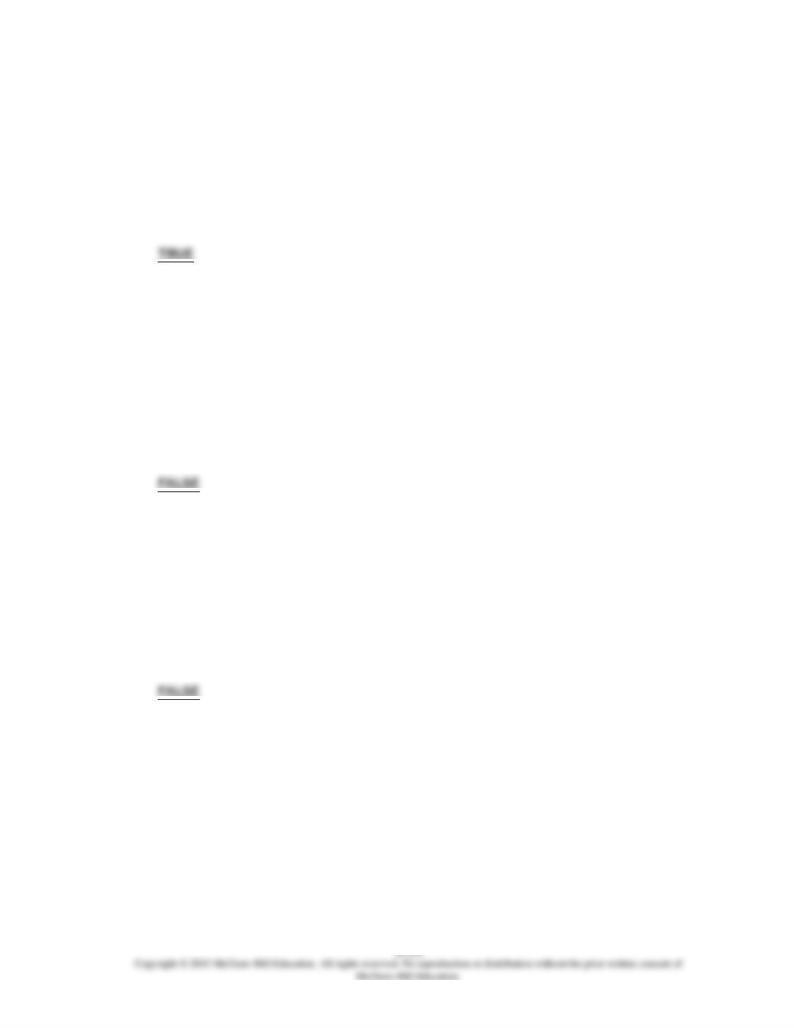
Accessibility: Keyboard Navigation
Blooms: Remember
Difficulty: 1 Easy
Learning Objective: 34-03 List and explain the goals and tools of monetary policy.
Topic: Tools of monetary policy
242.
When the Fed raises the interest rate paid on reserves, it discourages bank lending.
AACSB: Reflective Thinking
Accessibility: Keyboard Navigation
Blooms: Remember
Difficulty: 1 Easy
Learning Objective: 34-03 List and explain the goals and tools of monetary policy.
Topic: Tools of monetary policy
243.
When the Fed pays interest on reserves held at Fed banks, the interest rate used is the
discount rate.
AACSB: Reflective Thinking
Accessibility: Keyboard Navigation
Blooms: Remember
Difficulty: 1 Easy
Learning Objective: 34-03 List and explain the goals and tools of monetary policy.
Topic: Tools of monetary policy
244.
The prime interest rate and the federal funds rate normally change in opposite directions.
AACSB: Reflective Thinking
Accessibility: Keyboard Navigation
Blooms: Understand
Difficulty: 2 Medium
Learning Objective: 34-04 Describe the federal funds rate and how the Fed directly influences it.
Topic: Targeting the federal funds rate
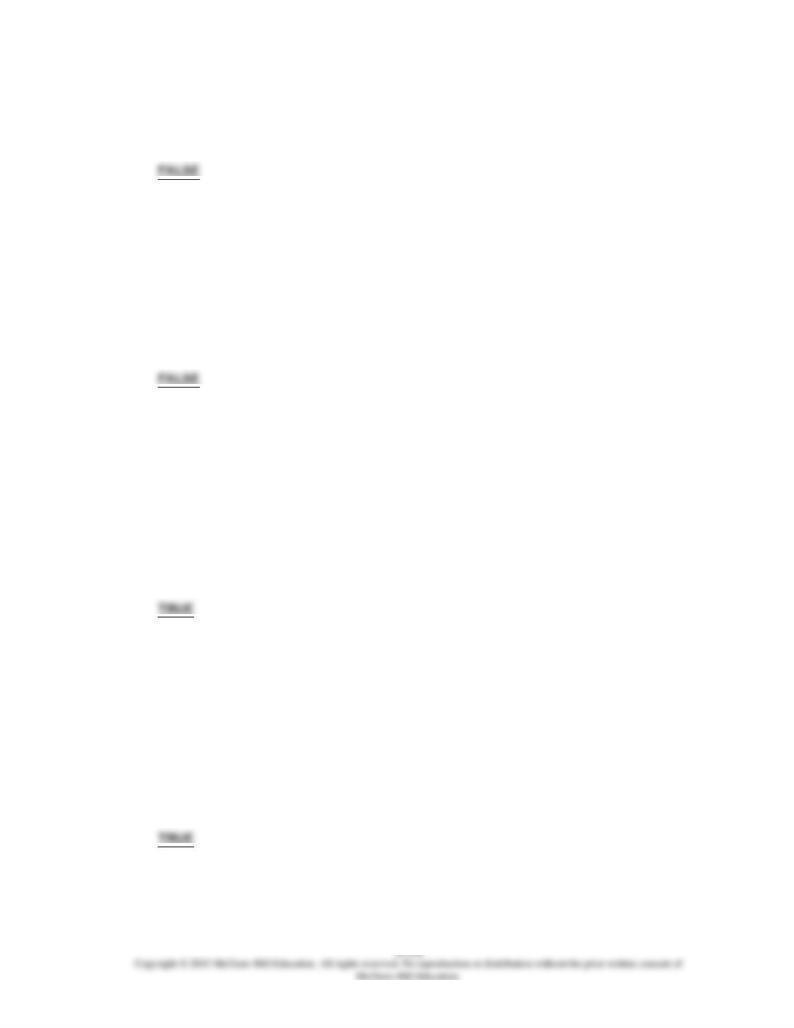
245.
The largest single liability of the Federal Reserve Banks is their outstanding loans to
commercial banks.
AACSB: Reflective Thinking
Accessibility: Keyboard Navigation
Blooms: Remember
Difficulty: 1 Easy
Learning Objective: 34-02 Describe the balance sheet of the Federal Reserve and the meaning of its major items.
Topic: Consolidated balance sheet of the Federal Reserve Banks
246.
An expansionary monetary policy is one that reduces the supply of money.
AACSB: Analytic
Accessibility: Keyboard Navigation
Blooms: Remember
Difficulty: 1 Easy
Learning Objective: 34-05 Identify the mechanisms by which monetary policy affects GDP and the price level.
Topic: Monetary policy, real GDP, and the price level
247.
Changes in the interest rate are more likely to affect investment spending than consumer
spending.
AACSB: Reflective Thinking
Accessibility: Keyboard Navigation
Blooms: Remember
Difficulty: 1 Easy
Learning Objective: 34-05 Identify the mechanisms by which monetary policy affects GDP and the price level.
Topic: Monetary policy, real GDP, and the price level
248.
The job of the Fed in limiting the supply of money may be made more complex if
commercial banks initially have substantial excess reserves.
AACSB: Reflective Thinking
Accessibility: Keyboard Navigation
Blooms: Understand
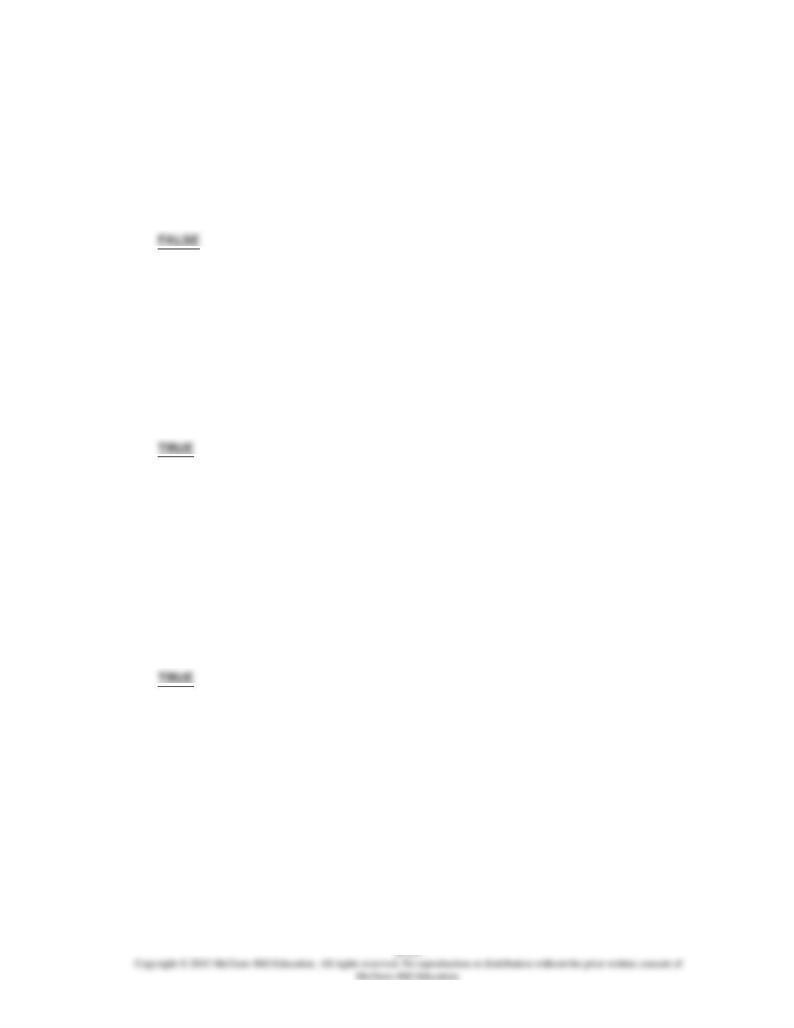
Difficulty: 2 Medium
Learning Objective: 34-06 Explain the effectiveness of monetary policy and its shortcomings.
Topic: Monetary policy: evaluation and issues
249.
When QE2 and Operation Twist were implemented, the Fed suspended its policy of
forward commitment.
AACSB: Reflective Thinking
Accessibility: Keyboard Navigation
Blooms: Remember
Difficulty: 1 Easy
Learning Objective: 34-06 Explain the effectiveness of monetary policy and its shortcomings.
Topic: Monetary policy: evaluation and issues
250.
Operation Twist was aimed at lowering long-term interest rates.
AACSB: Reflective Thinking
Accessibility: Keyboard Navigation
Blooms: Remember
Difficulty: 1 Easy
Learning Objective: 34-06 Explain the effectiveness of monetary policy and its shortcomings.
Topic: Monetary policy: evaluation and issues
251.
Other things equal, an expansionary monetary policy will shift the economy's aggregate
demand curve to the right.
AACSB: Reflective Thinking
Accessibility: Keyboard Navigation
Blooms: Understand
Difficulty: 2 Medium
Learning Objective: 34-05 Identify the mechanisms by which monetary policy affects GDP and the price level.
Topic: Monetary policy, real GDP, and the price level
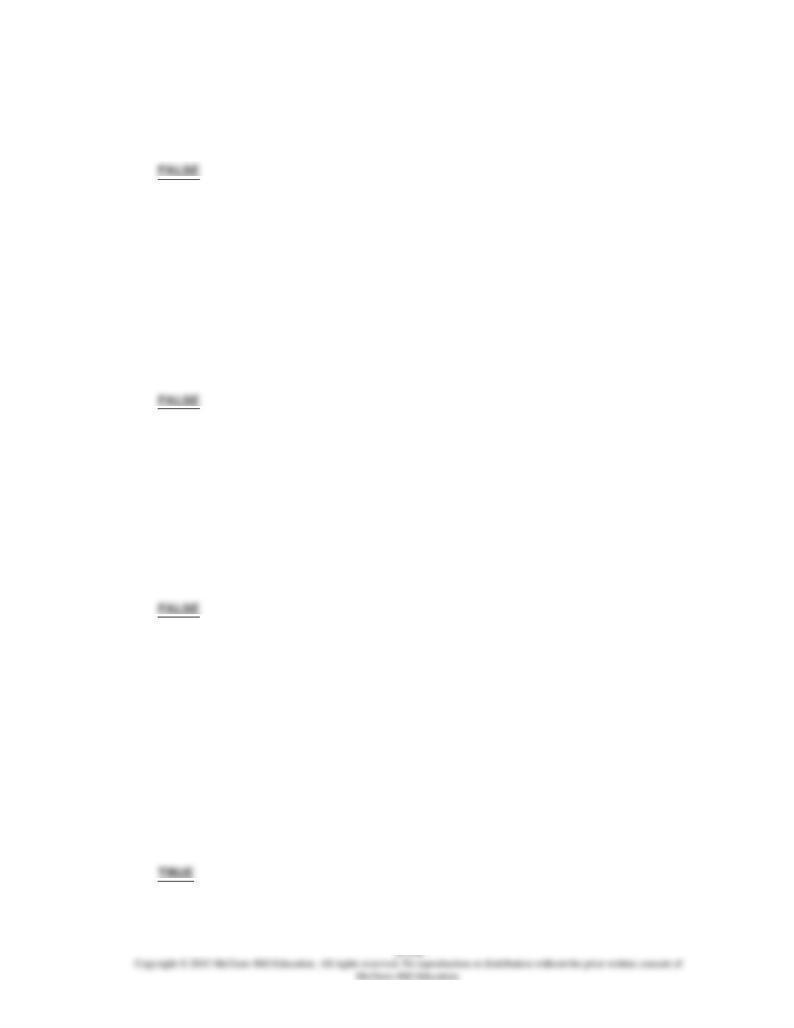
252.
A restrictive monetary policy may be frustrated if the investment-demand curve shifts to
the left.
AACSB: Reflective Thinking
Accessibility: Keyboard Navigation
Blooms: Understand
Difficulty: 2 Medium
Learning Objective: 34-06 Explain the effectiveness of monetary policy and its shortcomings.
Topic: Monetary policy: evaluation and issues
253.
A restrictive monetary policy reduces investment spending and shifts the economy's
aggregate demand curve to the right.
AACSB: Reflective Thinking
Accessibility: Keyboard Navigation
Blooms: Understand
Difficulty: 2 Medium
Learning Objective: 34-05 Identify the mechanisms by which monetary policy affects GDP and the price level.
Topic: Monetary policy, real GDP, and the price level
254.
The Federal Reserve adheres strictly to the Taylor rule when formulating monetary policy.
AACSB: Reflective Thinking
Accessibility: Keyboard Navigation
Blooms: Remember
Difficulty: 1 Easy
Learning Objective: 34-04 Describe the federal funds rate and how the Fed directly influences it.
Learning Objective: 34-06 Explain the effectiveness of monetary policy and its shortcomings.
Topic: Monetary policy: evaluation and issues
Topic: Targeting the federal funds rate
255.
According to the Taylor rule, if real GDP falls by 1 percent below potential GDP, the Fed
should lower the federal funds rate by one-half a percentage point.
AACSB: Reflective Thinking
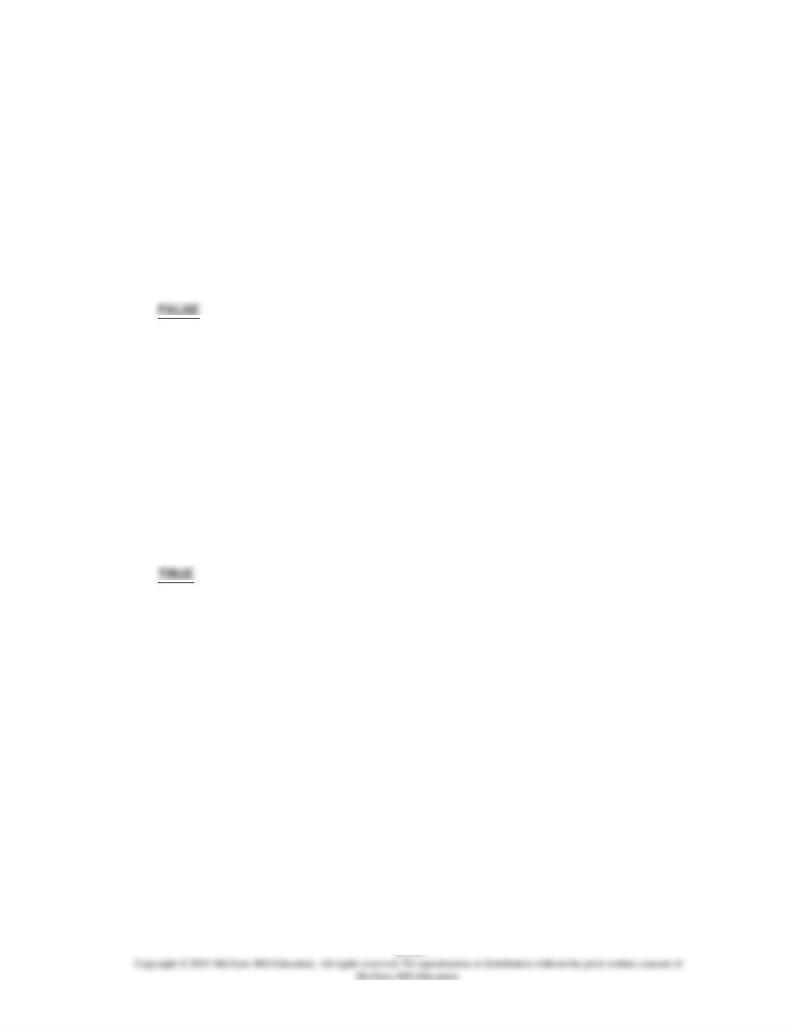
Accessibility: Keyboard Navigation
Blooms: Remember
Difficulty: 1 Easy
Learning Objective: 34-04 Describe the federal funds rate and how the Fed directly influences it.
Learning Objective: 34-06 Explain the effectiveness of monetary policy and its shortcomings.
Topic: Monetary policy: evaluation and issues
Topic: Targeting the federal funds rate
256.
A liquidity trap occurs when the Federal Reserve reduces reserves in the system, choking
off aggregate demand.
AACSB: Reflective Thinking
Accessibility: Keyboard Navigation
Blooms: Remember
Difficulty: 1 Easy
Learning Objective: 34-05 Identify the mechanisms by which monetary policy affects GDP and the price level.
Learning Objective: 34-06 Explain the effectiveness of monetary policy and its shortcomings.
Topic: Monetary policy, real GDP, and the price level
Topic: Monetary policy: evaluation and issues
257.
(Consider This) In March 2010, total bank reserves held at the Fed exceeded total
checkable deposits held by the banks.
AACSB: Reflective Thinking
Accessibility: Keyboard Navigation
Blooms: Remember
Difficulty: 1 Easy
Learning Objective: 34-05 Identify the mechanisms by which monetary policy affects GDP and the price level.
Learning Objective: 34-06 Explain the effectiveness of monetary policy and its shortcomings.
Topic: Monetary policy, real GDP, and the price level
Topic: Monetary policy: evaluation and issues